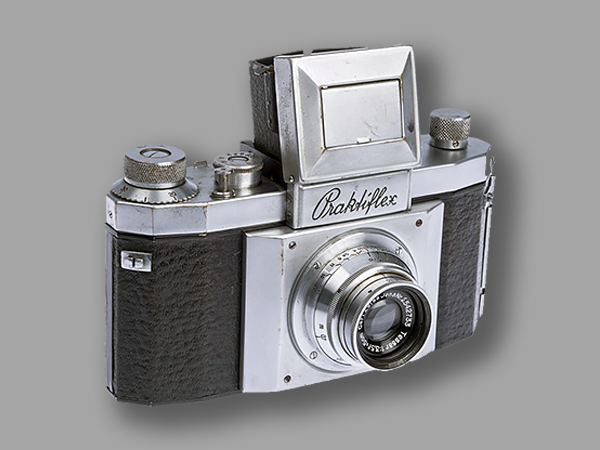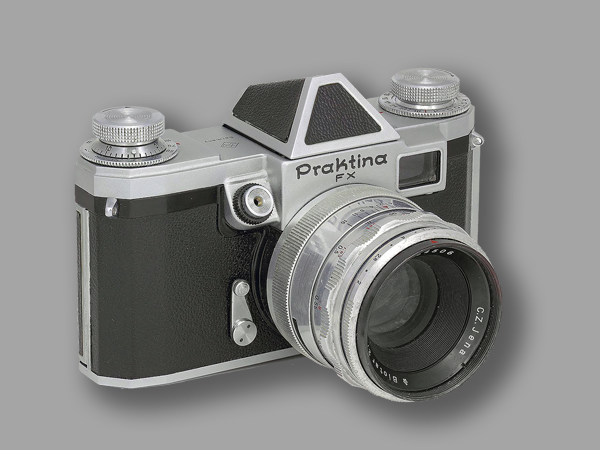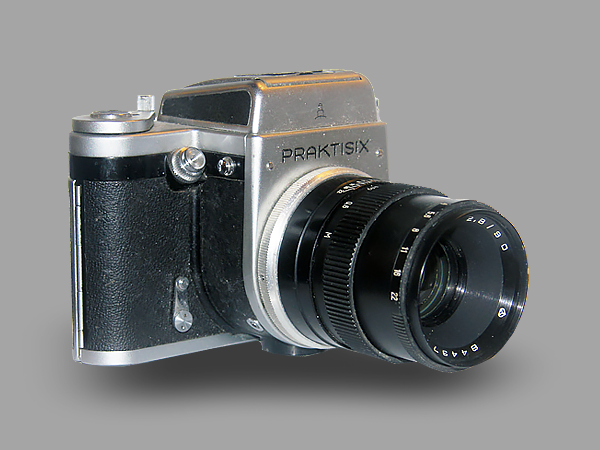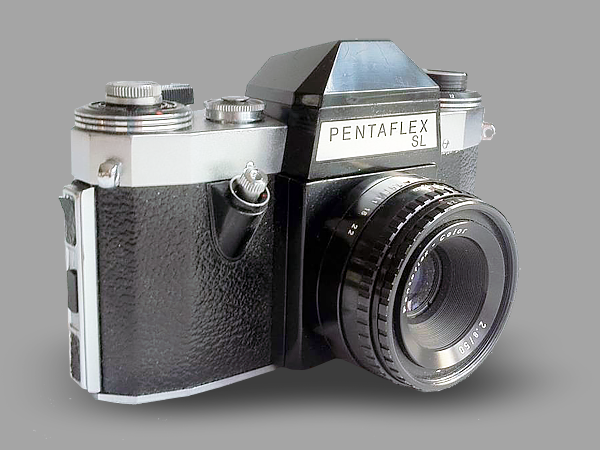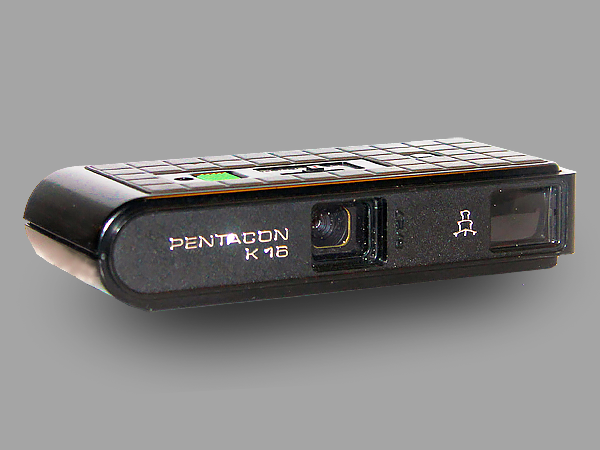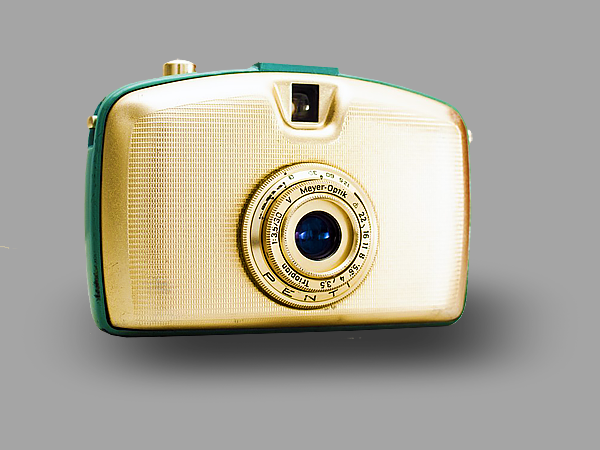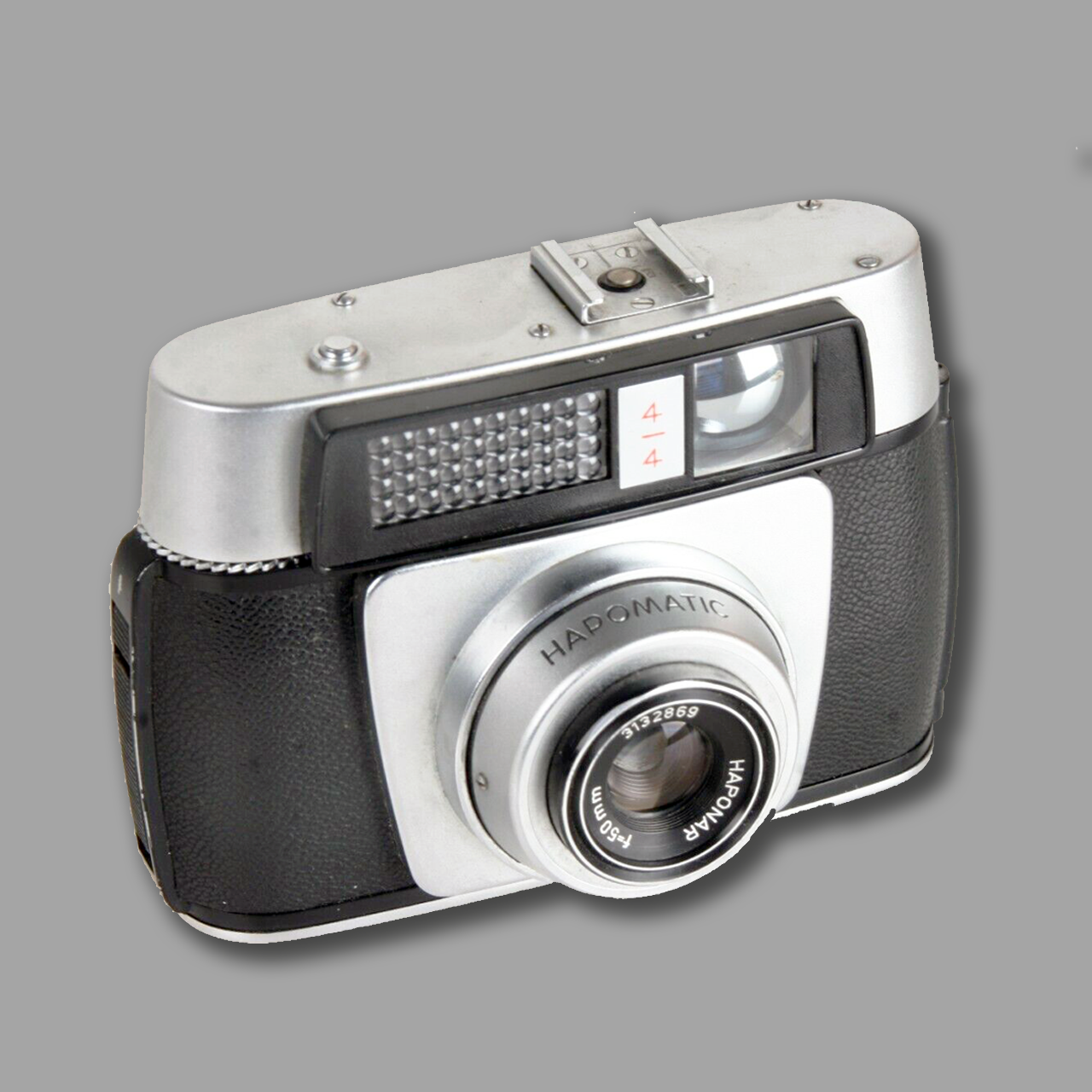Some of the following companies that manufacture(d) photographic material have already passed by in other parts of the site. Here you will find an overview of companies that marketed photographic material in the nineteenth and twentieth centuries. More is usually known about the best known or the most influential companies than about the lesser known ones; therefore they will be discussed more extensively than others.
The emphasis in this part of the site is more on the ups and downs of the company as such, while in other chapters the emphasis was on the product or on the man or woman who founded the company. The order of all companies is alphabetical.
Below are the names of the companies as will be discussed in this or any other chapter. By clicking on a name (so not on the bullet in front of it), you go directly to that part on this page where the manufacturer in question is located. Scrolling is also possible of course, but this service helps you to get to the desired manufacturer in question much faster.
Due to the fact that this introductory page has become much longer than originally planned and desirable due to the large number of manufacturers, we strongly advise you to use the name service below to go to the manufacturer of your choice on this or any subsequent page.
- General Introduction
- ADOX
- Agfa (see also Gevaert)
- Altissa
- Amaloco
- Ansco Camera Co (see also GAF)
- APM/APeM (see also Soho)
Amalgamated Photographic Manufacturers Ltd - Argus Camera Co, Ann Arbor Michigan
- Arsenal (see Kiev-Arsenal)
- Artima Export Ltd (see also Truvox)
- Asahi Pentax
- Bencini
- BOLCo and E Elliott Ltd
(abbrev. for The British Optical Lens Company) - Carl Braun Kamera-Werk
- Canon Inc.
- J.T. Chapman, Manchester
- The Chicago Cluster of Companies
(consisting of 56 companies ) - Chinon
- Concord Camera Corp.
- K.G. Corfield & K.G. Corfield (Sales) Ltd.
- Coronet Camera Company
- Cosina Company, Ltd.
- Dacora
- Dixons
- Durst
- EHO-Altissa company (See Altissa)
- E Elliott Ltd and BOLCo
(abbrev. forThe British Optical Lens Company) - Ellison Kamra
(see also QRS Devry Kamra Company) - ELOP
- Ensign Ltd.
(distribution Company of Houghton-Butcher) - Ernemann-Kamerawerke AG
- Expo Camera Company
- The FED Company
- Ferrania
- Fisher-Price
- Fodor
- Foitzik-Kamerawerke
- C.F. Foth
- Fototecnica
- Franka Kamerawerk –
- Fujica (Camera Division of Fujifilm)
- Fujifilm (brief history)
- Futura
- GAF (see also ANSCO)
(abbrev. for General Aniline & Film) - Louis Gandolfi
- Herbert George Company
- Gevaert Photo-Producten N.V. (see also AGFA)
- Girard et Cie
- GNOME
- GOERZ
- GOMZ (LOMO)
- Graflex (Folmer & Schwing)
- Great Wall Plastics Co
- W. Haking Enterprises Ltd.
- Hanimex
- Hasselblad
- Healthways
- Houghton–Butcher Manufacturing Co (See also Ensign Ltd. and Ross-Ensign Ltd.)
- R.F. Hunter Ltd.
- ICA AG
- Ihagee (Exakta)
- Ilford
- Imperial Camera Corporation
(see the Herbert George Company story ) - Jos-Pe
- Kamera-Werkstätten Guthe & Thorsch
- Keystone
- Kiev Arsenal
- KMZ
- Kochmann
- Kodak USA (incl. Australia, Canada, France, Germany & the UK)
- Konica-Minolta (Konishiroku)
(see also Minolta) - Kowa
- Krügener
- Kürbi & Niggeloh (Bilora)
- Kyocera (Yashica, Contax)
- Lancaster
- Leitz
- Lensless Camera Manufacturing Company
- Linhof
- Lipca (see also Richter-Tharandt)
- LOMO (see GOMZ)
- Loreo
- Mamiya
- Meopta Optotechnica
- Mimosa AG
- Minolta (see also Konica-Minolta)
- Minox Company
- Miranda (Orion)
- MMZ-BeLomo
- Motodori (Condor)
- Dr. August Nagel Kamera Werke
- Neidig Kamerawerk
- Nemrod-Metzeler (See Healthways)
- Nettel
- Nikon Company
- Nimslo Corporation (see also Nishika)
- Nishika Optical Systems (see also Nimslo)
- Noblex (See also K-W Guthe & Thorsch)
- Olympus Company
- ORION (see Miranda)
- ORWO
- Ottico Meccanica Italiana (OMI)
- Paterson Products Ltd.
- VEB Pentacon Dresden
- Pentax (See Asahi Pentax)
- Petri
- Photavit (Bolta)
- Plaubel
- Polaroid
- Photo Porst
- Karl Pouva – VEB Fototechnik Freital (see also Woldemar Beier)
- Purma Cameras Ltd.
- QRS Devry Kamra Company (see also Ellison Kamra)
- Foto-Quelle
- Rectaflex
- VEB Rheinmetall Büromaschinenwerk
- Richter-Tharandt (see also Lipca)
- Ricoh
- Rollei Germany
- Rollei Singapore
- Ross-Ensign
(continuation from Ensign Ltd.) - Ro-To Company
- Sea&Sea-Sunpak
- Shanghai Seagull
- Sida-Fotofex
- Sigma
- Soho Ltd (see also APM)
- Standard Cameras
- Steinheil
- Stenopeika
- Thornton-Pickard
- Topcon (Tōkyō Kōgaku)
- Tougodo Company
- Traid Corporation
- TRUVOX (see also Artima Export)
- Tura AG
- Universal Camera Corp.
- Vivitar
- Voigtländer
- Vredeborch
- Welta
- Werra (C. Zeiss Jena)
- Wirgin
- Kamera-Fabrik Woldemar Beier (see also Karl Pouva)
- Hermann Wolf GmbH
- Wünsche
- Yashica (see also Kyocera)
- Zeiss Ikon AG
- Zion
- Zunow (Teikoku Kōgaku)
FOUNDER: Donald Paterson
COMPANY NAMES:
1948: Part of R.F. Hunter Ltd.; 1963 (?): Paterson Products Ltd.;
COMPANY ADDRESSES:
1948: ‘Celfix House’, Gray’s Inn Road, London, WC; 19??: 2 Malthouse Road, Tipton, West Midlands, UK. DY4 9AE;
Paterson is best known for its high quality darkroom equipment which it manufactures in the UK. In the late 1980s it also took over the manufacture of Benbo tripods which it has continued to develop. Paterson now also has a comprehensive range of studio lighting units which are manufactured in their UK factory.
 In the 1940s Donald Paterson was a very busy man. He held professional qualifications as a Dental Surgeon and Lawyer (Donald’s father was also a Lawyer). In his “spare” time Donald was a keen photographer, gaining an FRPS and regularly went on photo’ safaris in Kenya.
In the 1940s Donald Paterson was a very busy man. He held professional qualifications as a Dental Surgeon and Lawyer (Donald’s father was also a Lawyer). In his “spare” time Donald was a keen photographer, gaining an FRPS and regularly went on photo’ safaris in Kenya.
“It was whilst on safari that Donald photographed a snake slowly swallowing a rabbit that it had caught and marvelled at the way the snake’s backward facing fangs prevented the squirming prey escaping. That evening while recalling the encounter he realised the concept could be used to make a self loading film spiral, with the “fangs” gripping the film.
Some months later he showed his design to his firm friend Cyril Hunter of R.F. Hunter Ltd. in London and Hunter immediately ordered 500 reels. The rest, as they say, is history and the seeds of the Paterson company were sown. Paterson’s connection with R.F. Hunter was from then on as an inventor of (amateur) home developing and printing equipment, which he marketed through R.F. Hunter under the brand name of Paterson Products.
Late in 1948 Donald patented the spiral and 50 years on, the only major design change is that the “fangs” have been replaced by stainless steel ball-bearings.”
Paterson products appeared in 1949 (the company was started in 1948). Their first product was the ’35’ developing tank. This tank introduced the patented ratchet mechanism to grip and move the 35 mm film into the spool. The two sides of the spool had a small tooth within the spiral which gripped the sprocket holes, the film was was loaded by rotating each side in turn. Agitation was by rotating the spool.
Further developments of the developing tank
The Major model for roll-films (127, 120/620, 116/616) appeared in 1950. The teeth of the original model were replaced by ball bearings working in a small triangular slot forming an inclined plane, the ball alternately gripped and released the film.
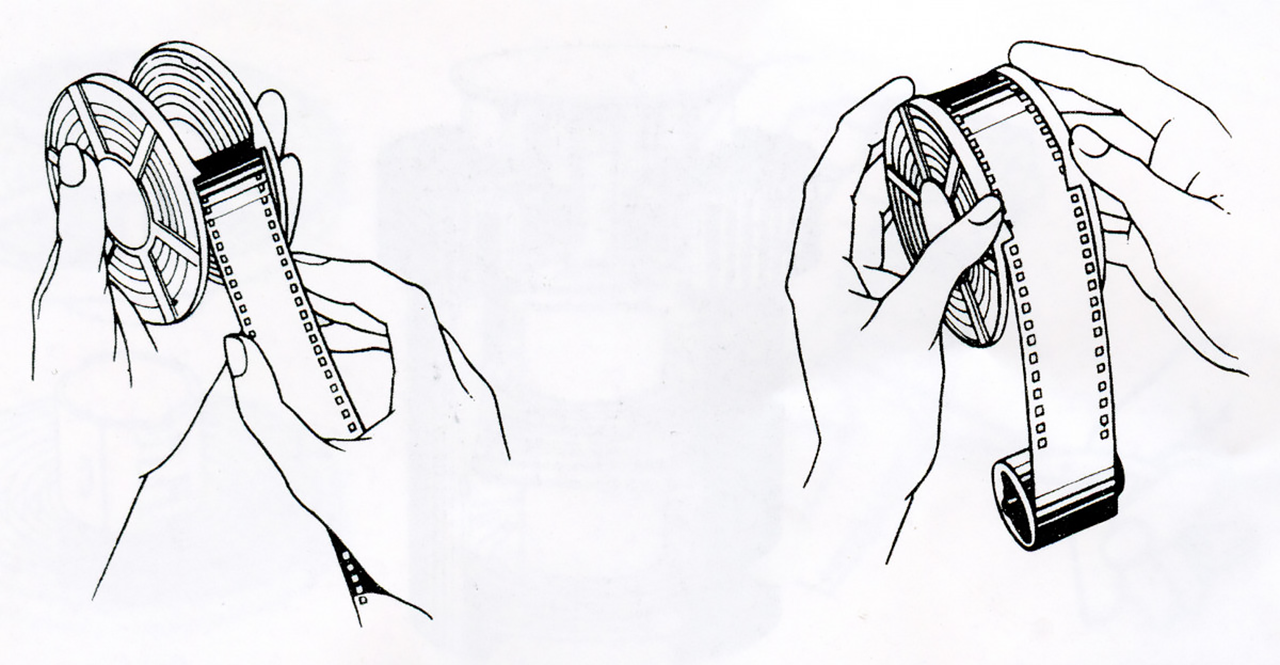
The core holding the spool in the tank was able to move providing an up-and-down agitation as well as rotating the spool (described as two-way agitation in some advertisements). The up-and-down movement was also fitted to the ’35’ tank around this time.
The original ’35’ tank was replaced by the Model II in 1955, this had ‘inversion agitation’, central pouring and transparent spools. It was also available in a triple size for three films.
The Universal II with ‘inversion agitation’ was introduced in 1956. These tanks could be fitted with an economiser to save solution when developing short films such as 120, it comprised a plastic cylinder that fitted over the central core of the tank and simply took up space.
The Universal 3 was introduced around 1963 for 16 mm still as well as 35 and 120/620. A Professional 35 model II for six films was advertised in the mid 1960s. System 4 models were introduced in 1968.
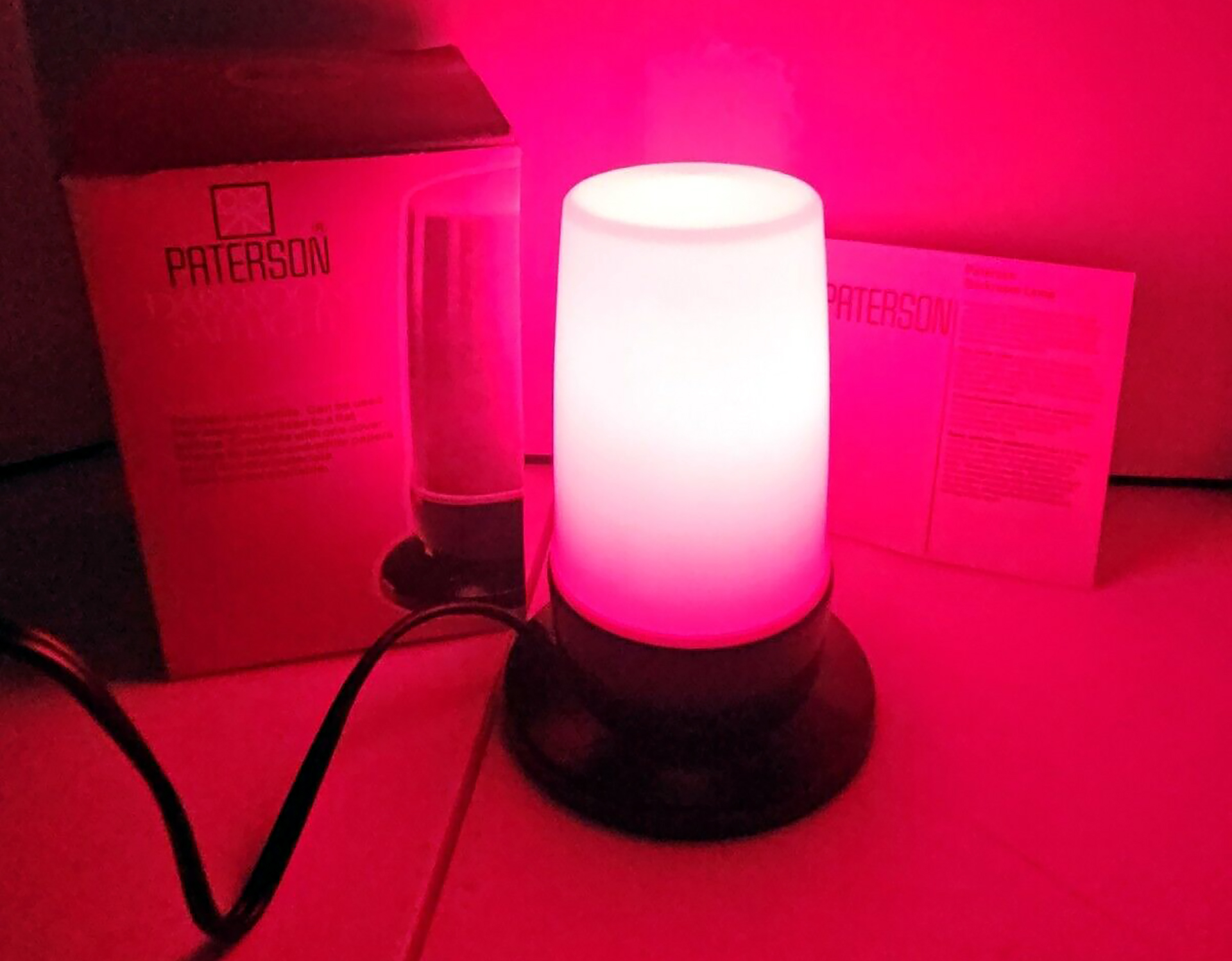
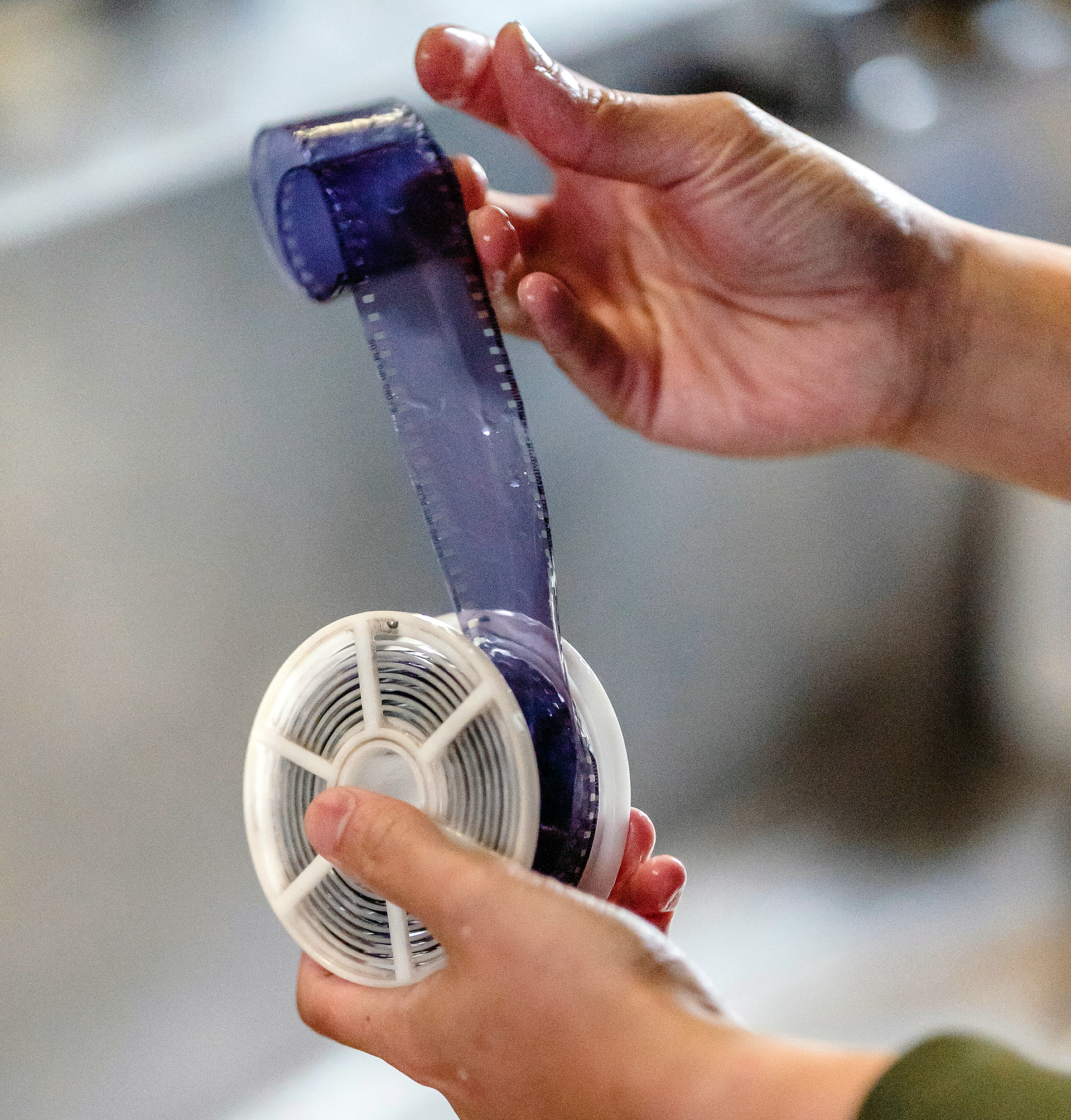
Trading under the Paterson name
The phrase ‘Paterson Products’ was used by R F Hunter to collectively refer to the growing range of Paterson darkroom (and slide viewing) equipment from the mid-1950s.
Paterson first started to be distinguished as the manufacturer of an equipment range in its own right when the ‘soon to become famous’ logo first appeared, possibly early 1963. By December 1965, Paterson items bear the label ‘Paterson Product’ made in England for R.F. Hunter Ltd, London.
Paterson introduced its own comprehensive range of monochrome chemistry, starting with Acutol, a fine grain, high acutance, developer in autumn 1963. It was invented by Geoffrey. W Crawley. Sold in screw-capped 220cc (7.5 fluid ounce) bottles, requiring to be diluted 1:6. As this chemistry acquired a high reputation and the range extended, it became known collectively as the Paterson ‘Acu’ chemistry range.
Exactly when Paterson became a Ltd company, trading under the name Paterson Products Ltd, is not yet certain. It may have been as early as 1963, when the Paterson logo first appeared, but was certainly the case by late 1967. If the latter, then it may be that Paterson Products Ltd was formed out of R.F. Hunter Ltd when Johnsons of Hendon took over the distribution of Paterson equipment.
Sadly, Donald Paterson died in 1975 while attempting to save a young boy from drowning.
In common with other photographic equipment manufacturers, Paterson have had to reorganise several times over the years in order to survive. With its original core products being for the amateur darkroom, Paterson were especially susceptible to the change-over of the amateur black & white home darkroom hobbyist to using commercially produced colour prints.
Add to this the general impact felt by the ‘silver based’ photographic industry to the advent of digital photography, it is commendable that Paterson have survived at all.
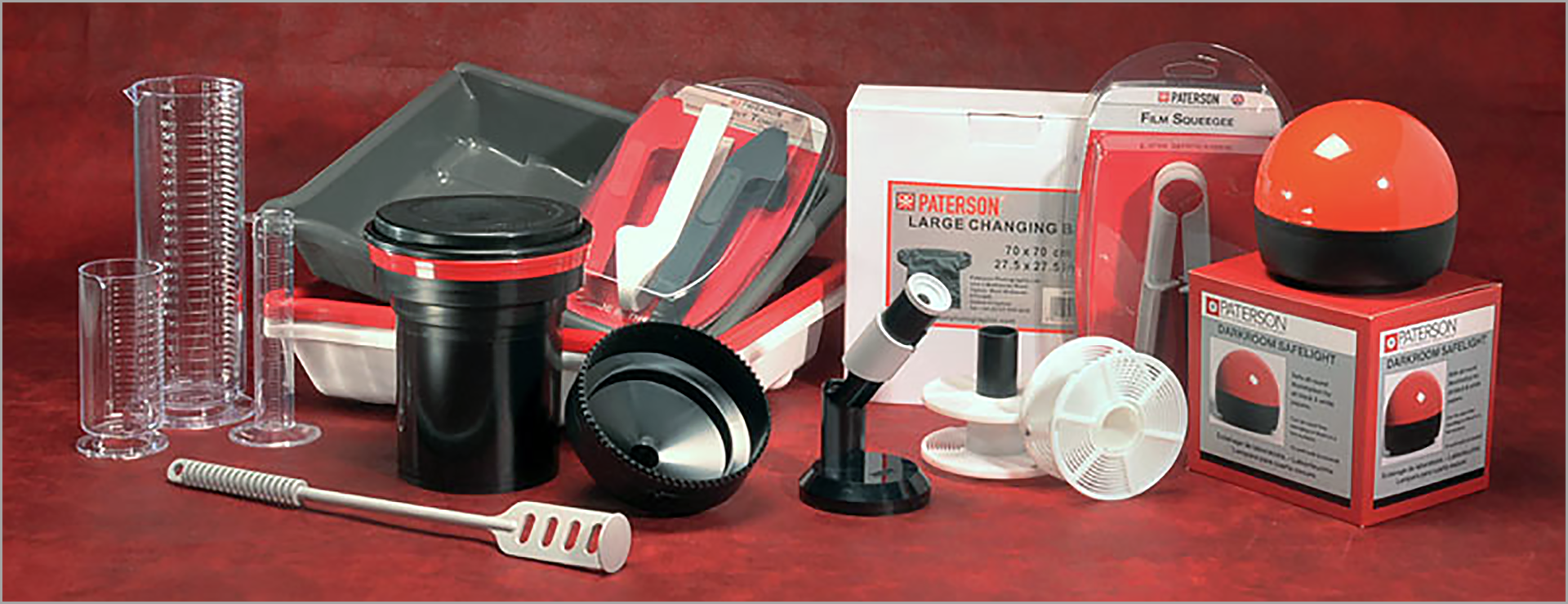
The name Paterson still exists in the world of photographic equipment supply. They still offer a wide range of photographic darkroom products. Paterson have specialised in the manufacture and supply of equipment for the manual processing of silver based photographic film and paper. Paterson darkroom products are in use all over the world in schools, colleges, and professional and enthusiast’s darkrooms.
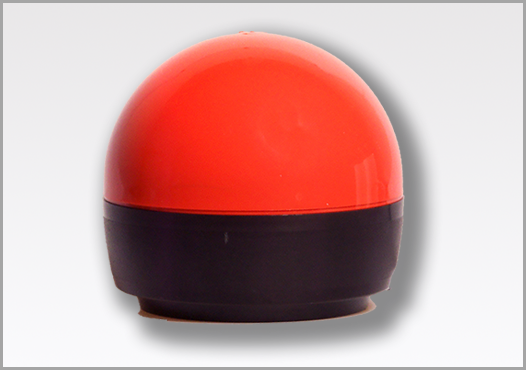
Paterson Darkroom Safelight
The Paterson Darkroom Safelight complete with its Red Dome can be safely used with all current types of silver based darkroom printing papers. It is also safe for dental X-Ray film.
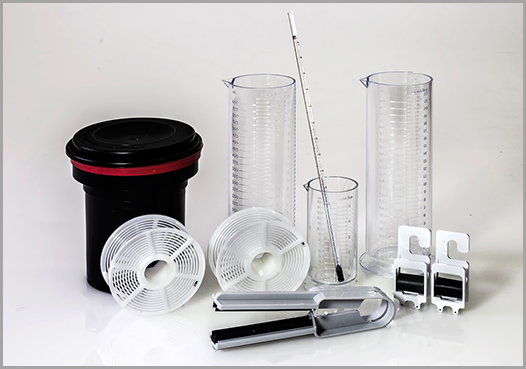
Paterson Film Processing Kit
The kit contains everything required to process up to two 35mm films
or one 120 roll film at a time. Ideal for those photographers who wish to capture their images on film and then either have them printed commercially or make their prints digitally after scanning their negatives.
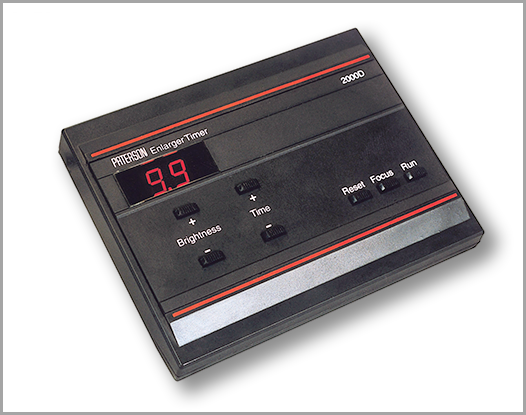
Paterson 2000D Enlarger Timer
Mains operated digital timer for very accurate exposure timing when using an enlarger. The timer can be set in 0.1 second increments from 0.1 to 9.9 seconds, or in one second increments from 10 to 99 seconds. The display brightness can be adjusted to suit individual requirements. The timer is available in both 230 and 110 volt versions.
Darkroom
The comprehensive range of products includes film developing tanks, measuring graduates, enlarger accessories, film and print washing equipment and 35mm and roll film enlargers.
- Darkroom Equipment
- Photographic Equipment
- Darkroom Hardware
- Photography Hardware
- Darkroom Development
- Traditional Photography
- Analogue Photography
- Film Development
- Film Processing
Tripods
In the late 80s it also took over the manufacture of Benbo Tripods and has continued to develop this range of tripods, beloved by both Landscape and Natural History Photographers.
Stability linked to versatility are the prime considerations when purchasing a tripod. For 35 years BENBO has offered photographers a unique combination of these factors whilst offering a UK based manufacturing and customer service experience.
- Tripod Stands
- Ball & Socket Heads
- Monopod
Lighting
Paterson has re-entered the Studio Lighting market with a comprehensive range of Continuous Lighting units manufactured in our own UK factory.
The simple cost effective answer to studio lighting. The Paterson Daylight range offers a choice of 5400K daylight energy saving lamps that can be seamlessly mixed with natural daylight when required. Exposure metering is simple – requiring only the use of the camera’s built in metering system.
A complete range of light modifiers are available to fit the basic head. These include Softboxes, Reflectors, Snoots and Barndoors – enabling the photographer to create a whole range of lighting effects.
- Continuous Lighting
- Studio Lighting
- Lighting Heads
- SLED Lamp
- LED
- Light Diffusion
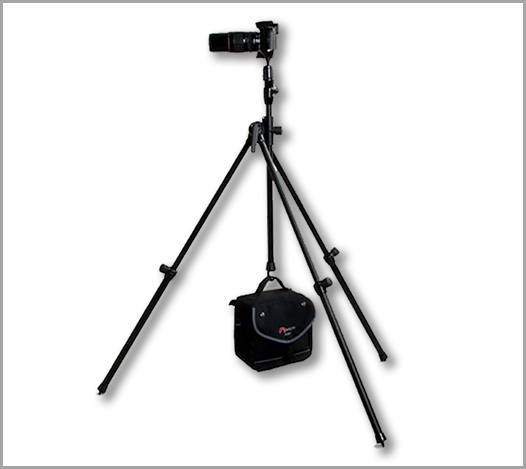
Paterson Benbo Trekker MK3 Tripod
This Trekker Tripod Mk3 from Benbo is a lightweight version of the Classic No1 tripod and is ideal for use where the tripod needs to be carried a greater distance. Features tubular aluminium legs which offers the best combination of weight and rigidity possible. A hook at the bottom of the centre column allows a camera bag or sandbag to be attached when greater stability is required.
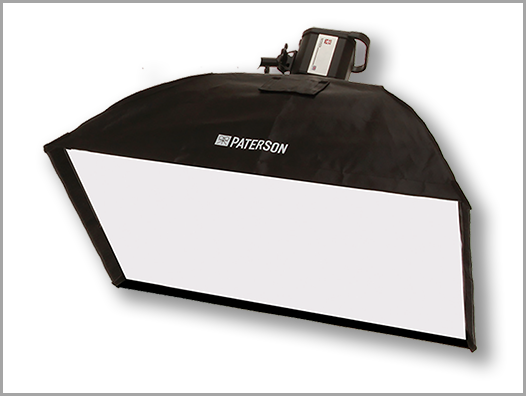
Heat Resistant Softbox
Heat resistant softboxes for flash and all heat generating continuous light sources.
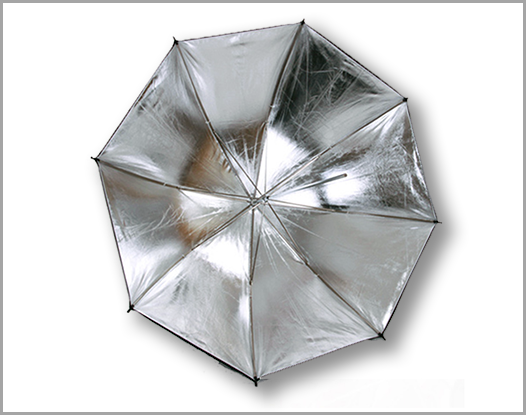
Silver Umbrella
A silver reflective umbrella is used to bounce light off it, onto the subject. Due to the reflective quality of the silver surface, there is less of a light loss than with a white reflective umbrella. However, the silver light is arguably harsher and more ‘edgy’ compared to the light returned from a white reflective umbrella.
FOUNDER: MERGER OF VEB Kamera- und Kinowerke
VEB PENTACON
COMPANY NAMES:
1959: VEB Kamera- und Kinowerke Dresden = Merger of VEB Kinowerke Dresden,
VEB Altissa-Camera-Werke,
VEB Kamera-Werke Niedersedlitz,
VEB Aspecta Dresden,
VEB Welta-Kamera-Werke Freital/Sa.; 1964: Renamed as VEB Pentacon Dresden; 1968: VEB Feinoptisches Werk Görlitz was integrated and became Kombinat VEB Pentacon Dresden; 1985: Kombinat VEB Pentacon was incorporated into the Kombinat VEB Carl Zeiss Jena; 1990: Liquidation began on October 2; 1991: production ceased on June 30; 1990: The company was re-established as Pentacon GmbH, and named as Jos. Schneider Feinwerktechnik GmbH & Co. KG incorporated into Mandermans Jos. Schneider Group; 2015: Pentacon GmbH ceased the business with Praktica photo products; 2022: Pentacon factory in Dresden closed.
COMPANY ADDRESSES IN DRESDEN:
The combine VEB Pentacon employed about 6000 employees (+3000 from suppliers) and consisted of several objects: Schandauer Straße 74/76 – Main plant; Junghansstraße 1-3 – The stamping, toolmaking, electroplating and finishing departments were housed here; Klagenfurter Straße 52 – Montage of the Pentacon Six camera; Bärensteiner Straße – Montage of the Praktica LLC; Schandauer Straße 46 – Pentacon clubhouse and combine director and another building for the management, administration, company academy and cooperation; Edgar-André-Straße 56 – warehouse, research and development; Mügelner Straße 40 – company vocational school; Helfenberger Grund Nr. 8 – Formerly a chemical factory in Helfenberg. Polytechnic classes (UTP and ESP) and assembly; Bodenbacher Straße 97 – advertising and trade fairs; Pestalozzistraße 12 – Polytechnic lessons (subordinate to the company vocational school). assembly of the 35mm slide projector Aspectar; Blasewitzer Strasse 39 – Formerly Ihagee. This is where the “Exakta” and “Exa” series of 35mm cameras were manufactured; Bautzner Straße – prefabrication in the Cottbus prison, departments: stamping, deburring, drilling and washing of die-cast parts; Dornblüthstraße 31 – data center for Pentacon; Enderstraße 92 – Last new building by Pentacon; Blasewitzer Straße 60 – Procurement of materials for chemistry.
The name Pentacon is derived from the brand Contax of Zeiss Ikon Kamerawerke in Dresden and Pentagon, as a Pentaprism for Single-Lens Reflex (SLR) cameras was for the first time developed in Dresden. The cross section of this prism has a pentagonal shape. Pentacon is best known for producing the SLR cameras of the Praktica-series as well as the medium format camera Pentacon Six, the Pentacon Super and various cameras of the Exa series. Pentacon also produced slide projectors.
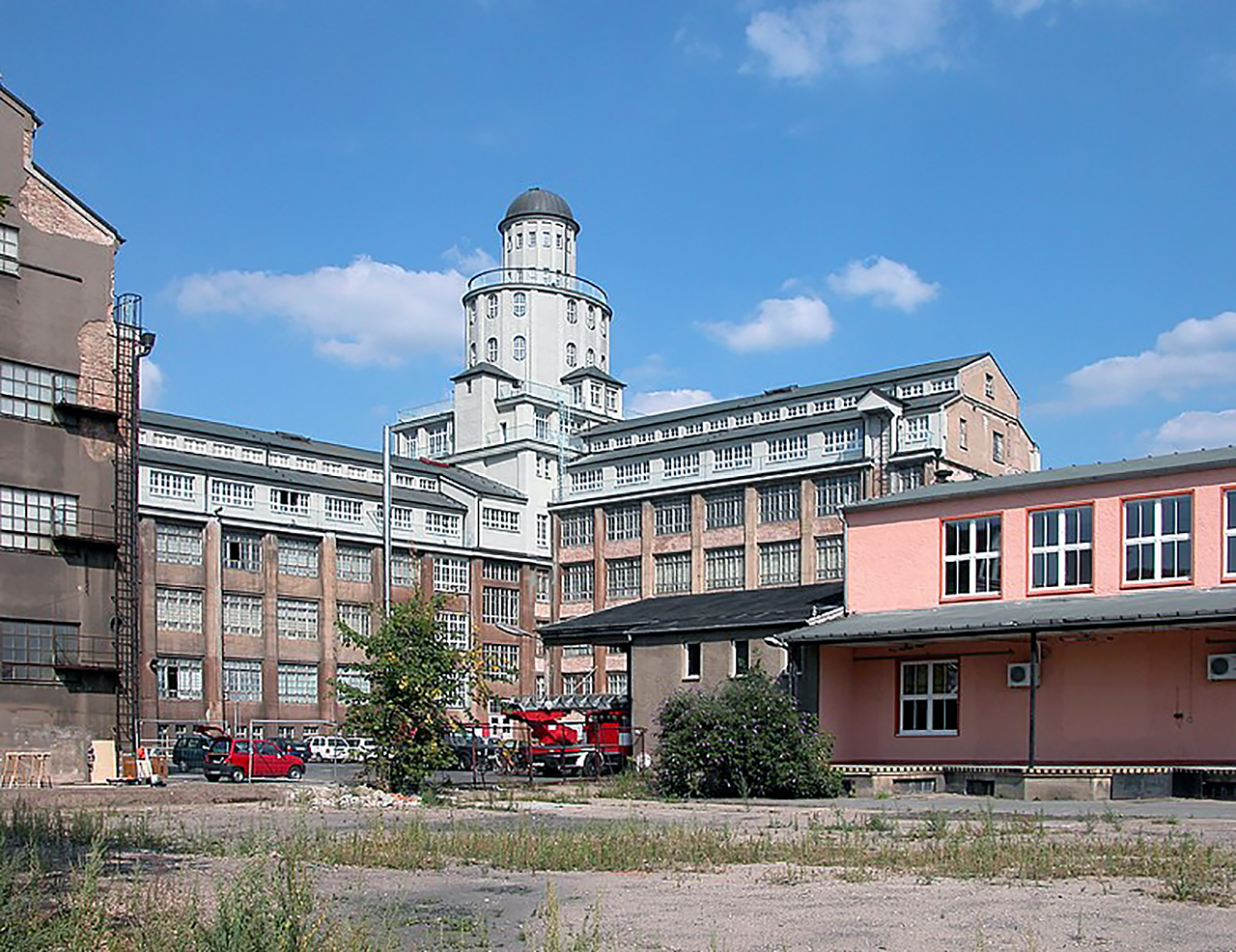
At 48 meters high, the Ernemann Tower is one of the landmarks of Striesen and is an integral part of the history of Dresden as a location for the camera industry. The tower building was built in 1923 at Schandauer Straße 48/50. Since 1951 an outline drawing of the tower has served as a logo for many cameras and projectors and since 1964 a graphically reduced version as a motif for the VEB Pentacon. This photo dates back to when Pentacon was already liquidated.
After the German unification
After German reunification in 1990 Pentacon, as with most East German companies, came to be possessed by the Treuhandanstalt (the federal board concerned with the privatisation of East German companies) and was selected for closure instead of sale.
It was deemed that company was grossly inefficient, employing six thousand staff when it could have sufficed with one thousand, and selling its cameras at a loss. Liquidation began on October 2, 1990 (one day before official reunification), and production ceased on June 30, 1991. By then it had shed nearly three thousand employees to retain a total of 3331 – the next day it had just 232 who had to finish liquidation.
The only investor who had been interested in saving Pentacon was Heinrich Mandermann, the man who once had saved the lens maker Schneider-Kreuznach and who also was the co-founder of the camera trader Beroflex.
But he waited until after liquidation to buy parts of the company from the Treuhand – thus getting them cheaper, including one of the modern Pentacon buildings which once served for military production. This part of Pentacon, now the new Pentacon GmbH, is still located in Dresden, and included a service office for older cameras, camera production being outsourced to South Korea.
The camera and lens brands represented by the new Pentacon were Praktica, Exakta, and Schneider Dresden, the enterprise employing about 150. Among its own products were amazing scanner cameras.
Other parts of the former Pentacon company was sold to Noble and today belong to Kamera Werk Dresden, which, among other products, manufacture panoramic cameras under the Noblex brand, and cameras for industrial use under the Loglux brand.
Pentacon also produces scanner cameras. The latest model, the Scan 7000, was introduced at the Photokina 2010 in Cologne, Germany. The Scan 7000 is operated with SilverFast and has a resolution of 20.000 × 20.000 pixels.
As of 30th June 2015 the Pentacon GmbH ceased the business with Praktica photo products. There is also no more production of photo-optical products. Today the company is a die casting and turnery plant with a precision measurement laboratory.
In 1959 several Dresden camera manufacturers, among them VEB Kinowerke Dresden (former East German Zeiss Ikon), Kamera Werke Niedersedlitz, Belca, Altissa, Welta, and cine film specialist Aspecta, were joined to create Volkseigener Betrieb Kamera- und Kinowerke Dresden, which was renamed in 1964 to VEB Pentacon Dresden.
Originally Pentacon was the export model name for the Contax D, since the use of the name Contax had been prohibited for the East German company VEB Zeiss Ikon. The new name had been coined from Pentaprism and Contax. The company produced its own shutters. Known is the Pentacon-Prestor leaf shutter.
In 1968 VEB Pentacon Dresden became Kombinat VEB Pentacon Dresden, being merged with Mentor, Certo, Ihagee, Meyer, the camera industry of Freital and VEB Feinoptisches Werk Görlitz, thus becoming a group comprising nearly the whole East-German photography-related industry except film maker Orwo. Accordingly, the former Meyer-Optik Görlitz lenses were now renamed to ”Pentacon“.
Then the SLR production of VEB Pentacon essentially concentrated on the Praktica SLRs, but also comprised the Pentina, the Exa Ic and the Exakta 66.
On January 1, 1985 the Kombinat VEB Pentacon was incorporated into the Kombinat VEB Carl Zeiss Jena. The Kombinat VEB Pentacon was divided in three parts now (VEB Pentacon Dresden, VEB Feinoptisches Werk Görlitz and VEB Kamerafabrik Freital) working as independent companies under the central management in Jena.
It was planned together with the incorporation, research and development and technical potential of the former Kombinat VEB Pentacon would be temporarily reduced to 60% by 1986 and these resources would be exclusively devoted to military production; film development machines and laboratory equipment for big laboratories would be produced in expense of the SLR production; SLR production would be reduced to 300 000 per year, export to non-socialist countries would be reduced to 50% of the production (from 77% in 1984), while export to Eastern Block countries and inland deliveries would be raised.
SLR production in Dresden was rapidly decreasing from 1987 on, what was caused by greater amount of labour necessary for assembling cameras of the Praktica B and BX series, as well as by preparations for incoming military production.
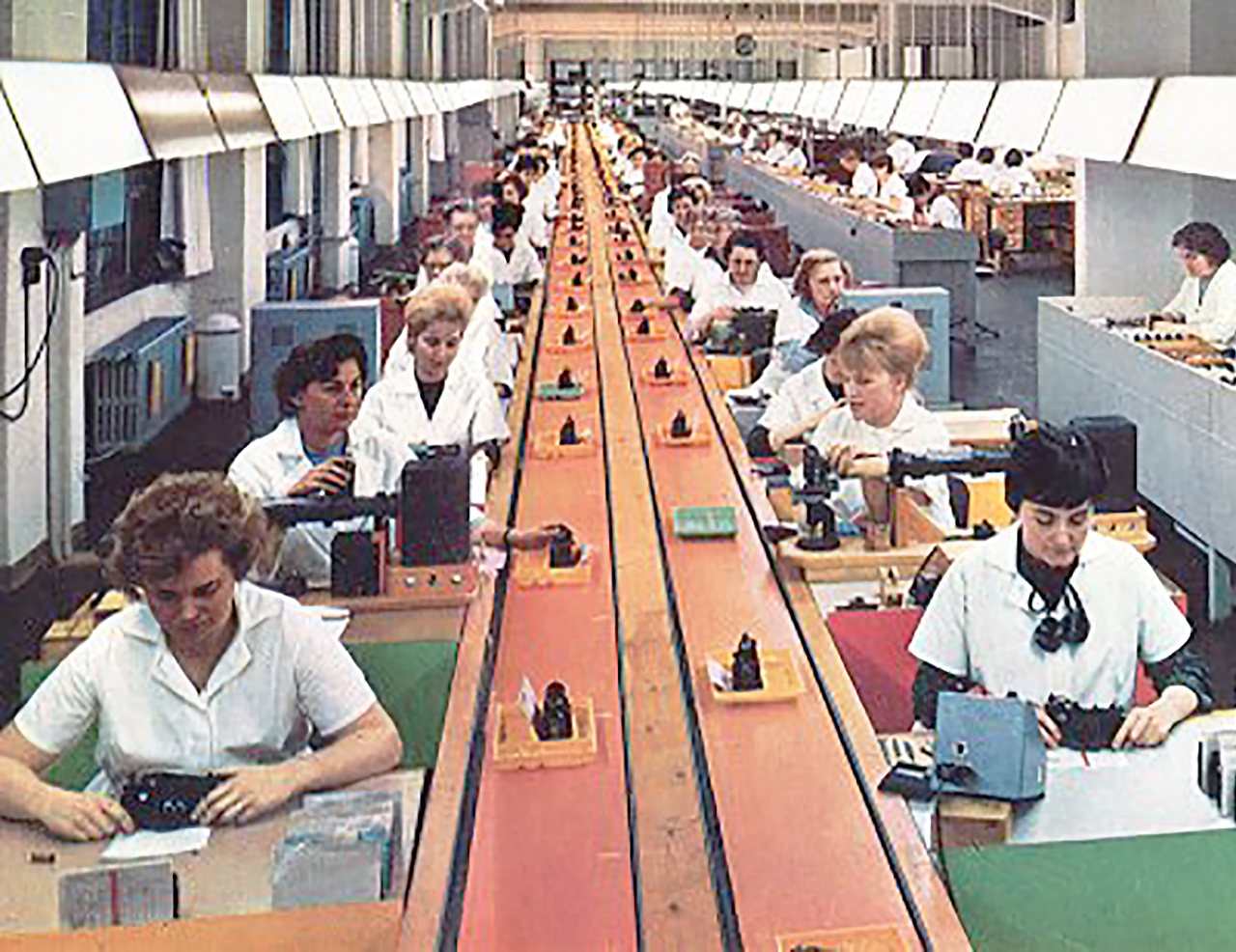
Assembly line work at VEB Pentacon Dresden 1965. The employees assemble the “Praktica nova” and “Praktica nova b”. Every 90 seconds, a camera should leave the line.
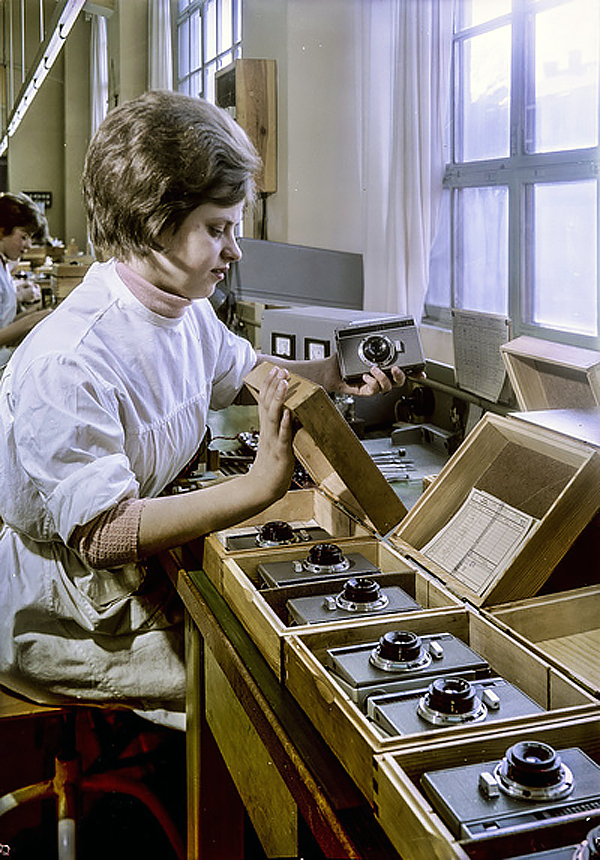
Final check
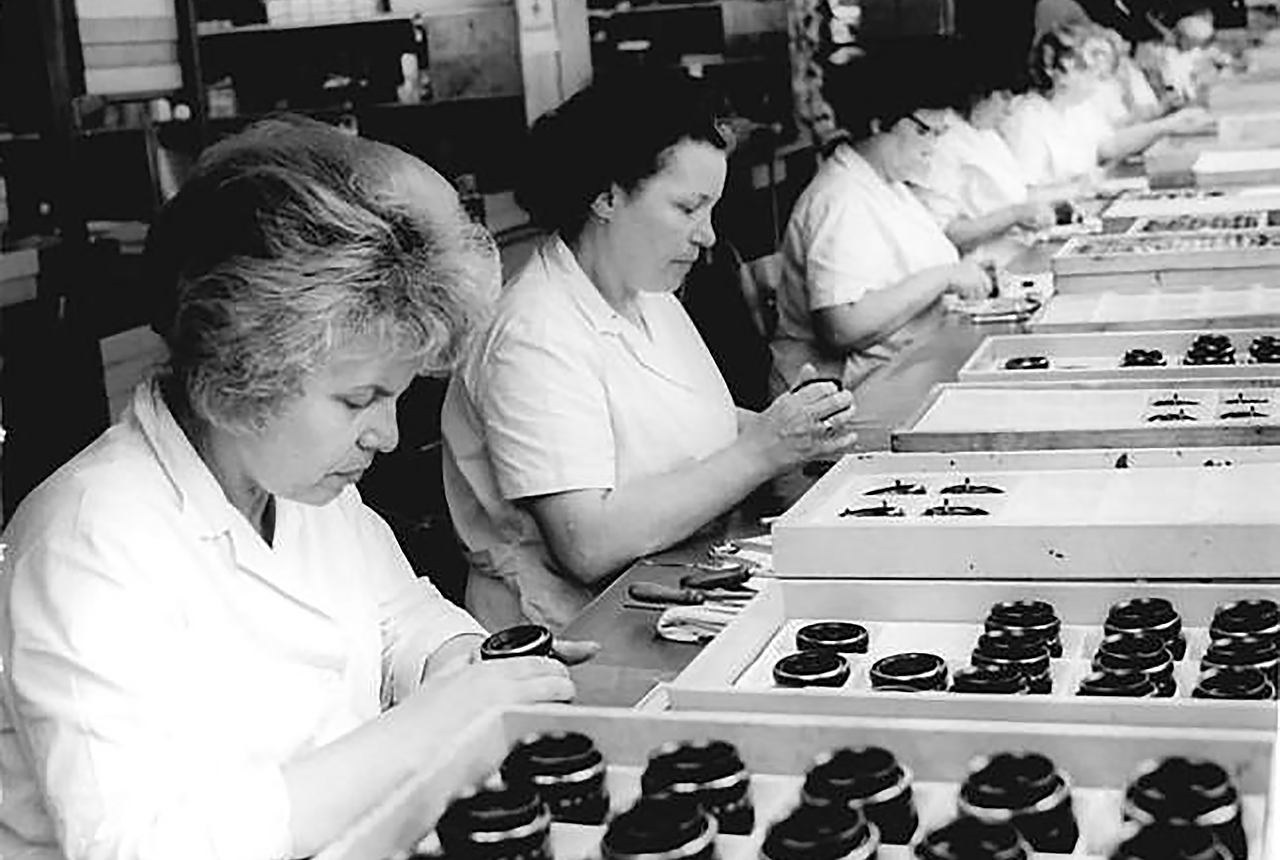
VEB Pentacon, Feinoptikes Werk Görlitz, assembly of Oreston lenses (“Meyer-Optik”) by Polish guest workers.
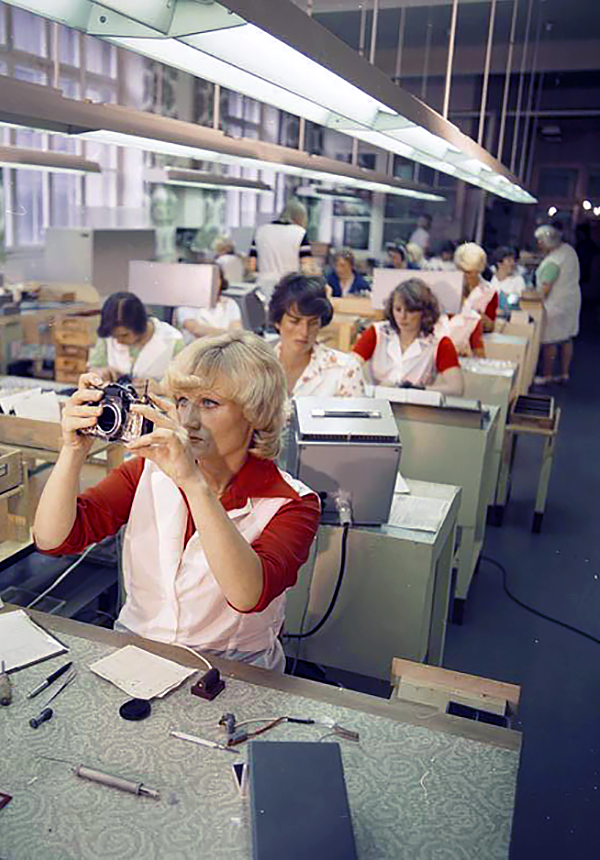
Functional check
comprehensive survey of PENTACON & Praktica cameras
In addition to the Praktica and Pentacon series, the following cameras were manufactured:
PENTONA, Pentacon F, PENTACON great and the Large format camera Pentacon Globica II. Added to that the Beirette series from VEB camera factory, Freital near Dresden.
The new Pentacon continued production of the Praktica BMS until 1992, Practica Bx20 until 1993, and Praktica BX20S until 2001. Since then it just produces digital SLR scanner cameras.
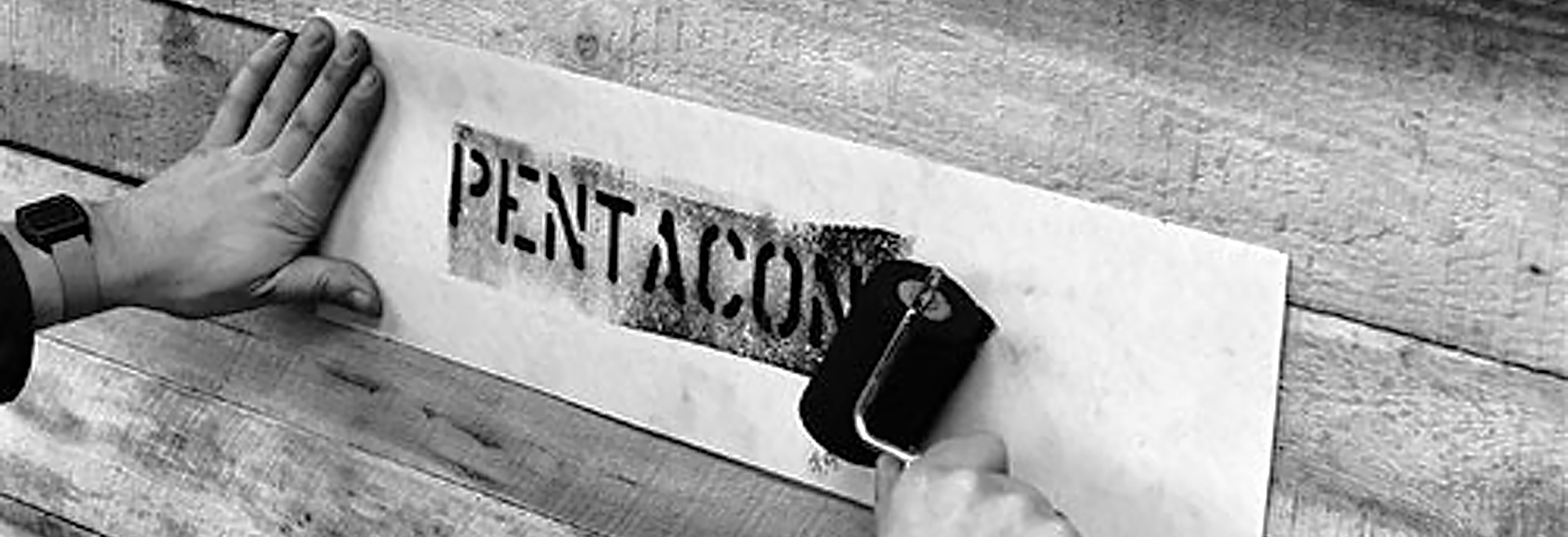
35mm SLR,
focal plane shutter
Exa series; taken over by the incorporated Ihagee
- Exa Ic
Pentacon Super
- Pentacon Super
Praktica IV / V
- Praktica IV
- Praktica IV B
- Praktica IV M
- Praktica IV BM
- Praktica IV F
- Praktica IV FB
- Praktica V F
- Praktica V FB
Praktica nova
- Praktica nova
- Praktica nova B
- Praktica mat
- Pentaflex SL (=Porst reflex FX 3)
Praktica PL nova
- Praktica PL Nova I (= Hanimex Praktica Nova I)
- Praktica PL Nova IB (= Pentor IB, Porst FX4,Hanimex PrakticaNovaIB)
- Praktica PL electronic
- Praktica super TL (= Hanimex Praktica super TL, Porst reflex FX 6)
L-series
1st generation
- Praktica L
- Praktica LLC
- Praktica LTL
- Praktica LB
- Praktica VLC
- Praktica LTL 2
- Praktica TL
- Praktica super TL 2
- Praktica Super TL 3
L-series
2nd generation
- Praktica LTL 3
- Praktica PLC 2
- Praktica L2
- Praktica LB 2
- Praktica VLC 2
- Praktica EE 2
- Praktica DTL 2
L-series
3rd generation
- Praktica super TL 3
- Praktica MTL 3 (=Revueflex TL 25, Revueflex TL I)
- Praktica PLC 3
- Praktica VLC 3
- Praktica DTL 3
- Praktica EE 3
L-series
4th generation
- Praktica super TL 1000
- Praktica super TL 500
- Praktica MTL 5 (=Revue ML, Revueflex TL 25)
- Praktica MTL 5 B (=Revue ML)
- Praktica MTL 50
Praktica
B-series
- Praktica B
- Praktica B 100
- Praktica B 200
- Praktica BC 1(=Jenaflex AM 1)
- Praktica BC 3
- Praktica BC auto
- Praktica BCA (=Jenaflex AC 1)
- Praktica BCC
- Praktica BCS
- Praktica BCX
- Praktica BM
- Praktica BMS (= Revue BC 2)
Praktica
BX-series
- Praktica BX20
- Praktica BX 10 DX
- Praktica BX 21 DX
- Praktica BX20S
Subminiature cameras
- Pentacon K 16
35mm SLR,
leaf shutter
Pentina, taken over by the incorporated Welta
- Pentina
- Pentina M
- Pentina fm
- Pentina E
35mm Viewfinder
See also: viewfinder cameras of Certo
- Altix NB
- Prakti
SL-System
viewfinder cameras
- Pentacon electra
- Pentacon electra 2
SL-System
compact cameras
- PENTI I and II, 35 mm camera (lens Meyer-Optik Trioplan or Domiplan), taken over from the incorporated Welta
Cine cameras
- Pentacon AK8
- Pentacon Pentaflex 8 (super 8)
- Pentacon Pentaflex 8 (D8)
- Pentacon Pentaflex 16
120 SLR
Praktisix / Pentacon Six
- Praktisix-1 (1957), launched by KW
- Praktisix II (1964)
- Praktisix II A (1966)
- Pentacon Six (1966)
- Pentacon Six TL (1968)
- Hanimex Praktica 66 (version for Australia)
- Pentacon Six TLs (1984 – rare version especially made for ID-card pictures, size 4×4,5cm, for Tschechoslovakia)
- Exakta 66 (1986)
Mandermann’s Pentacon GmbH
Point-and-shoot
- Praktica Sport 21P (32mm lens, panorama function)
- Praktica Sport AP310 (fixed focus)
- Praktica Sport Record (35mm lens, fixed focus, with flash & motordrive)
- Praktica Sport PLF-285
- Praktica Sport SK320 (fixed focus)
- Praktica P 95 AF (28 mm lens, 1-1/500)
- Praktica CM 28 AF (28 mm lens, 1/60-1/125)
- Praktica CM 500 AF
- Praktica CM 1000 AF (28 mm lens, 1/60-1/125, 2-step autofocus)
- Praktica Elite
- Exakta BF 3 AF (28 mm lens)
- Exakta Top 2 AF (35 mm lens)
Mandermann’s Pentacon GmbH
Compact cameras
- Praktica PZ 1000 AF
- Praktica SK750 (autofocus)
- Praktica SK910 (autofocus)
- Praktica SK5600 (autofocus)
- Praktica Super Zoom 110 AF
- Praktica Super Zoom 140 AF
- Praktica Super Zoom 1250 AFD
- Praktica Super Zoom 1500 AF
- Praktica Zoom S70 AF
- Praktica Zoom 900 AF
- Praktica Zoom 801 AF
- Praktica Zoom 700 AF
- Exakta Zoom 901 AF
- Exakta Zoom 702 AF
- Exakta Zoom ECO 75 AF
- Exakta Macro 115 AF
digital compacts
- Praktica DPix 1000Z and more
SLR
- Praktica Bx20D
- Praktica BxEDV
- Praktica BxEDH
- Exakta 66
- Praktica ColorScan
- Pentacon scan 5000
- Pentacon scan 6000
- Pentacon scan 7000
COMPANY NAMES:
1907: Kuribayashi Seisakusho; 1909: Kuribayashi Shashin Kōgyō or Kuribayashi Camera Industry, Inc. Japan; 1930: Gōshi-gaisha Kuribayashi Shashin Kikai Seisakusho; 1949: K.K. Kuribayashi Shashin Kikai Seisakusho; 1956: Kuribayashi Shashin Kōgyō K.K.; 1962: Petri Camera Ltd.; 1977: Kuribayashi filed for final bankruptcy; 1977: The labor union, affiliated with Sohyo, continued the company under the name Petri Kōgyō K.K. but it abandoned camera production. Now out of the camera business, Petri Kōgyō manufactures telescopes.
COMPANY ADDRESSES:
1943: Adachi, Tokyo & Shitaya, Tokyo; 1949: HQ in Chiyoda, Tokyo; Production in Adachi, Tokyo; 1977: Sugito, Saitama Prefecture.
The Petri Camera Company was an optical company and manufacturer of cameras in Japan. In 1963 the company produced the cult model, the Petri 7S Circle-Eye System coupled rangefinder, leaf-shuttered model, which was used by some professionals in the 1960s, and which was so well built that it is still used today, particularly by street photography enthusiasts.
The Petri Camera Company was founded in 1907 by Kuribayashi Yōji, manufacturing tripods and dark boxes. Its first camera was the Speed Reflex, supposedly released in 1919. However, a Petri catalogue dated August 1981 reportedly says that the company was founded in 1918 and that the Speed Reflex was introduced in 1922.
 The company became Gōshi-gaisha Kuribayashi Shashin Kikai Seisakusho in 1930. From 1929 to the war many cameras made by the company were called First and advertised as “made by First Camera Works”.
The company became Gōshi-gaisha Kuribayashi Shashin Kikai Seisakusho in 1930. From 1929 to the war many cameras made by the company were called First and advertised as “made by First Camera Works”.
These First cameras were distributed by Minagawa Shōten, and it seems that “First Camera Works” was nothing more than a name and logo forged by Minagawa for advertising purpose. (The “First Camera Works” name and logo were used again after the war for the First Six and Firstflex cameras made by Tokiwa Seiki and again distributed by Minagawa.)
Prior to World War II, it was known as Kuribayashi Shashin Kōgyō or Kuribayashi Camera Industry, inc. Japan (the company name means “Chestnut Grove”).
The Kuribayashi company had an address in Adachi (Tokyo) in 1943 It is said that this was only the second factory, the offices and main building being in Shitaya (Tokyo), and that this Shitaya building was destroyed by an aerial bombing in 1945.
Post-war period
The company changed status in 1949 and became K.K. Kuribayashi Shashin Kikai Seisakusho in 1949. At that time the headquarters were in Chiyoda (Tokyo), and the plant in the Adachi factory as mentioned above. The company did not renew its cooperation with Minagawa (owner of the name “First”). It had to look for another brand name and finally settled on Karoron and Petri.
Kuribayashi made a range of 4.5×6 folders under these names and a single 6×6 TLR model called Petriflex. Its first 35mm camera was released in 1954 and its first 35mm SLR in 1959. The company became Kuribayashi Shashin Kōgyō K.K. in 1956. In 1962, it took the name of its products and became Petri Camera K.K..
The first Petri SLR was the “Penta” made in the late 1950s and early ’60s. After the first model, the original product line cameras were named Penta for the domestic Japanese market and PetriFlex for export. The original Penta came with a ‘universal’ M42 screw type mount, while most subsequent models in the Penta, Flex and FT lines used the proprietary Petri breech lock bayonet. Adapters were manufactured to allow interchangeability, albeit with some loss of function.
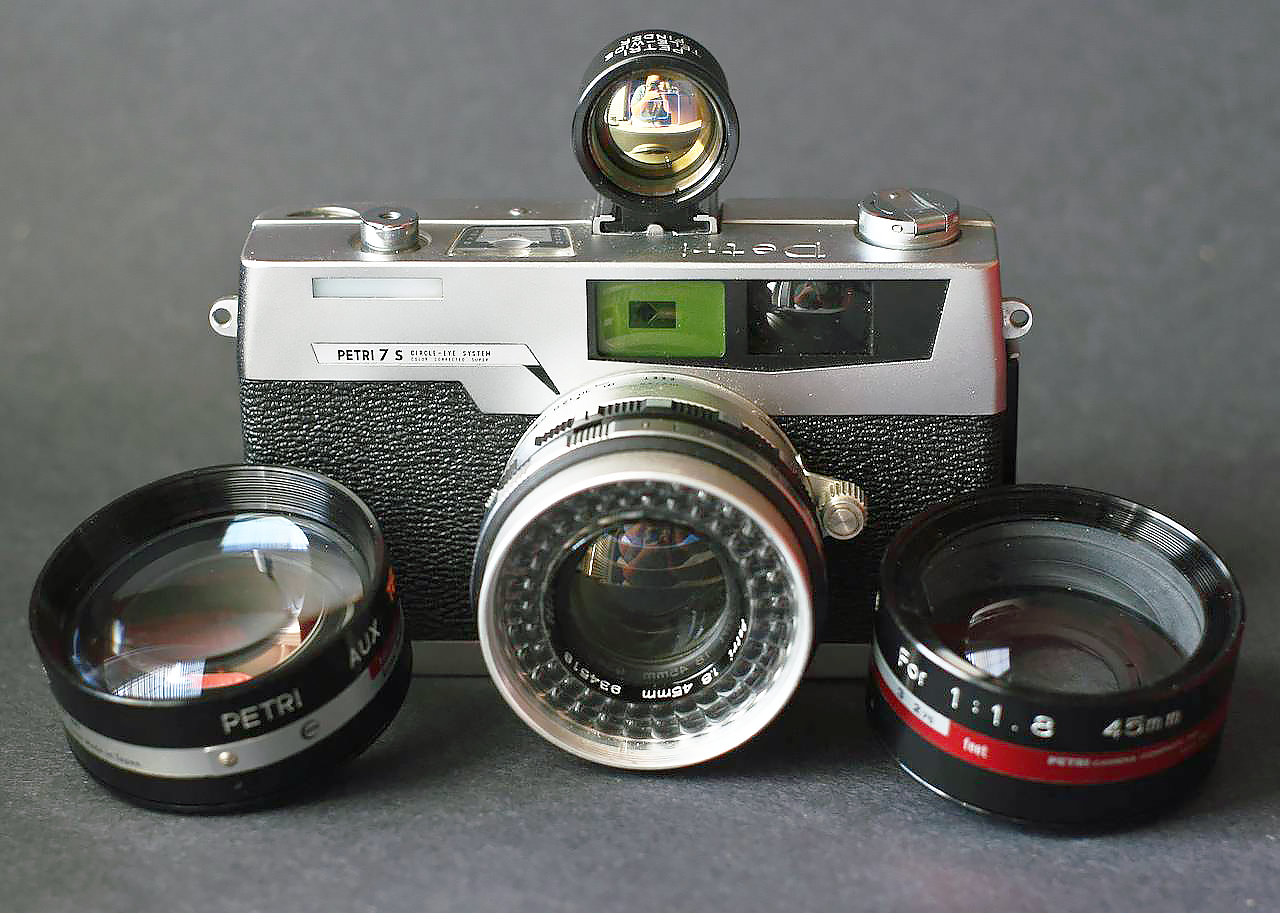
Released by Japanese camera maker Petri in 1962 and produced until 1973, the Petri 7s is a 35 mm fixed-lens rangefinder camera that was an improved version of the Petri 7 introduced a year before. An advanced camera during its time, it has an around-the-lens (ATL) selenium cell light meter that can read light values of 7 – 17. The Petri 7 was also equipped with an additional match-needle display visible both in the viewfinder and on the top plate, a coupled rangefinder, and an improved film advance lever and frame counter. The 7s came with either a 45 mm f/1.8 or f/2.8 lens, which can accept 52 mm screw-in filters.
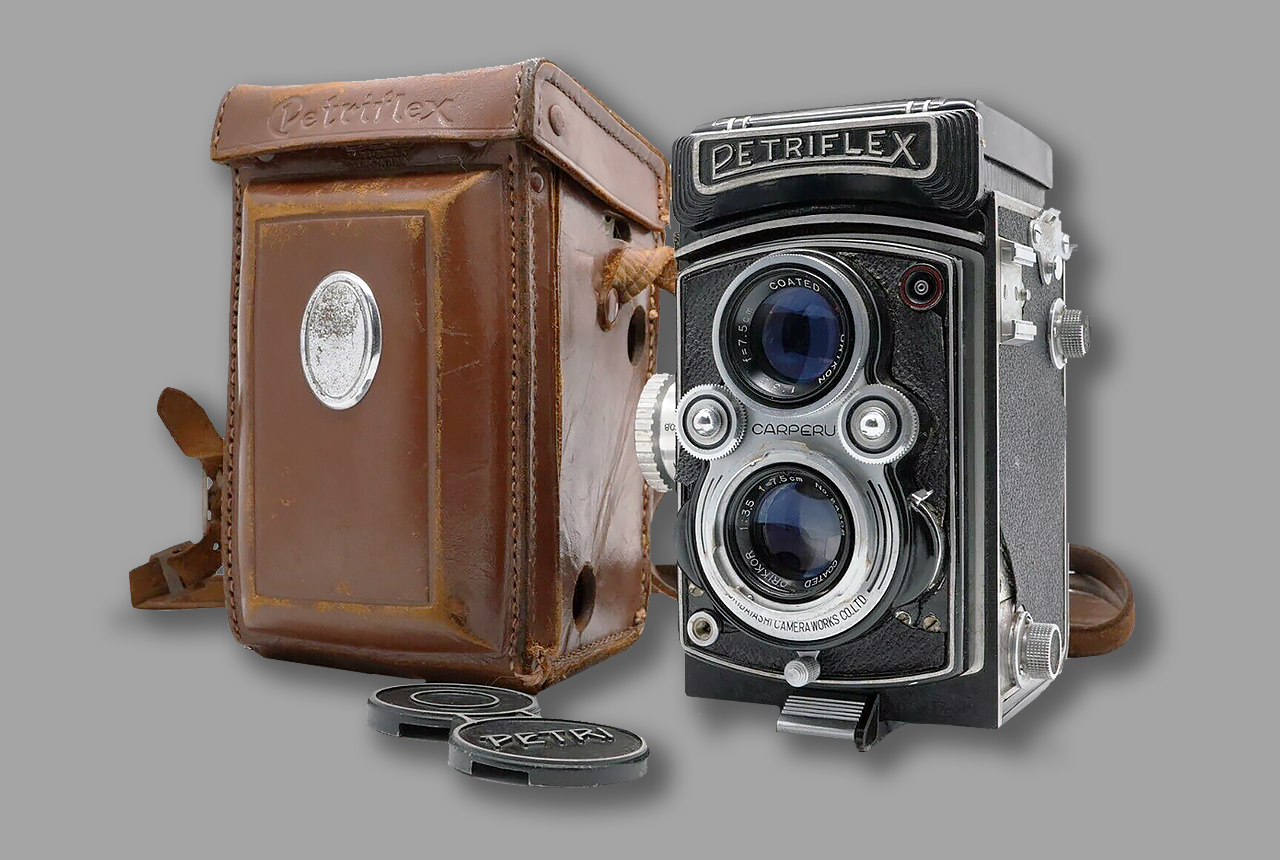
The Petri 7
In 1963 the company produced the cult model, the Petri 7S Circle-Eye System coupled rangefinder, leaf-shuttered model, which was used by some professionals in the 1960s, and which was so well built that it is still used today, particularly by street photography enthusiasts.
This was followed by the very successful Petri 7S 11 in 1966. Both models had colour-corrected lenses. In 1968, it released the Petri Colour 35, a very compact camera said to be inspired by the Rollei 35. Along with its line of 35mm rangefinder and SLR cameras, Petri also sold movie cameras and binoculars. A very limited range of lenses was produced. They returned to the M42 mount in 1974 with the Petri FTX body, continuing to use it on low cost bodies such as the FT1000/500 and the compact MFT1000 and Micro MF-1 bodies.
Petri produced many early bellows, rangefinder and single-lens reflex cameras. Due to increased electronization, mass production and competition from other camera vendors, Kuribayashi filed for final bankruptcy in 1977.
The labour union, affiliated with Sohyo, continued the company under the name Petri Kōgyō K.K. with employee capital, but it abandoned camera production some time thereafter.
The last model produced was the MF10, but with its screw-mount lens it could not compete with products having electrical contacts, and disappeared in the autofocus boom of the 1980s.
The Petri Camera brand was sold to the Dixons Group in the UK and became an “in-house” brand for a short time in the early eighties.
Now out of the camera business, Petri Kōgyō manufactures telescopes at a plant in the town of Sugito, Saitama Prefecture.
35mm film cameras
Rangefinder, fixed lens
- Petri 35
- Petri Automate
- Petri 2.8, 2.0 and 1.9
- Petri Color Super (2.8, 1.8 and 1.9 models)
- Petri E.Bn (2.8 and 1.9)
- Petri Prest
- Petri 7 (2.8 and 1.8)
- Petri Touch
- Petri 7s (2.8 and 1.8)
- Petri Pro 7
- Petri 7s II
- Petri Racer (2.8 and 1.8)
- Petri Computor 35
- Petri Computor II
- Petri ES Auto
- Petri Auto Rapid 2.8 (45/2.8)
Viewfinder, 24×36mm
- Petri 35AF-F
- Petri CF-35 Ultra Compact (Makinon MK-II)
- Petri Color 35
- Petri Color 35 D
- Petri Color 35 E
- Petri EF35
- Petri Color 35 Custom
- Petri Micro Compact
- Petri PX-1
- Petri PX-5
- Petri PX5F
- Petri PX-7
Viewfinder, 18 x 24mm
- Petri Half
- Petri Compact
- Petri Compact E
- Petri Half 7
- Petri 17
35mm film cameras
SLR
- Petri Penta
- Petri Penta Automatic / Petri Penta V
- Petri Penta V2 / Petri Flex V
- Petri Penta Junior
- Petri Flex 7
- Petri Penta V3 / Petri Flex V3
- Petri Penta V6
- Petri Penta V6 II
- Petri FT
- Petri FTE
- Petri FTX / Petri TTL (also rebadged by Kmart as “Focal TTL”)
- Petri FT II
- Petri FT EE
- Petri FT 500
- Petri FT 1000
- Petri FA-1
- Petri MF-1 / Petri SLR 35
- Petri MF-2 (Cosina CSM)
- Petri TTL-2
K-mount
From the post-1977 era, with Pentax K-mount lenses.
- Petri MF-3 (Cosina CS-1)
- Petri MF-4 (Cosina CS-2)
- Petri MF-101 (Cosina CT-1)
- Petri MF-101A (Cosina CT-1A)
- Petri MF-102 (Cosina CT-2)
- Petri MF-103 (Cosina CT-3) (MF-102/103 manual)
- Petri MF-104 (Cosina CT-4)
- Petri GX-1 (Cosina CT-1A/Cosina CT-1G)
- Petri GX-1 Super (Cosina CT1 Super)
- Petri GX-2 (Cosina CT-10)
- Petri GX-3 (Cosina CT-20)
- Petri GX-4 (Cosina CT-7)
- Petri GX-5 (Cosina CT9)
120 film cameras
4.5×6cm folder
- Semi First
- U Semi First
- BB Semi First
- Semi Rotte
- BB Semi Rotte
- Baby Semi First
- BB Baby Semi First
- Auto Semi First (rangefinder)
- Hokoku
- Mizuho
- BB Kuri
- Lo Ruby (unconfirmed)
- Petri
- Karoron and Karoron S
- Karoron RF and Petri RF
- Kuri
- Petri Super and Petri Super V
6×6cm folder
- First Six
- U First Six
- Kuri
6×9cm folder
- First Roll
- First Center
6×6cm TLR
- First Reflex
- Petriflex
miscellaneous
127 film cameras
- Eagle (4×6.5cm folder)
- Speed Pocket (4×6.5cm folder)
- Baby First (3×4cm or 4×4cm, unknown)
- Molby (3×4cm, uncoupled rangefinder)
Plate film cameras
- Speed Reflex (4.5×6cm, 6.5×9cm or 8×10.5cm SLR)
- Mikuni (6.5×9cm folder)
- First (6.5×9cm folder)
- First Etui (6.5×9cm folder)
- Kokka (6.5×9cm folder)
- Romax (6.5×9cm folder, the attribution to Kuribayashi is unsure)
- Tokiwa (6.5×9cm folder, the attribution to Kuribayashi is unsure)
Fotochrome
The Fotochrome is usually identified as a Petri manufacture but in fact, there is little evidence for this. It’s more likely that it was made by Copal as that company sued Harrison Fotochrome in the late sixties for payment for the manufacture of a camera in the mid-sixties. Fotochrome had refused to pay as the cameras were late (not timely) and mostly defective. There is no record of Fotochrome commissioning any other camera. Copal won the case in 1971 but by then, Fotochrome had filed for Chapter 11 protection.
- Fotochrome camera (direct positive)
Lenses
The brand name for for Kuribayashi lenses was Orikon, as for example fitted to the Karoron RF and Petri RF folders. Also on record are barrel lenses, such as:
- Kuribayashi Camera Orikon f/6.3 210mm
Petri’s lenses were named Petri Orikkor or simply Petri, for example:
- A.C. Petri Orikkor 1:2 f=55mm
or:
- Petri 1:1.8/55
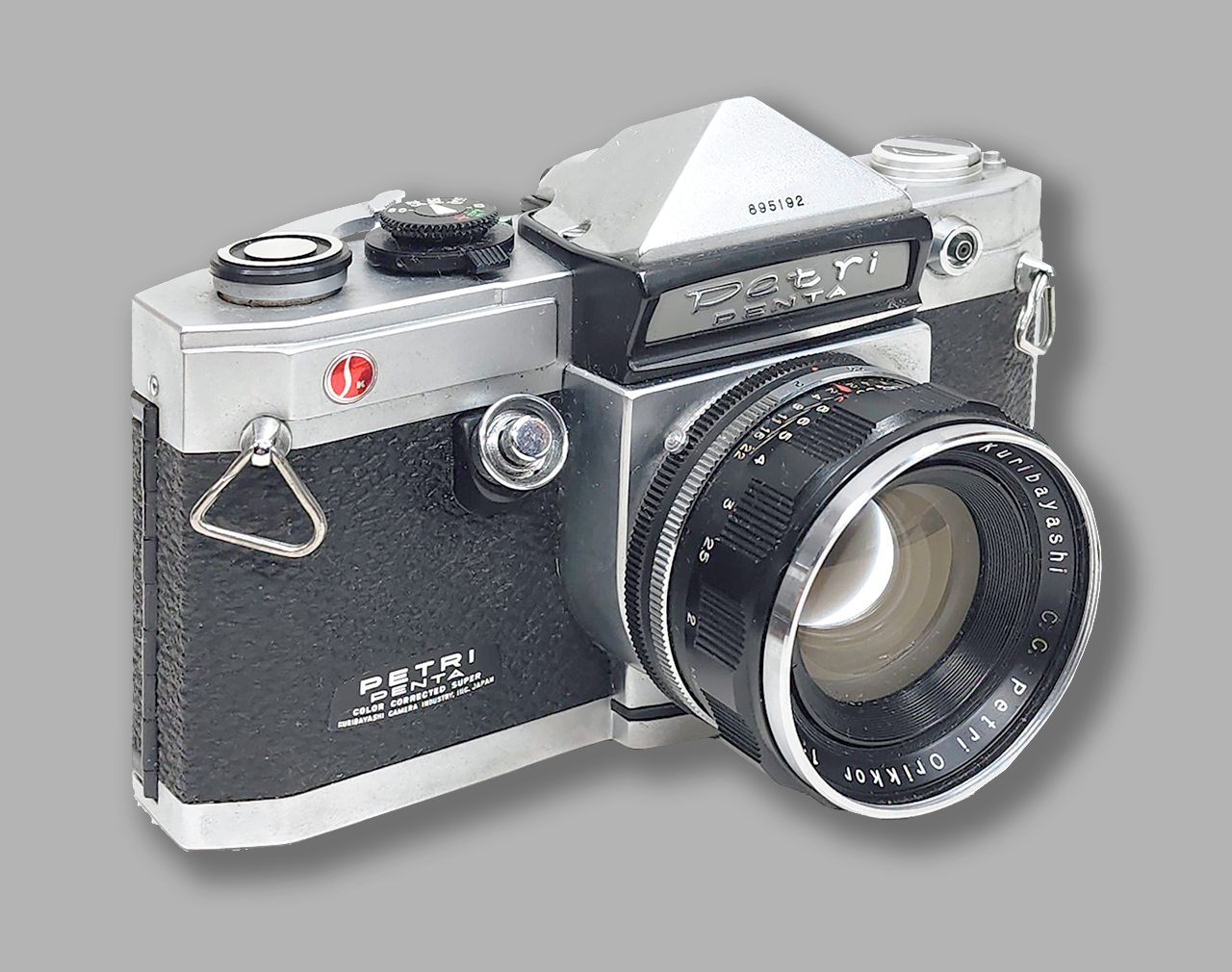
The Petri Penta is the first of a series of 35mm SLR cameras made in the late 1950s and early ’60s. Some of the series were sold in the USA (and perhaps other markets) as the Petri Flex V, and some examples are badged Petri Flex (with no ‘V’); note however that the Petri Flex 7 is not one of this series. This Petri Flex V3 (badged without the ‘V’, but showing the mounts for the lightmeter). The strip of leatherette on the prism is to avoid scratching if an accessory cold shoe is mounted; this strip also appears on the Penta/Flex V2.
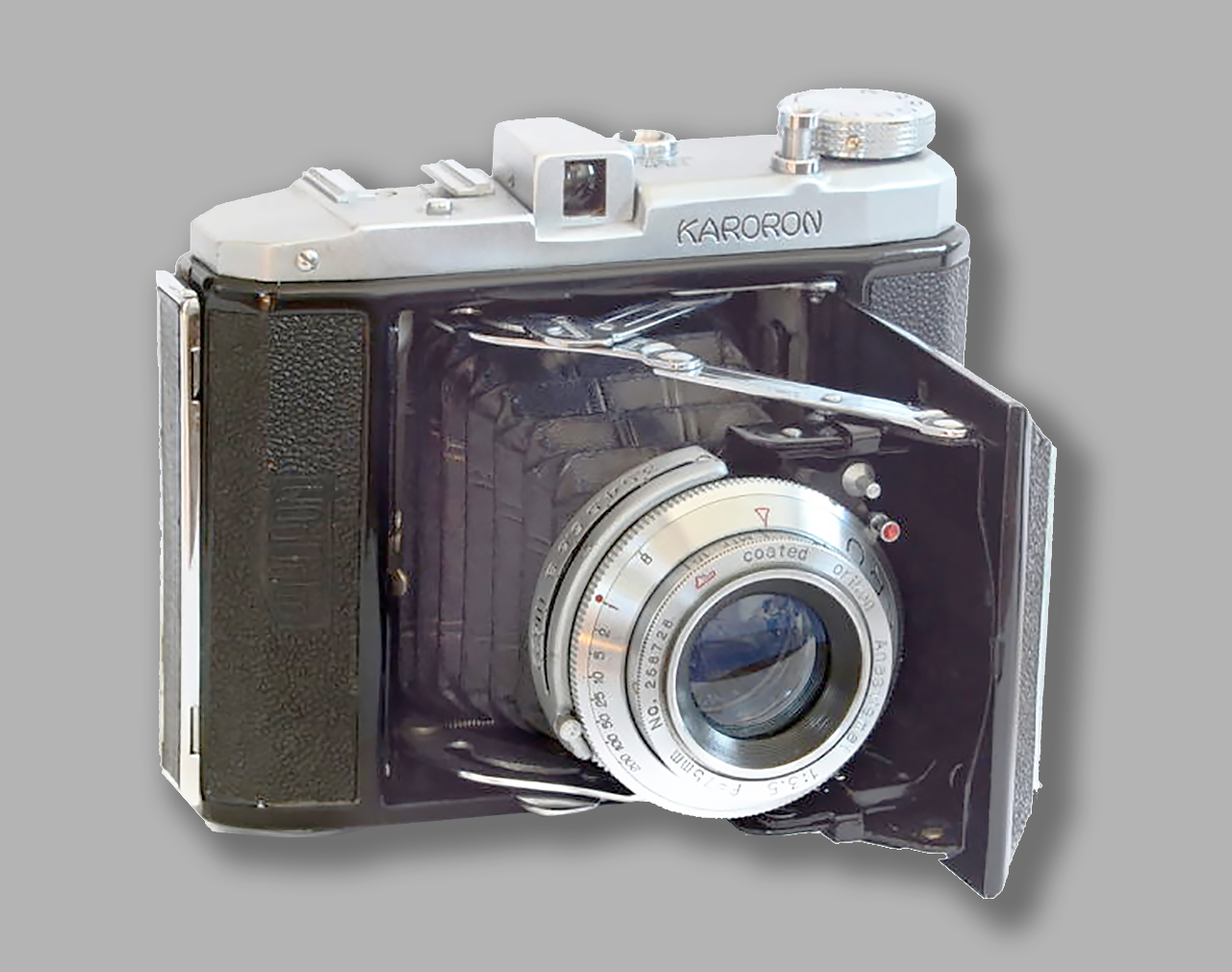
This is a Kuribayashi Karoron folding medium format camera made by K.K. Kuribayashi Shashin Kikai Seisakusho in 1949. It shoots 16 exposures of 6cm x 4.5cm on a roll of 120 film. The Karoron is not a common camera outside of Japan, but it looks to be well built with some advanced features such as an automatic frame counter, Tessar 4 element f/3.5 lens, top plate shutter release, cold shoe, and 8 speed (plus Bulb) shutter. There were several variants of the Karoron made, one of which was a rangefinder model called the Petri.

The Petri Racer is a Japanese fixed-lens 35mm rangefinder introduced in 1966 by Petri. It features a built-in match-needle coupled CdS lightmeter (only works with battery), a could shoe, flash synch and a threaded shutter release socket, but no automatic exposure program. Uses a signature Green-O-Matic viewfinder for better contrast. Metal and plastic body available in black/silver. In addition to the fixed lens, an auxiliary lens kit was available, transforming the standard 45 mm into short tele and wide lenses.
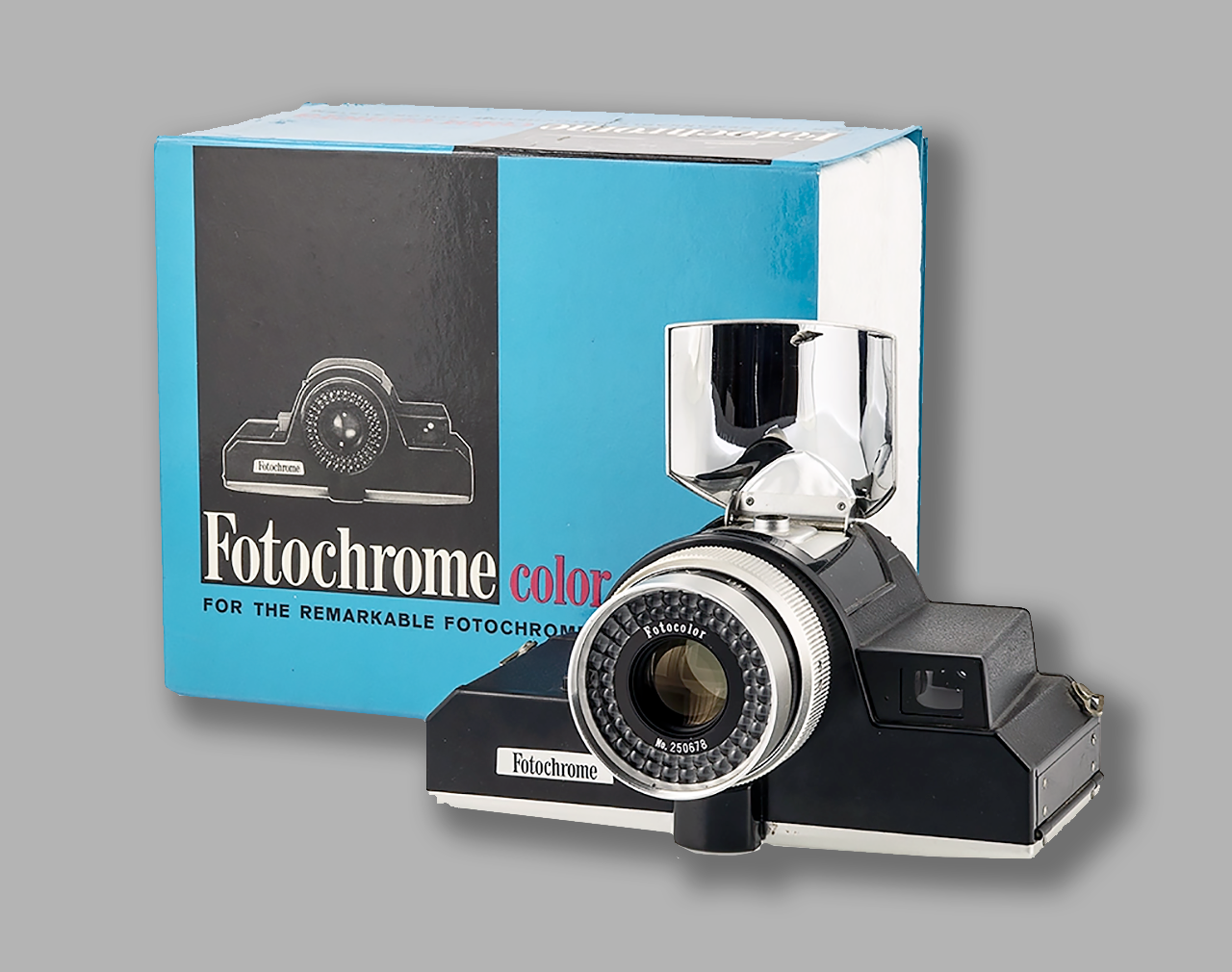
The awkward-looking Fotochrome camera was manufactured by Petri for the Harrison Fotochrome company, circa 1965. This was a major photofinishing concern based in Florida, USA, headed by Frank Nadaline. The camera employed special direct-positive film cartridges, which themselves were manufactured by Ansco, and produced images only 5.5×8 cm in size. The sensitivity of this material was quite low, approximately ASA 10. This was not instant film, and also required proprietary processing.
FOUNDING DATE: 1921
FOUNDER: Johann Bolten
COMPANY NAMES:
1921: Bolta-Werk GmbH; 1937: Photavit-Werk GmbH; 1957: The company seized camera production and continued as a producer of specialized plastic industry components; 2021: On September 28 the Bolta Werke GmbH filed for insolvency; 2022: the bankrupt Bolta-Werke were bought by the German-Czech company Winning Plastics a.s. and renamed Winning Plastics by the new owner.
1921: Diepersdorf near Nuremberg;
The company made cameras from 1935 to 1957 under two different names: Boltavit and Photavit. The Boltavit cameras and the very first Photavit cameras were the size of a matchbox.
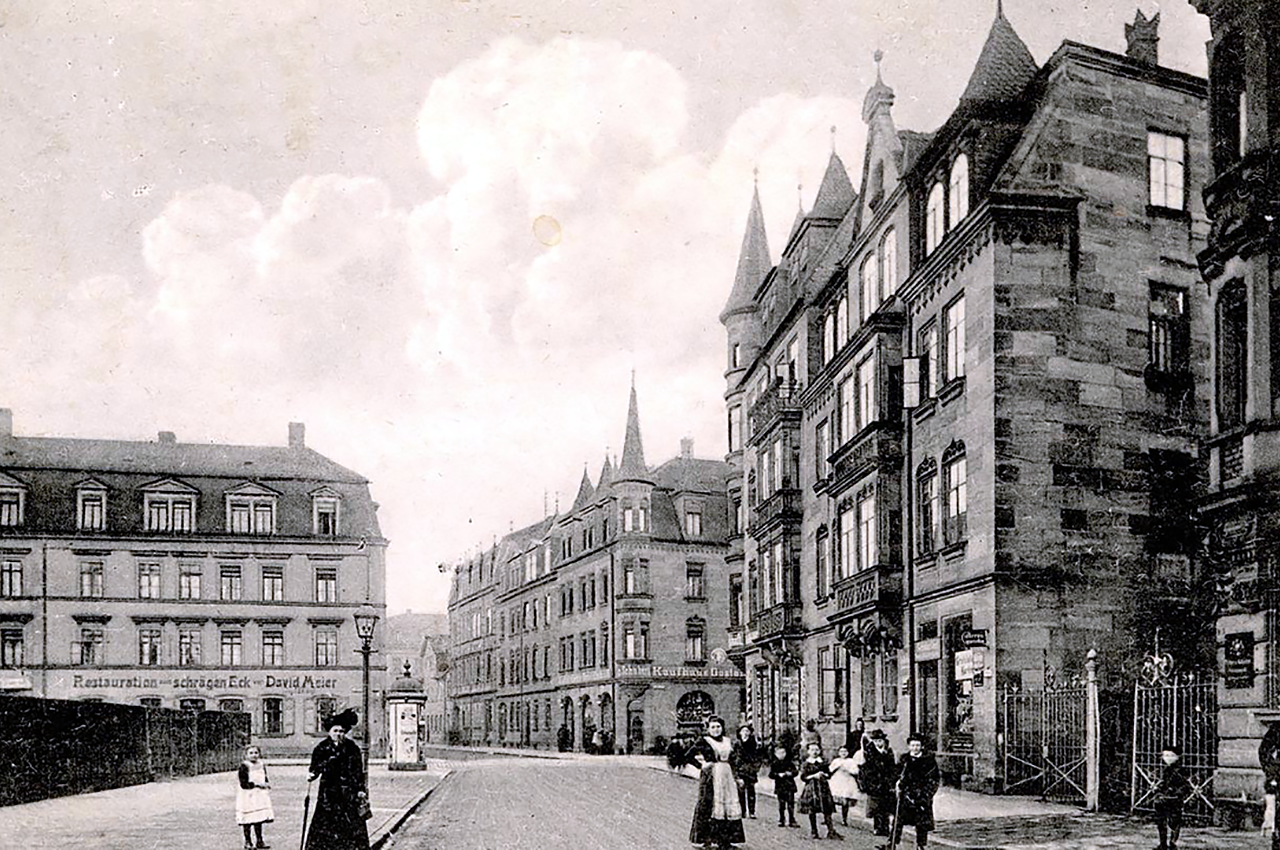
A typical streetscape of the Gostenhof in Nuremberg around 1921: the intersection of Kernstrasse, Eberhardshofstrasse and Adam-Klein-Strasse with their picturesque landscape of tenements.

CAMERAS FROM THE BOLTA GMBH PERIOD
Boltavit I & II
The 1935 Boltavit was a truly miniscule viewfinder camera with collapsible lens mount. Belying its humble size, it was fully featured, having adjustable aperture and shutter speeds, a frame counter, adjustable focus and even a cable release socket. The camera used Bolta’s proprietary roll film, the Bolta film, which was paper-backed unperforated 35mm film, on which it produced 24x24mm negatives. Several similar films were available at the time, including Ensign E10 film, which could also be used.
The very first Boltavit model had large hinges on both sides of the camera. The later (1937) Boltavit II had smaller hinges as well as a depth of field table at the back of the camera. Both were available in standard black enamel or as a luxury chrome-plated version.
The Boltavit I is most commonly found with a Boltar 40mm f/7.7 lens in a 3-speed self-cocking shutter, or with a faster Corygon-Anastigmat f/4.5 lens. The Boltavit II was available with the Corygon Anastigmat or with a faster Meyer Trioplan lens. The least common ones are those with Prontor II shutters.
During production of the Boltavit II the company renamed their cameras to Photavit, so the Photavit I is the same as the Boltavit II except for the markings on the shutter and camera back.
 Johann Bolten founded the Bolta GmbH in Nuremberg in 1921. He emigrated in 1929 to the USA where he founded a second factory. His German factory began making cameras in 1935; two years later it was renamed Photavit-Werk GmbH.
Johann Bolten founded the Bolta GmbH in Nuremberg in 1921. He emigrated in 1929 to the USA where he founded a second factory. His German factory began making cameras in 1935; two years later it was renamed Photavit-Werk GmbH.
The cameras were tiny, not much larger than a matchbox! In 1937, during production of the second Boltavit, the company name changed to Photavit-Werk GmbH, so these Boltavits can also be found with the name Photavit. Then followed a series of larger but still subminiature cameras of high specification with a Karat-like film cassette system, the Photavit II (1938), Photavit III (1946-1947) to Photavit IV (1947-1948).
In 1946, Bolten returned to Germany as a US citizen and restarted the German company. The company made the Boltavit and Photavit models from 1936 to the late 1950s. The early models used unperforated paper-backed 35mm film on special spools, called Bolta film. A late version of the 1950s was named Photina.
A typical 1950s camera range was the rollfilm TLR Photina Reflex for type No. 120 film, marketed by Sears as Tower Reflex and by Obergassner as OGA Reflex. Eventually the company also branched out into the ‘system camera’ market, rangefinder cameras with interchangeable lenses, with the Photavit 36.
The company stopped making cameras in 1957 and was after that only a producer of specialized plastic components for industry. In 2022 the bankrupt Bolta-Werke were bought by the German-Czech company Winning Plastics a.s..
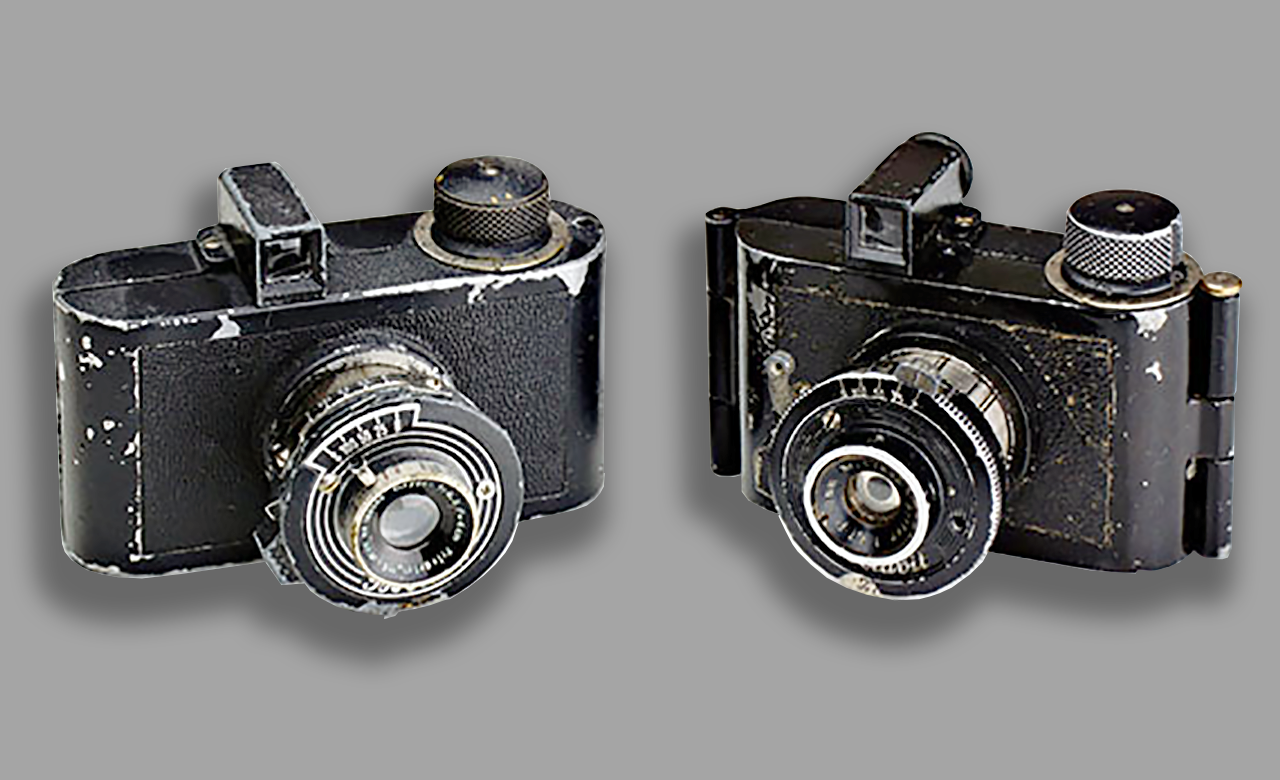
Comparison of standard black versions of the Boltavit I (right) and Boltavit II (left). Note the Boltavit II looks a little larger due to the loss of the external hinges that are present on the Boltavit I.

CAMERAS FROM THE PHOTAVIT-WERKE GMBH PERIOD
Photavit II
The 1938 Photavit II had a completely redesigned body with body-mounted shutter release and double-exposure prevention. The lens was still collapsible and was front-cell focussing, in contrast to most later Photavits.
The camera used a cassette system not unlike the Karat cassettes but it had a spool inside the cassettes, so essentially it was a roll film without the need for paper backing. It could be used with standard 135 film – the perforations had no use but the 25×25 mm film frame would fit in-between them.
As one would turn the wind spool the same amount for each picture (determined by the camera’s wind lock mechanism), the spacing between consecutive frames increased with each picture taken (see picture of the frame spacings below).
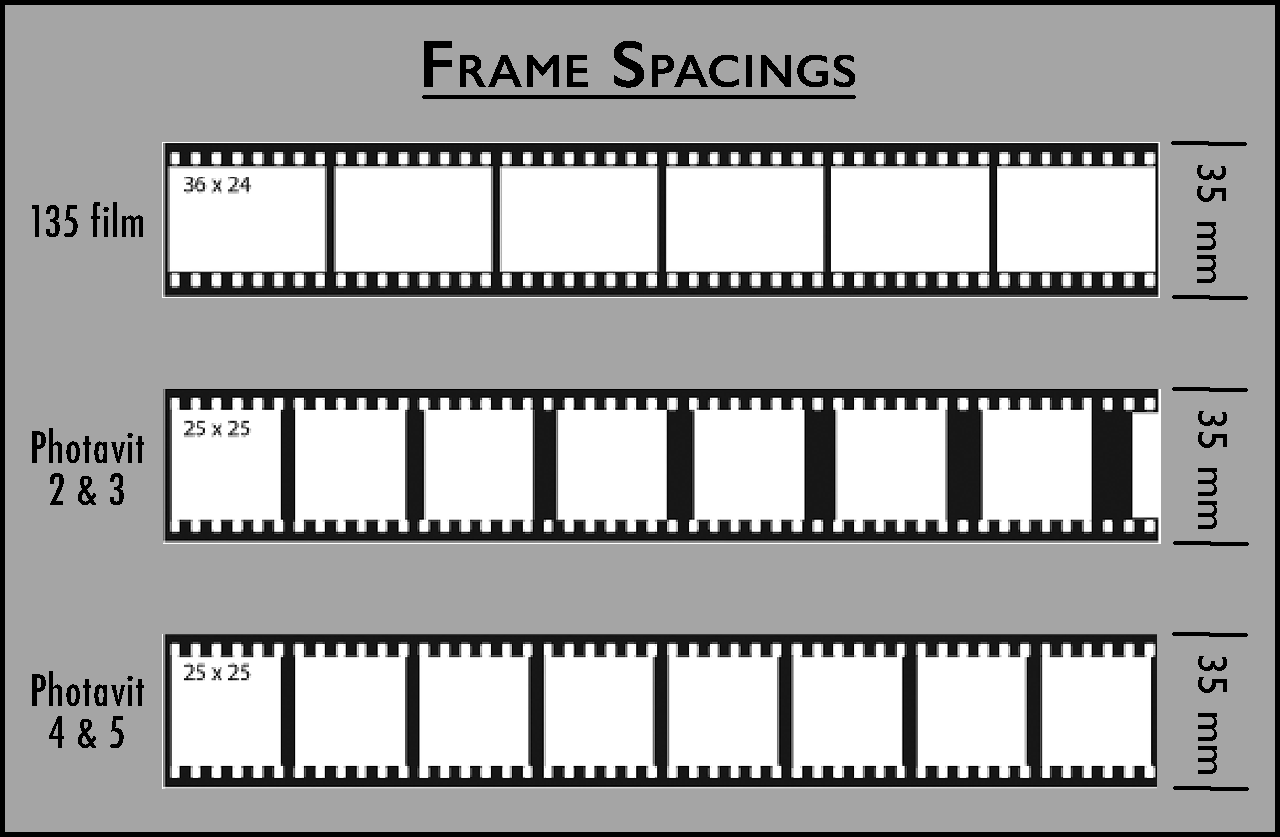
Frame space and size for different cameras. (top) standard 135 film camera (middle) Photavit II and III with increasingly large frame spacing (bottom) Photavit IV and V with constant frame spacing. The Photavit II and III would fit less photographs on the same amount of film. Finetta cameras had a similar issue.
Photavit III
The 1946-7 Photavit III differed from the Photavit II mainly by having helical focus with a focus indicator and depth of field scale mounted on the body. Moving the focus lever up and down would extend and retract the lens tube to achieve proper focus.
Also new was that ‘Photavit’ was engraved on the top plate. The lens was no longer collapsible. The camera still had the same wind mechanism as the Photavit II meaning that the space between frames increased by about 1 mm with each picture taken.
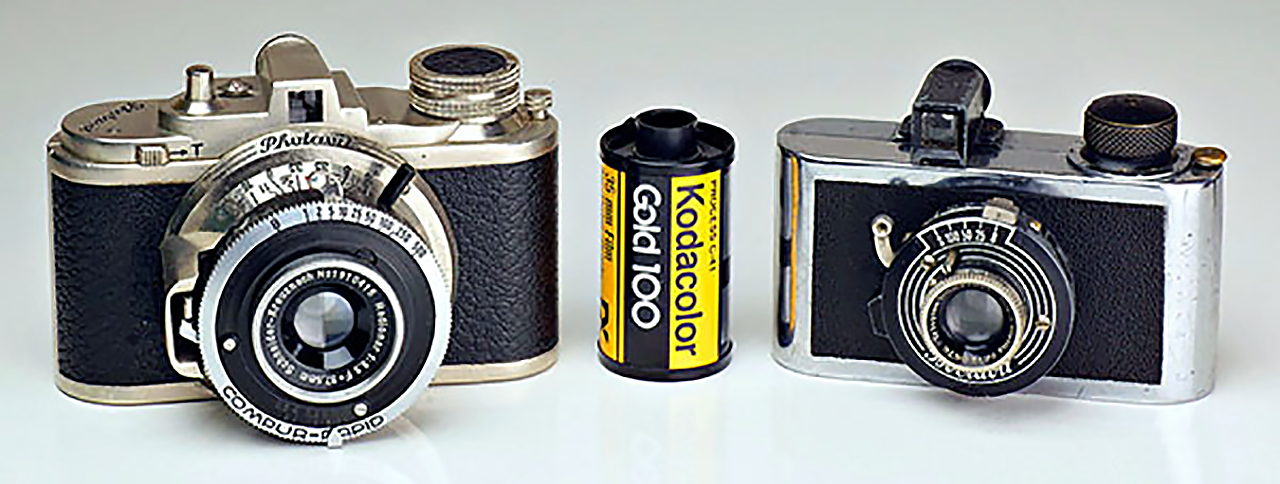
A Boltavit II (on the right) and Photavit IV (on the left) together with a roll of 135 film (which can be used to load the cassettes), just to show how small the Boltavit really is.
Photavit IV
The 1947-8 Photavit IV had several changes compared to the Photavit III. It received a T button which could be used to keep the shutter open for any length of time. It no longer had an external wind lock mechanism, instead it had a sprocket wheel and therefore the space between frames was constant. It had a separate frame counter behind the shutter release button instead of beneath the wind knob as in previous models. It also had a small lever to reset the counter to zero. The lens base was enlarged and had Photavit engraved on it. In addition, a serial number was stamped on the base of the camera, which was lacking on the Photavit II and III.
Later in the production, from around serial# 10,000, a cable release socket was added, probably because operating the T button would often result in camera shake. Even later models had a rewind button which no longer had a ridge through the middle. The highest serial number I have seen is 22,894, the lowest 10,547, so at least around 12,000 were made.
Photavit V
The 1951 Photavit V had a front-cell focusing lens, a Roeschlein Kreuznach Luxar 38mm f/2.9 in Prontor-S, SV or Vario shutter. This was a clear deviation from earlier Photavit versions with helical focus, Compur shutters and Schneider-Kreuznach lenses, presumably in an attempt to make its price more competitive. Roeschlein was a small lens maker compared to its big brother Schneider from the same city, but did produce some interesting lenses mostly for Braun, including the highly-reputed f/2 Luxon.
The Photavit V camera body was identical to the last version of the Photavit IV. Some overlap exists between the two models in serial numbers around 22,000. The highest serial number I have seen is 26,624, so probably around 4,000 were made. This was the last Photavit subminiature model produced. The later Photavit 36 (see below) was a regular 35mm camera.
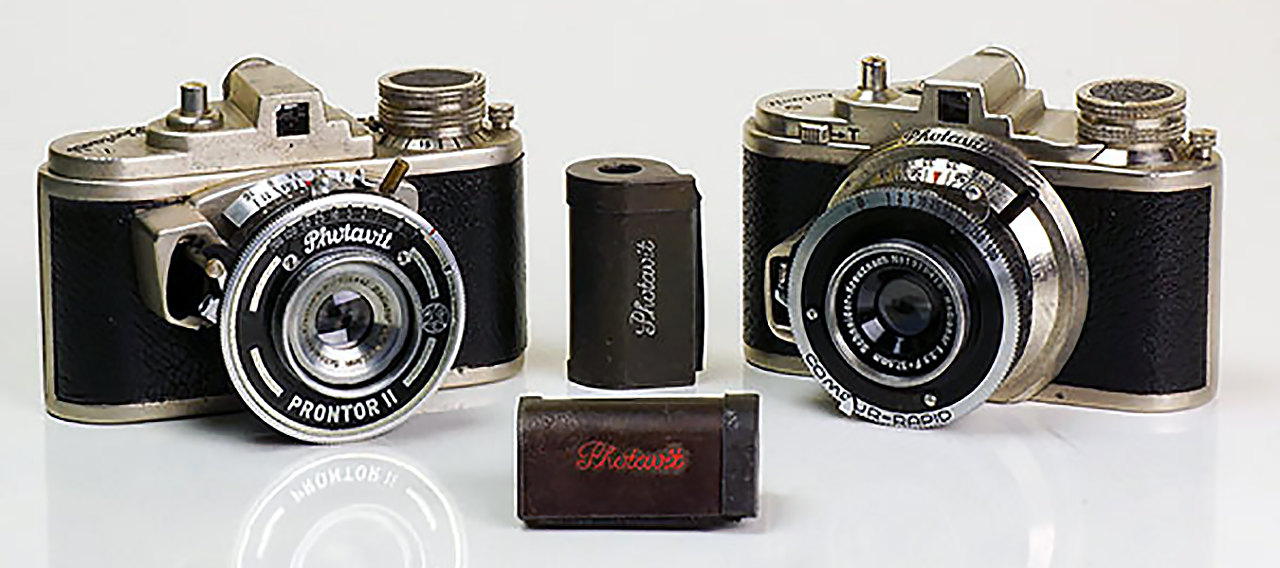
Photavit III on the left and Photavit IV on the right, displayed with a couple of Photavit cassettes. Both cameras have Schneider Radionar lenses, the silver one on the Photavit III looks a little suspicious and probably the black lacquer has been polished away. Note the difference between the lens mounts.
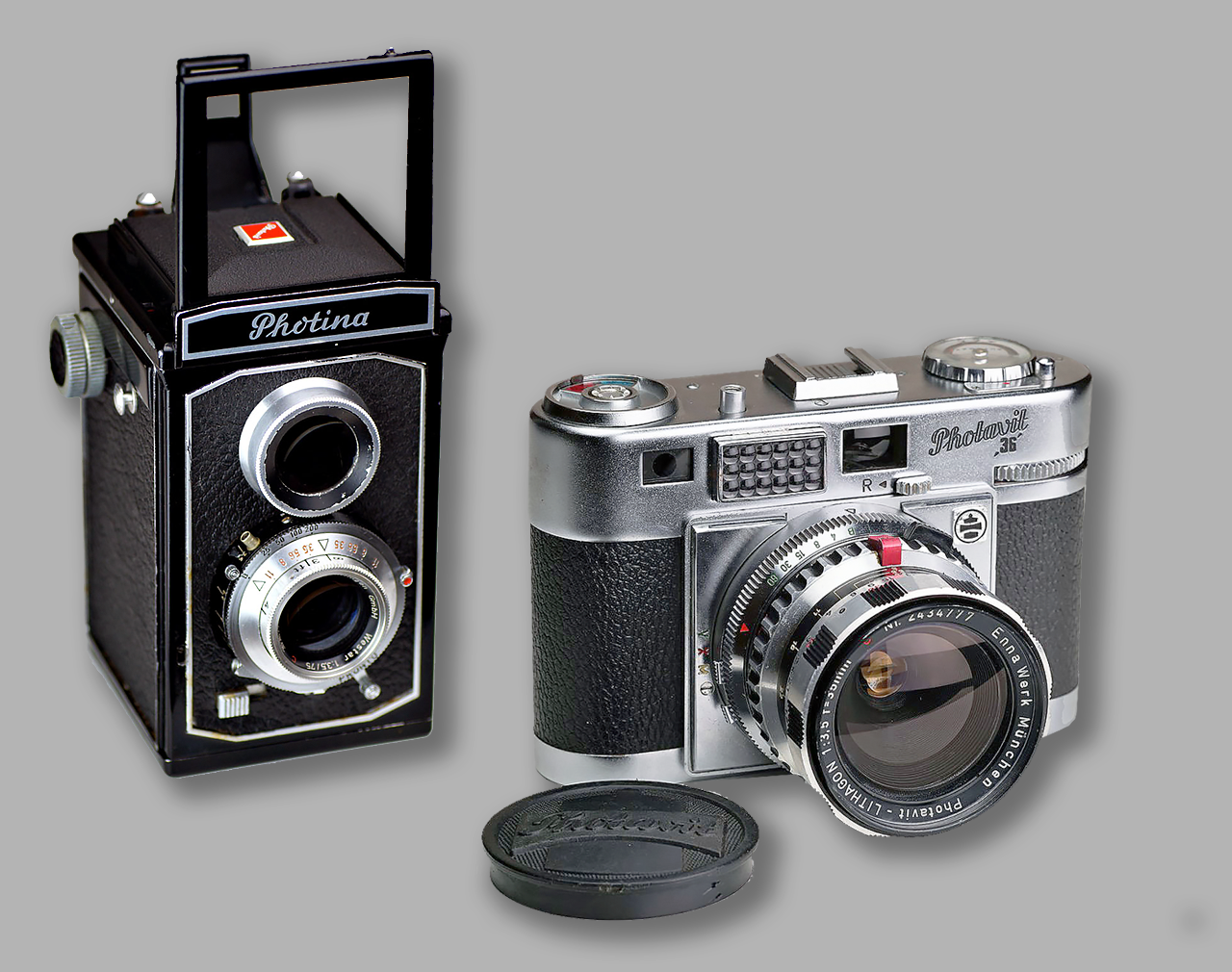
Photavit 36 with uncoupled light meter and Enna Photavit-Ennit 50mm f/2.8 interchangeable lens. Note the akward position of the rewind button: just below the viewfinder window. Several interchangeable lenses were available for the Photavit 36.
Photavit Photina II, a pseudo TLR with Isco Westar 75mm f/3.5. It was essentially just a box camera and in fact the built-in viewfinder, as shown in the photo, was probably better for framing than the mirrored image of the frosted glass viewfinder.
Other Photavit cameras
Photavit 828
A rather rare variant of the Photavit IV was the Photavit 828. It was based on the last production model of the Photavit IV but used 828 film, which is a non-perforated roll film version of 135 film with paper backing. Instead of a film sprocket wheel it had a grooved wheel which ensured even spacing of film frames as well as a small wheel in the pressure plate to grip the film tight. Also, it had little hooks that needed to be closed to hold the wind spools in place.
The camera had Film 828 engraved on the base of the camera. This return to Photavit’s roll film origins is a little ironic, as its own Bolta film format was similar to 828 film but abandoned with the introduction of the Photavit II. The Photavit 828 had a different range of serial numbers than other Photavit models, most likely starting at 50,000. The highest number I have seen is 52,164, so over 2000 were made.
Photavit 36
The 1956 Photavit 36 was a completely new camera design not unlike the Braun Super III. With that model it also had the interchangeable lens mount in common: the Prontor SVS mount. This was Photavit’s first rangefinder camera and came in two versions: with or without light meter. 35mm wide angle and 135mm telelenses were available in addition to the 45mm and 50mm standard lenses.
The Photavit 36 is rather rare. They have serial numbers on the back and appear to continue from the Photavit range or possibly started at 30,000. It appears at least 4000 Photavit 36 were made.
Photina II TLR
The 1952 Photina was a TLR camera. There were several versions, the first was a pseudo-TLR with non-coupled viewing and taking lens, the Photina II had a faster shutter and lens, the Photina Reflex was a true TLR camera with Steinheil Cassar or ISCO Isconar 75mm f/3.5 viewing and taking lenses in a Prontor-SVS shutter. This range was reasonably successful and were sold under license in the USA by Sears as Tower Reflex II, III and 30, respectively.
A limited overview of the Bolta and Photavit cameras
In January 2006 Nikon announced the discontinuation of all but two models of its film cameras, focusing its efforts on the digital camera market. It continues to sell the fully manual FM10, and still offers the high-end fully automatic F6. Nikon has also committed to service all the film cameras for a period of ten years after production ceases.
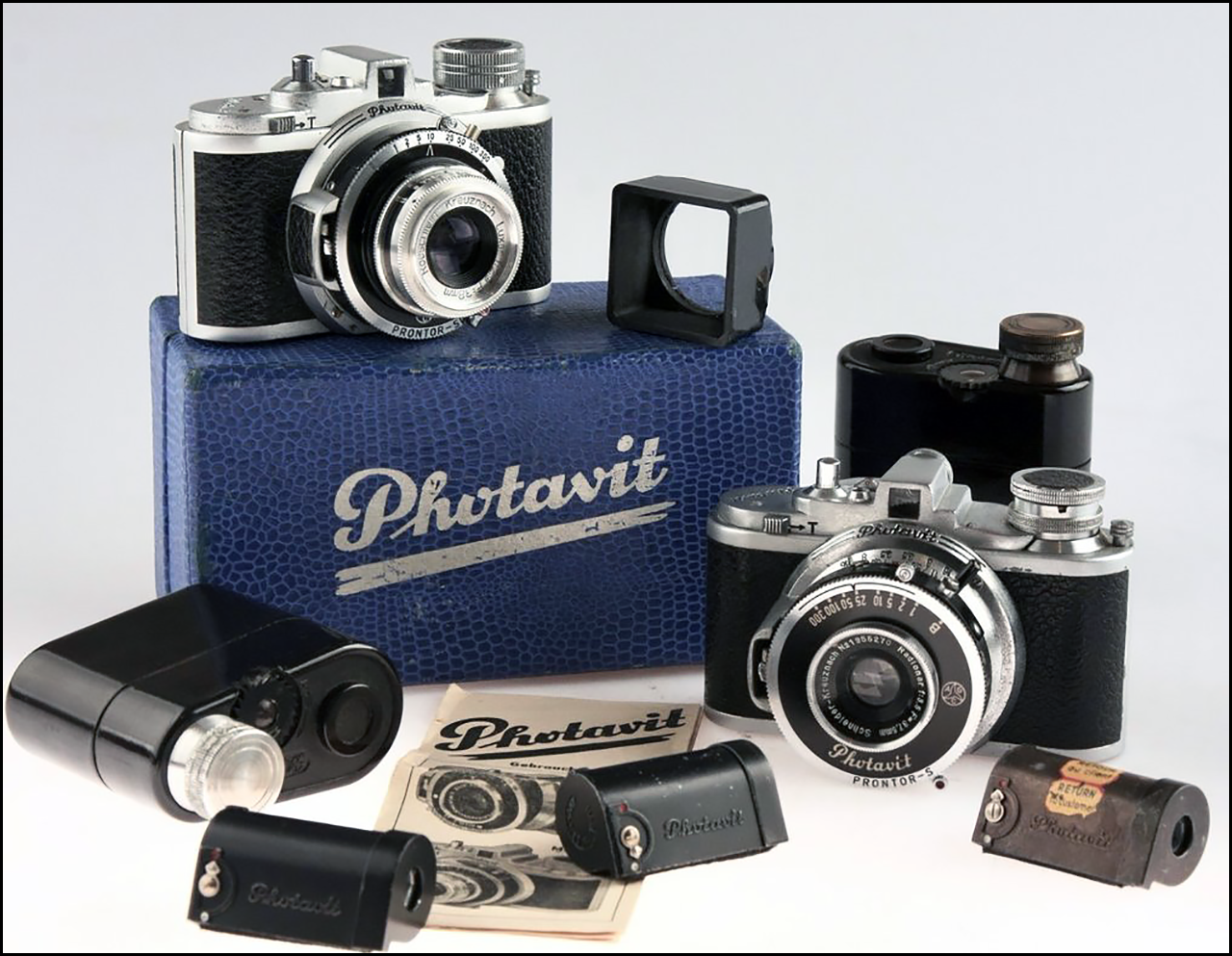
Bolta Photavit Model IV + Model V, complete with the gift box, the lens hood and together with a manual, rolls of 35mm film (which can be used to load the cassettes).
Unless otherwise noted, these use unperforated 35mm film in special Bolta film cartridges.
- Boltavit (1936) identified by external hinges
- Boltavit II (1937) identified by internal hinges.
- Photavit I (1938) same housing as Boltavit II
- Photavit II (1938)
- Photavit III (1946)
- Photavit IV (1948) advertised as “world’s smallest 35mm camera”
- Photavit V (1951)
- Photavit 36 (1956-1958), uses standard 35mm cartridges
35mm Bolta roll film cameras
- Photavit (1937)
120 film cameras
- Photavit Photina (aka Sears Tower Rediflex II)
- Photavit Photina Reflex II (aka OGA-Reflex)
- Photavit Photina Reflex III (aka Sears Tower Reflex 30)
828 film cameras
- Photavit 828
Super-8 cine cameras
FOUNDER: Hugo Schrader
COMPANY NAMES:
1902: Plaubel & Co.; 1931: Plaubel Feinmechanik und Optik GmbH; 1975: the Plaubel company was purchased by the Japanese company Kimio Doi (of the Doi group of companies);
COMPANY ADDRESSES:
1902: Frankfurt-Bockenheim, Königstraße 66, Germany; later move to Frankfurt-Rödelheim, Rödelheimer Landstraße 168; 19??: Borsigallee 37, 60388 Frankfurt am Main; 2004: Carl-Zeiss-Straße 5, 60388 Frankfurt am Main.
The Plaubel Feinmechanik und Optik GmbH in Frankfurt was known for generations as a home of highly elegant, mechanical constructions. Since the beginning of the 20th century she has been manufacturing numerous precision cameras, including her most famous product, the original Plaubel Makina film pack camera. Many photographers welcomed this as the most elegant press camera at the time. The Makina began and ended its existence as a 6×9 cm folding camera for sheet film and film packs.
Plaubel was a German camera maker, founded in November, 1902, by Hugo Schrader, who learned the technology of cameras and lenses as an apprentice at Voigtländer in Braunschweig in the late 1800s. Hugo Schrader was a son-in-law of the famous camera and lens manufacturer and distributor Dr. Kruegener and worked in Kruegener’s lens factory in Frankfurt-Bockenheim.
Hugo Schrader and his wife elected to open their own business, Plaubel & Co., as distributors and makers of cameras and lenses, naming it after his brother-in-law because he thought Plaubel was easier to remember than Schrader. Plaubel & Co. first product catalogue was published for Christmas of 1902 and included cameras of all sizes and makes plus many accessories.
At first only lenses were made: the four-lens double Ortar 1:1.6 with focal lengths of 6 to 75 cm and the Peconar 1:8, 15 to 25 cm. It was not until 1909, at the request of many customers, that camera production began (“Präzisions-Peco”, a 9x12cm/10x15cm folding bed field camera with an air brake shutter with three slats).
In 1912 Hugo Schrader introduced the first Plaubel Makina, a compact bellows camera with a scissors-struts design. A high-quality press-type camera with leaf shutter, interchangeable lens, and coupled-rangefinder for mainly 6x9cm format. Production lasted up to approximately 1960, which saw the product line evolve for Makina models 1, 2, 2s, 3, and 3R.
Goetz Schrader
 Schrader’s son, Goetz, who was to become the future mainstay of the firm, entered Plaubel in 1925 as an apprentice and his first work for Plaubel being the Makinette, a 3×4-on-127 camera. Goetz became head of the technical department and in charge of camera development in 1930. A year later he became co-owner with his father and the company became a limited liability company named Plaubel Feinmechanik und Optik GmbH. After the death of Hugo Schrader in 1940, Goetz Schrader took over the management of the company.
Schrader’s son, Goetz, who was to become the future mainstay of the firm, entered Plaubel in 1925 as an apprentice and his first work for Plaubel being the Makinette, a 3×4-on-127 camera. Goetz became head of the technical department and in charge of camera development in 1930. A year later he became co-owner with his father and the company became a limited liability company named Plaubel Feinmechanik und Optik GmbH. After the death of Hugo Schrader in 1940, Goetz Schrader took over the management of the company.
During World War II Plaubel was converted to manufacture precision military gear but was bombed and seriously damaged in 1944. After World War II, Schrader designed, produced and specialized on large-format monorail studio view cameras.
In 1950 Plaubel introduced the Makiflex to compete with the Hasselblad camera. However, it wasn’t a huge success, and Plaubel focused on monorail cameras. In 1952 the company introduced the Peco monorail camera for professionals and semi-professionals. The name Peco is believed to stand for Plaubel Equipment COmpany. The camera proved to be a success and this line of cameras for many years to follow.
In 1961 Plaubel introduced the Makiflex and Pecoflex, 9x9cm/6x9cm/6x6cm SLR cameras, with focal-plane shutters and revolving backs. Plaubel collaborated in 1961 also with Burleigh Brooks of New York, and introduced the Veriwide 100 camera, a 6x10cm roll-film viewfinder camera with a fixed wide angle lens.
Studio View Cameras
- Peco Junior 9×12
- Peco Junior 6×9
- Peco Profia
- Peco Supra
- Peco Universal III
- Peco Profia PL 1
- Peco Profia PL69D
- Peco Profia NT
- Peco Profia ZT
- Baby Makina
With adaptors for 120 film
- Makina I
- Makina II
- Makina III
- Makina IIIR
stereo strut folding
- Stereo Makina 45×107
stereo strut folding
- Stereo Makina 6×13
Lenses
- Anastigmat-Tele-Peconar
- Anticomar
- Heli-Orthar
- Triple-Orthar
roll film (120 & 220)
4.5×6 folding
- Roll-Op and Roll-Op II (4.5×6 version)
6×6 folding
- Roll-Op and Roll-Op II (6×6 version)
6×7 STRUT folding
- Makinette 67
- Makina 67
- Makina W67
- Makina 670
- 69W ProShift (with Schneider Super-Angulon 5,6/47 mm ultra-wide-angle lens)
- PL69D
- Brooks-Plaubel Veriwide 100 (1959 – 1965)
Large Single Lens Reflex
- Makiflex – large single-lens reflex bellows camera (1963)
- Pecoflex – large single-lens reflex bellows camera (1963)
127 film
- Makinette (3×4)
35mm film
- Makinette 35P, prototypes only
16 mm film
- Makinette 16, prototypes only
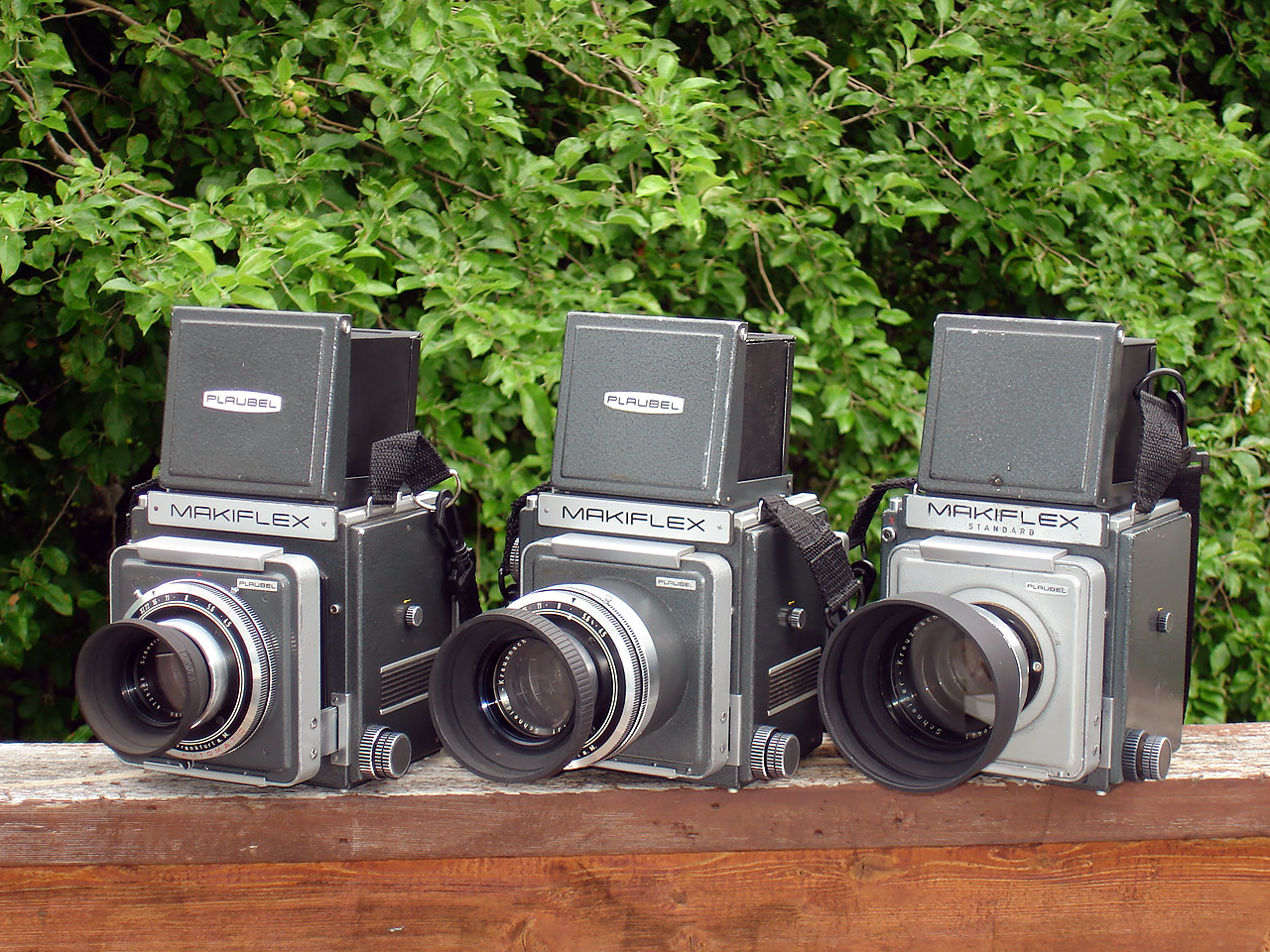
The final Swan Song of the Plaubel Camera Company, (in the early 1960’s) was the reflex-SLR version Plaubel Makiflex. The two Makiflexes on the left, are the Automatic “Makiflex”. Very similar to a European Auto Graflex, with automatic diaphragm mechanism. The Plaubel original lenses are the 180mm Schneider Xenar, and the 210mm F4.5 Schneider Xenar. On the right, is the “Makiflex Standard” with 150mm F2.8 Schneider Xenotar. This model has a more restricted range of shutter speeds, and no auto-iris provision. These cameras are from “The Golden Age of Photography”.

Since nobody in Schrader’s family wanted to take over the management role after Goetz’s step down, the company was sold in 1975 to Mr. Kimio Doi of the Japanese Doi Group of companies, and effectively became a Japanese company.
In 1979 the company launched a modernized successor to the Makina, called the Makina 67. This unique high quality camera body was designed by Konishiroku, now called Konica, and the 80mm F2.8 lens was by Nikon. In 1981 the manufacturer was changed to Mamiya due to a relationship Mr. Kimio had with the company.
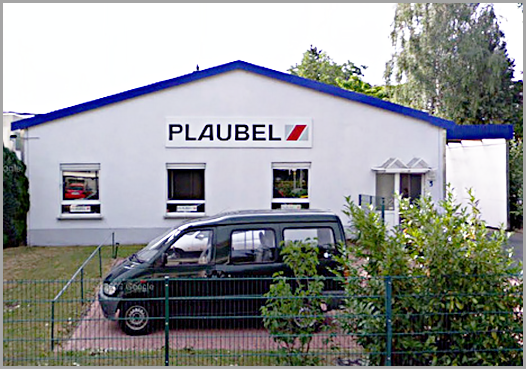
On a completely new housing at the end of 1981 Plaubel presented the 69W built PROshift with a Schneider Super-Angulon 5.6 / 47 mm. The camera provided a parallel displacement of the lens in two directions (horizontally and vertically 13 mm 15 mm), but was in contrast to the Makinas no built light meter.
Apart from a simple frame viewfinder PROshift had a wide-angle telescope viewfinder, which was coupled with the parallel displacement of the lens upwards or sideways. In 1982 followed the Makina W67, with a 55/4.5 Wide-Nikkor lens. The 670 Makina Makina was a modernized remake of the 67 with the same Nikkor 80/2.8 and a couple of new features such as a top hot shoe and the ability to use 220 roll film in addition to 120.
Following the bankruptcy of Mamiya in March 1984, the production of Makina cameras was still continued for two years, and Doi Group stopped the production of the Makina 67 in 1986. The company still services and repairs this cameras till 2022. Goetz Schrader died in 1997 but Plaubel continued to produce large format monorail cameras (Peco Profia for 4×5, 5×7 and 8×10 inch until 2017) but also a 6×9cm/2-14×3-1/4-inch medium-format Peco monorail camera for digital and roll film (PL69D).
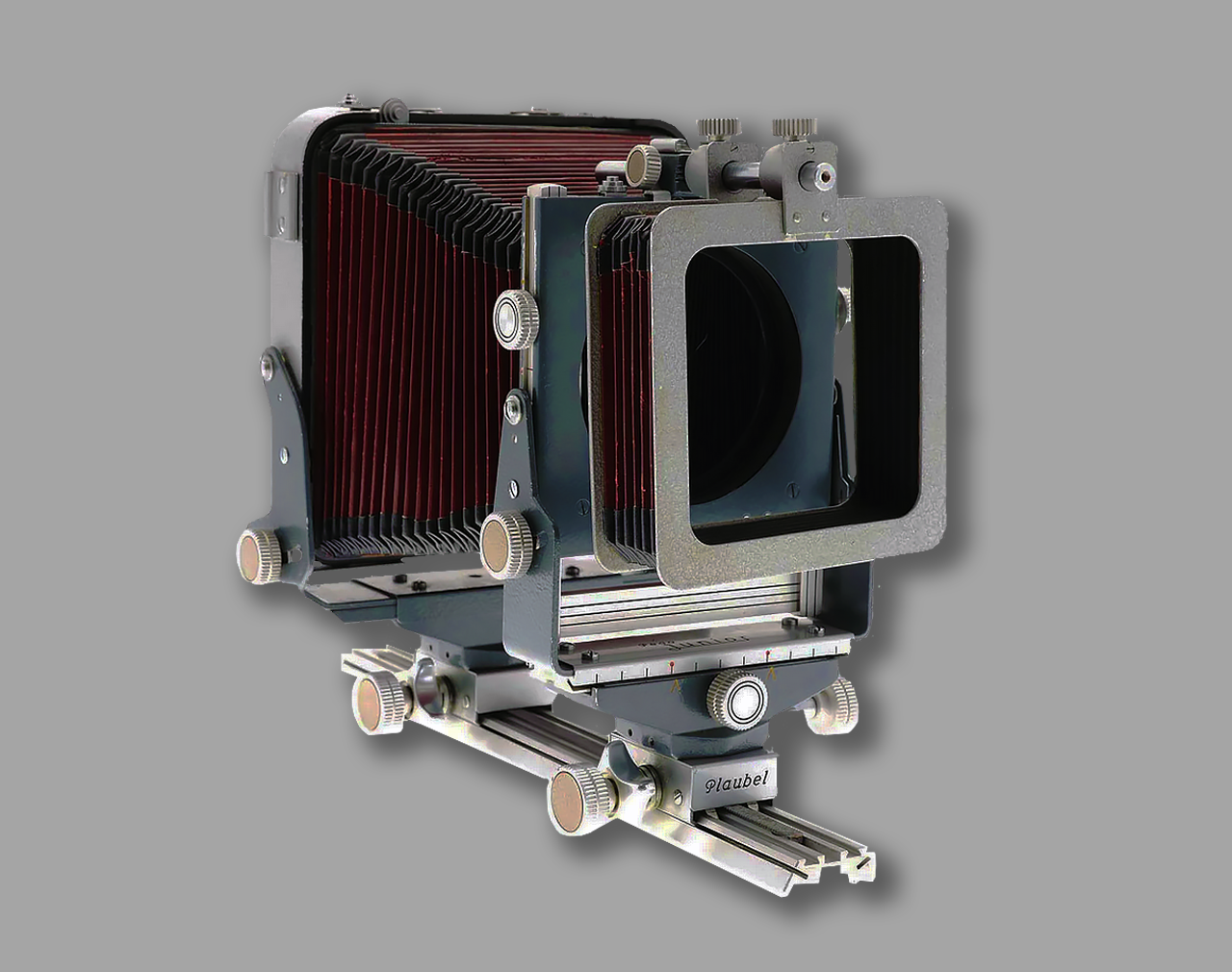
Peco Junior 9×12 Studio View Camera (1960), for 9 x 12 cm/10 x 15 cm/4″ x 5″ large format plates and sheet films, and 2-1/4″ x 3-1/4″/ 2-1/4″ x 2-1/4″ roll film medium formats; bellows view camera on a 320 mm-long flat optical bench monorail with rack teeth and tripod socket; swings, tilts, and rise/fall/side shifts for front standard, swings and tilts on optical axis for rear standard plus revolving back; detachable bellows allows camera to be folded flat for transport or storage; spirit levels on rear standard; accessory shoes on front and rear standards; all-metal construction of camera standards and monorail.
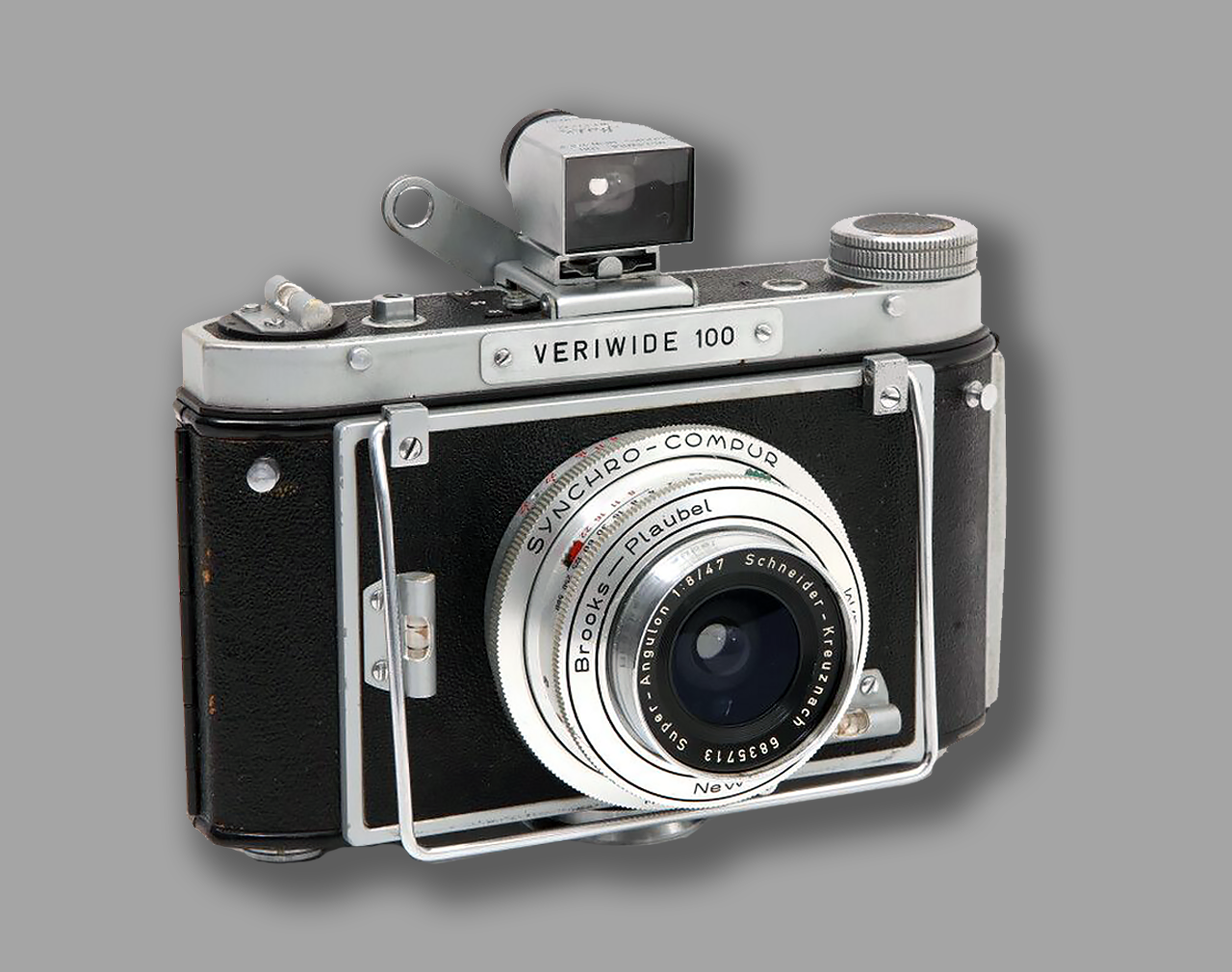
Brooks-Plaubel Veriwide 100 (1959 – 1965); Compact super-wide-angle roll-film camera with 100-degree field of view; designed in USA by Frank Rizzatti of Burleigh Brooks Inc. and manufactured in Germany by Plaubel; reportedly only 2,000 copies were built; seven images 6 cm x 10 cm on 120 roll-film; Synchro-Compur leaf shutter, fully synchronized with M and X settings, built-in self-timer, speeds from 1 second to 1/500th second plus B; double exposure prevention; standard tripod socket in camera base; most units have three spirit levels for critical monitoring of horizontal, vertical and tilt positioning.
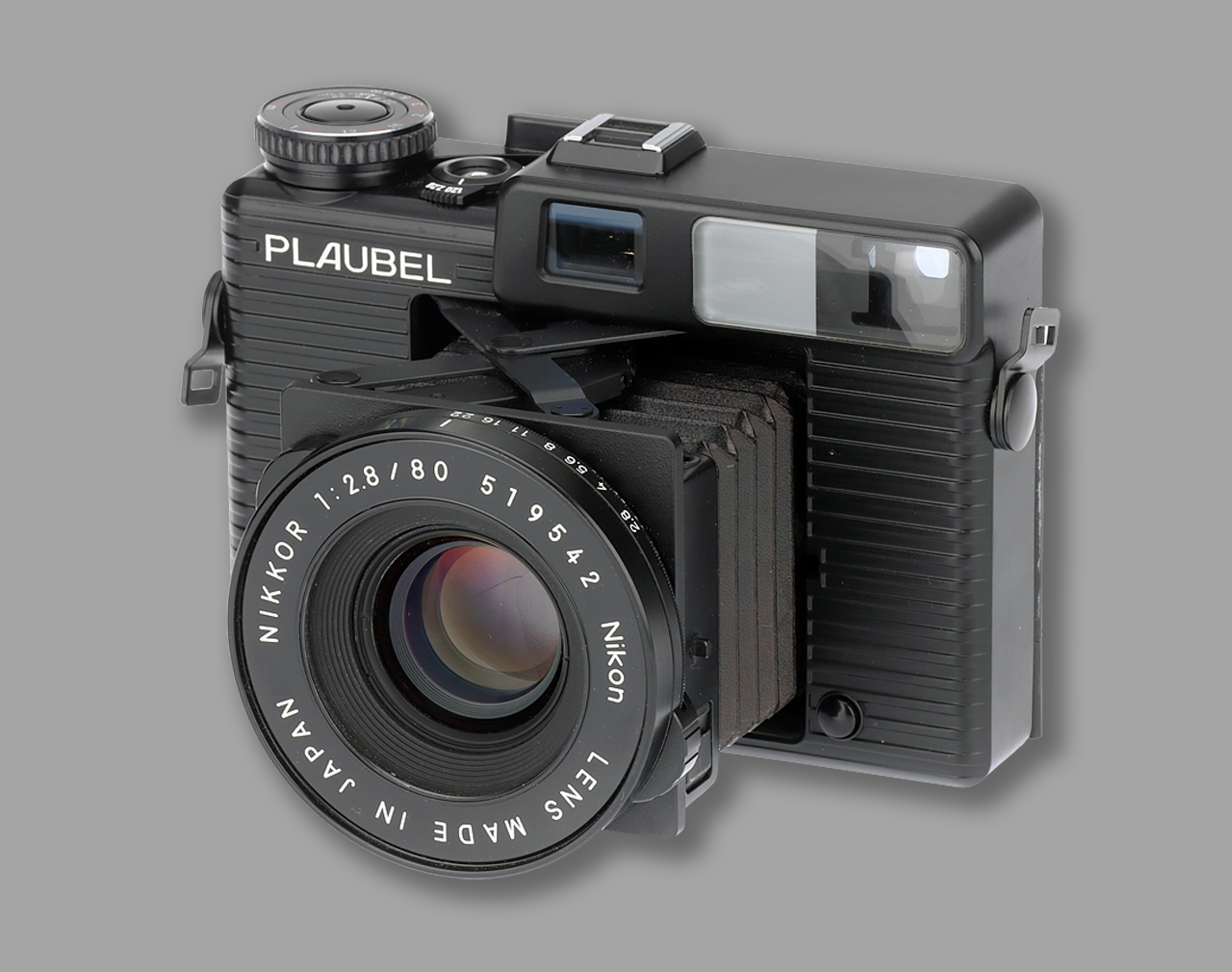
The picture shows a Plaubel Makina 670. The Plaubel Makina was a series of medium format press cameras. Makina cameras had leaf shutters and rangefinder focusing with collapsible bellows. Models 67 and 670 have Nikkor 80mm f/2.8 lenses. Both models take ten 6×7cm exposures on 120 rollfilm, while the 670 model also accepts 220 rollfilm (20 exposures per roll). Model W67 is similar to the 670 model, but with a wide-angle Nikkor 55 mm lens (roughly equivalent to a 28 mm lens in 135 format). The 55 mm lens was considered one of the sharpest and most flare-free of any produced in the analogue photography era.
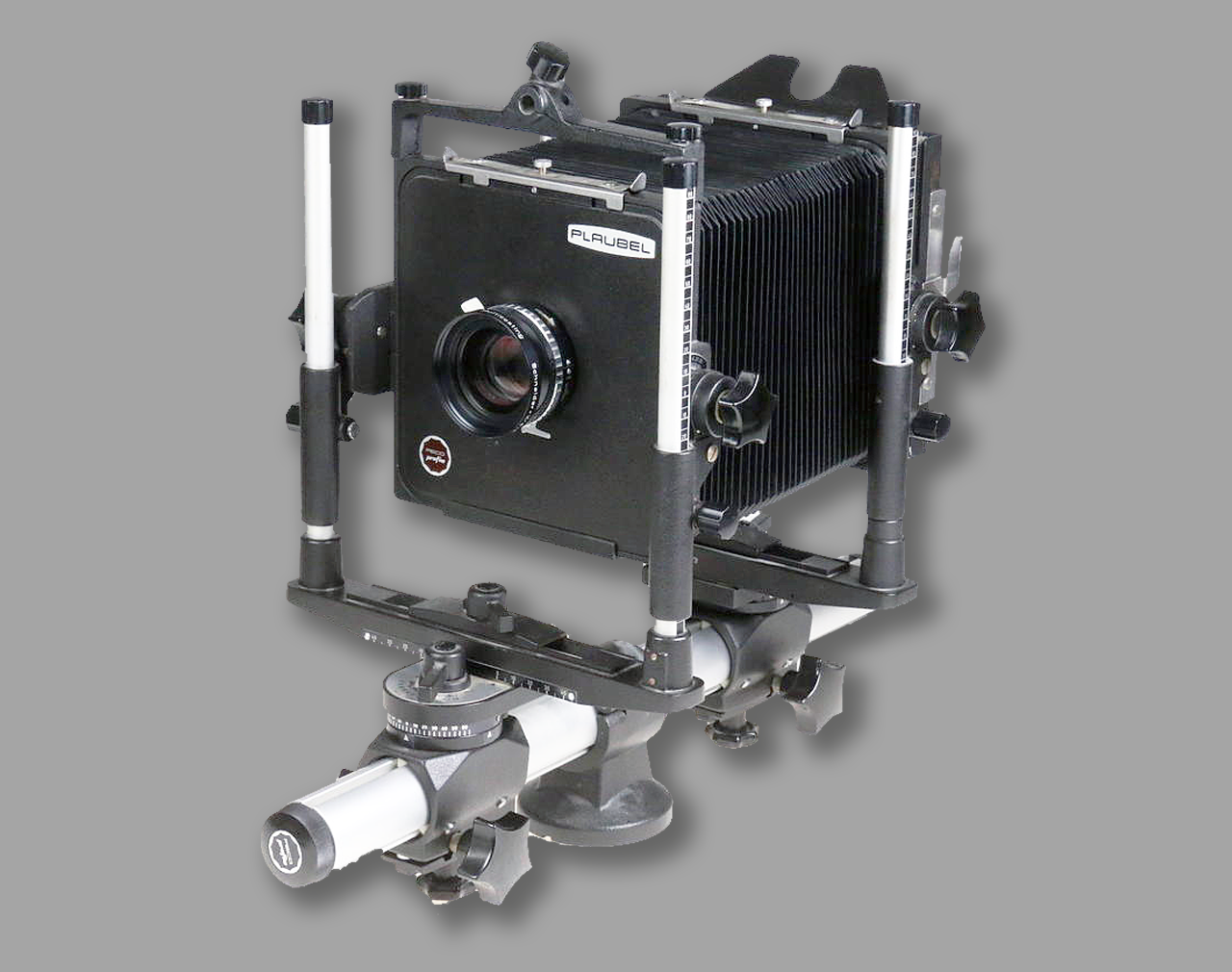
The image shows the Peco Profia, member of a series of eight large-format bellows view cameras, mounted on optical bench tubular or flat monorails of different lengths, varying in format from 9 x 12 cm (4″ x 5″) to 18 cm x 24 cm (8″ x 10″); all can be used with plate, sheet-film and roll-film and are capable of smaller formats down to 35 mm with appropriate accessories; each model features interchangeable pleated bellows or soft wide-angle bag bellows; detachable bellows allow cameras to be folded flat for transport or storage; each model offers selection of different interchangeable or extendable monorail lengths.
FOUNDING DATE: 1937
FOUNDERS: Edwin Herbert Land and George W. Wheelwright III
1937: Polaroid Corporation.
COMPANY ADDRESSES:
1937: 549 Technology Square, Cambridge, Massachusetts 02139; 1940: the B B Chemical Company building at 784 Memorial Drive in Cambridge, Massachusetts.
Polaroid Corporation, the world’s leader in the technology of instant imaging, sold more than 5 million cameras each year. Well-known the world over for its cameras that produce photos in seconds, Polaroid also was involved in the production of a wide range of related products including film, photography supplies such as filters and lenses, and professional imaging products.
Edwin Herbert Land
 As a child, Edwin Herbert Land, American physicist and inventor, born in Bridgeport, Connecticut, was drawn to the beauty and utility of chemistry and optics. Kaleidoscopes and stereoscopes, optical wonders of the 19th century, held a particular fascination for Land.
As a child, Edwin Herbert Land, American physicist and inventor, born in Bridgeport, Connecticut, was drawn to the beauty and utility of chemistry and optics. Kaleidoscopes and stereoscopes, optical wonders of the 19th century, held a particular fascination for Land.
While a freshman at Harvard University in 1926, he became interested in polarized light (light oriented in a plane with respect to the source). Taking a leave of absence, he developed a new kind of polarizer, which he called Polaroid, by aligning and embedding crystals in a plastic sheet.
Land returned to Harvard at the age of 19 but left again in his senior year to found a laboratory nearby. Joined by other young scientists, he applied the polarizing principle to light filters, optical devices, sunglasses, glare-free automobile headlights, stereoscopic photography and motion picture processes.
Photography giant Eastman Kodak provided the company’s first financial break when it made a $10,000 order for photographic polarizing filters, later dubbed Polafilters. These plates, which consisted of a sheet of polarizing material sealed between two glass discs, increased contrast and decreased glare in photographs taken in bright light. Land-Wheelwright accepted the order and delivered the filters to Kodak. By this time, a friend, Professor Clarence Kennedy of Smith College, had dubbed the material “Polaroid,” and the name was adopted.
 Land’s most popular use for polarizing filters was found in instant cameras and film.
Land’s most popular use for polarizing filters was found in instant cameras and film.
Land’s polarizing filters also found use outside of cameras. They are used in 3D glasses and to control brightness through a window which is a necessary component of LCD-lighting. In the late 1940s it introduced the first model of its most successful product, the self-developing Polaroid Land camera and associated film.
The company also put out a microscope for viewing living cells in natural colour. For his contributions to the fields of polarized light, photography, and colour perception, Land received numerous awards and honorary degrees.
In 1937 Land formed Polaroid Corporation with Land as president and head of research to acquire the operations that he and George Wheelwright had begun. Eight original shareholders fronted $375,000 to back Land and his projects. They invested in Land and his ideas, allotting him a voting trust of stock that gave him control of the company for the next decade.
Wheelwright left the company in 1940 to become a navy lieutenant and never rejoined the company. Through his Polaroid Corporation Land was immortalized, for his invention and marketing of instant photography.
During World War II the corporation turned to military tasks, inventing infrared filters, dark-developing goggles, target finders, and the Vectrograph. The Vectrograph used a stereoscopic viewing system to view the camouflaged positions of enemy combatants.
The birth of a legendary system
 Even before the end of the war, however, Land was working on a research project that was to transform his already successful business. His source of inspiration was his three-year-old daughter, Jennifer: in 1944, whilst on a family holiday in Santa Fe, New Mexico, she asked him why she couldn’t see a photograph of her which he had just taken. Land stated later: ‘As I walked around the charming town I undertook the task of solving the puzzle she had set me. Within an hour, the camera, the film and the physical chemistry became so clear to me.’
Even before the end of the war, however, Land was working on a research project that was to transform his already successful business. His source of inspiration was his three-year-old daughter, Jennifer: in 1944, whilst on a family holiday in Santa Fe, New Mexico, she asked him why she couldn’t see a photograph of her which he had just taken. Land stated later: ‘As I walked around the charming town I undertook the task of solving the puzzle she had set me. Within an hour, the camera, the film and the physical chemistry became so clear to me.’
Land’s system required a new kind of camera and film, a system that would compress all of the components of a conventional darkroom into a single film unit, to be processed in under a minute after being ejected from the camera. If successful, the system would allow users to evaluate and share images moments after they had been taken, a transformational change from traditional photography.
It was to take nearly three years of intensive research before Land was able to demonstrate his one-step system of photography at a meeting of the Optical Society of America in February 1947.
Newspapers covering the event called the invention “revolutionary.” The following year was dominated by resolving challenges the company faced in bringing the system from the laboratory to commercial-scale manufacturing. Called the Land Camera Model 95, it was in commercial sale less than two years later.
PICTURES IN 1948… READY WHILE YOU WAIT!
Polaroid originally manufactured sixty units of its first camera. It was a large, heavy (it weighs about 4lb/18kg) camera of conventional folding design, fitted with an f/11, 135mm lens and a shutter giving speeds from 1/8 to 1/60sec.
Fifty-seven were put up for sale at Boston’s Jordan Marsh department store before the 1948 Christmas holiday. Polaroid marketers incorrectly guessed that the camera and film would remain in stock long enough to manufacture a second run based on customer demand.
All fifty-seven cameras and all of the film were sold on the first day of demonstrations. By the time this first Model 95 was discontinued in 1953, it is estimated that around 900,000 had been sold.
The company’s common stock was listed on the New York Stock Exchange in 1957. Polaroid formed its first international subsidiaries in 1959, in Frankfurt and Toronto. In 1960 it established Nippon Polaroid Kabushiki Kaisha in Japan and licensed a Japanese firm to produce two cameras for overseas sale.
Over the next few years, new models of Polaroid cameras appeared at regular intervals and within ten years the one-millionth Polaroid Land camera had been sold. Reflecting Edwin Land’s ever-fertile mind, Polaroid cameras were notable for their innovative use of new technology.
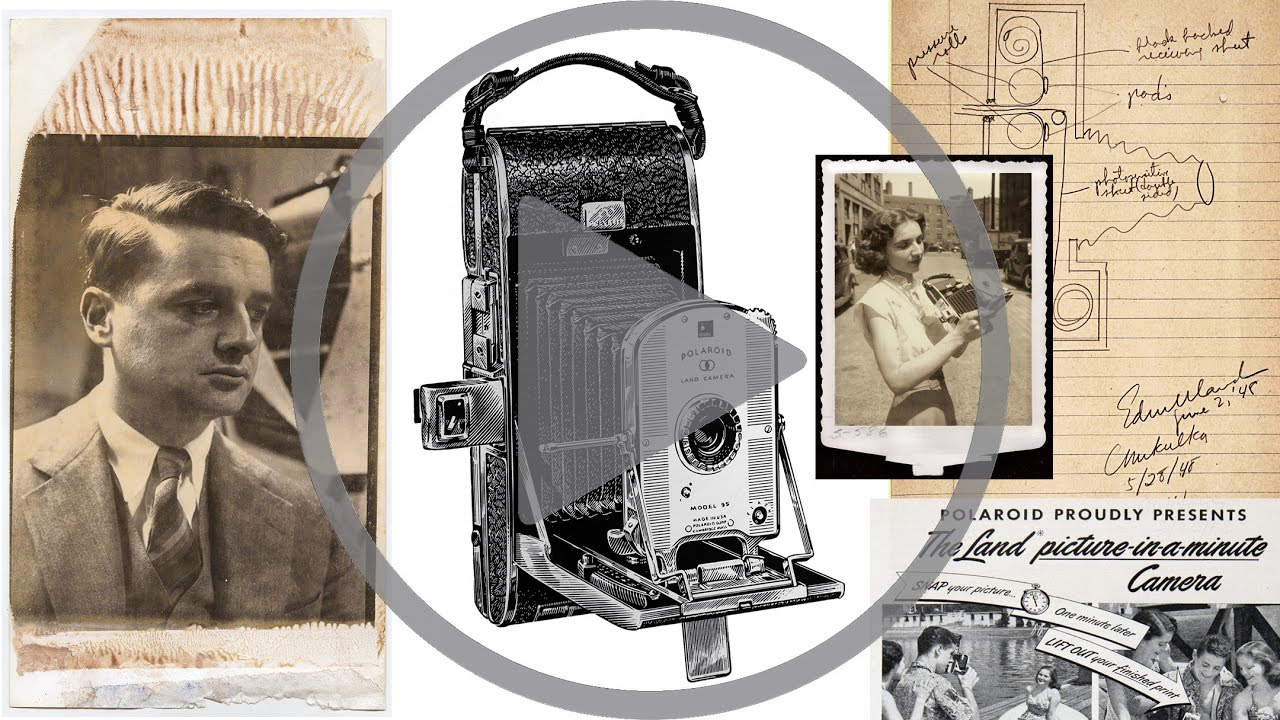
A collage of photos, drawings and advertisements about Polaroid in the 1950s.
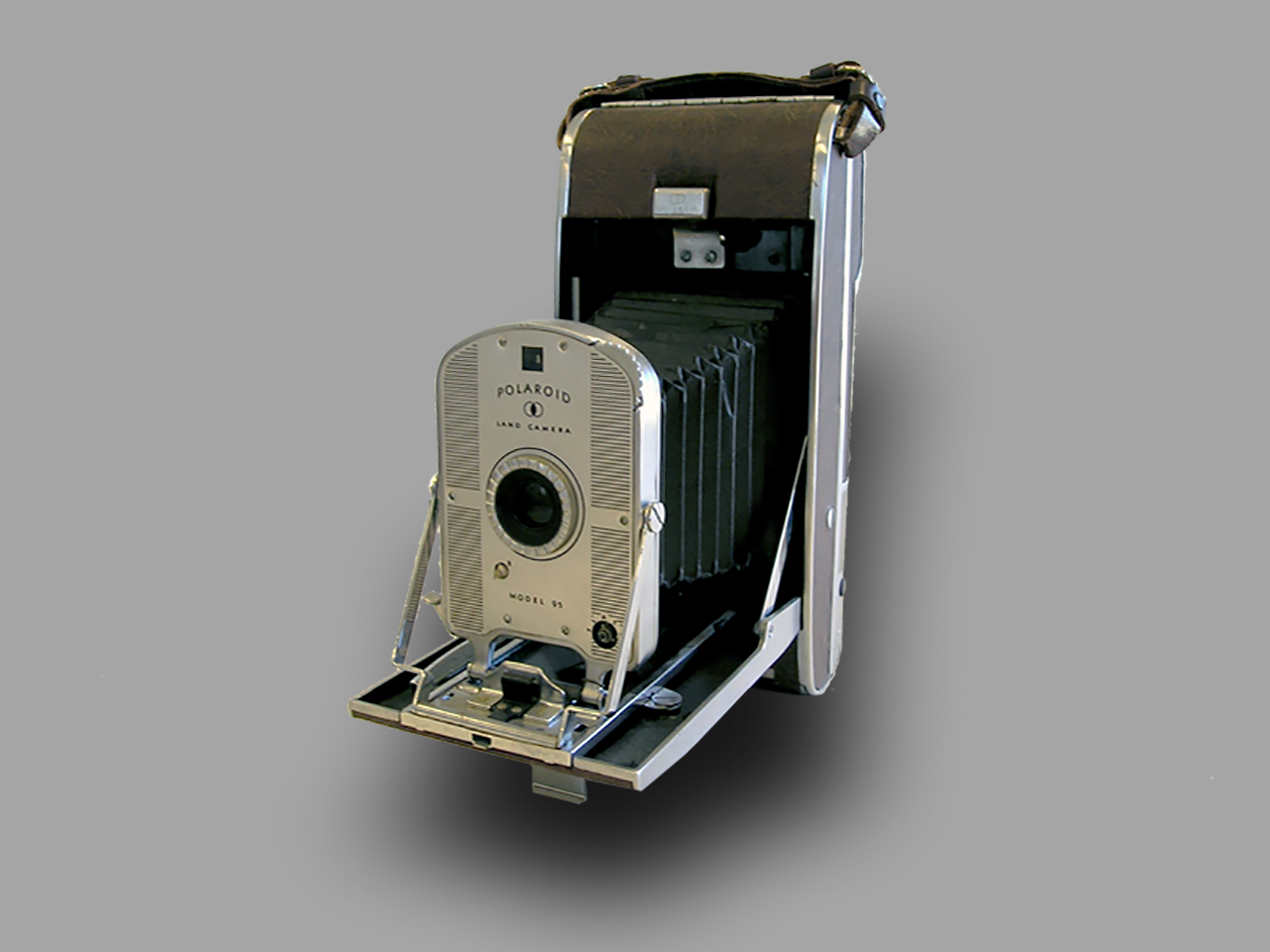
The Model 95 is the first of Polaroid’s instant picture cameras. Starting in 1948 the Polaroid Corporation made at least 1.5 million of the Model 95 folding viewfinder camera for his instant roll film, including the variants, Model 95A (1954) and 95B (1957). The first of these is recognizable having a spring sighting pin as part of the viewfinder, while the later model 95A and 95B have a wire frame. The 95B also uses EV numbers for the exposure scale. The model name is written on the face plate of the camera.
Finally in 1972… the SX-70;
the culmination of Land’s 1943 dream of absolute instant photography!
Introduced in 1963, the Automatic 100 embodied two important innovations. It was the first camera to have a fully automatic (hence the name) electronic shutter, and it was also the first camera to take Polaroid film packs (for eight exposures) rather than roll film which greatly simplified loading. Unlike earlier models, development took place outside the camera before the negative and positive sheets were peeled apart.
Polaroid’s first colour film was introduced in 1963, along with a pack-loading black-and-white film. In 1965 the inexpensive Swinger was pitched to teens. Selling for less than $20, the camera took only black-and-white pictures, sustaining the market for Polaroid black-and-white film.
In 1966 the ID-2 Land Identification system was introduced. It produced full-colour laminated cards in two minutes, allowing the company to provide instant driver’s licenses and other photo identification cards.
In 1967 Polaroid began construction on several new factories to boost production of cameras, film, colour negatives, and chemicals. The company’s stock split two for one in 1968. During the late 1960s Polaroid was outpacing other top stock market performers. In 1970 sales reached $500 million.
 The crowning chapter of the Polaroid system was the development of the SX-70 camera and film in 1972. Many SX-70 models were offered, including ones with sonar autofocus. The project represented ultimate simplicity with dry films and reward for photographers—all they had to do was press the camera button and watch as the image developed before their eyes in bright (day)light. When it was first sold in 1972, the product represented the culmination of Land’s 1943 dream of absolute instant photography.
The crowning chapter of the Polaroid system was the development of the SX-70 camera and film in 1972. Many SX-70 models were offered, including ones with sonar autofocus. The project represented ultimate simplicity with dry films and reward for photographers—all they had to do was press the camera button and watch as the image developed before their eyes in bright (day)light. When it was first sold in 1972, the product represented the culmination of Land’s 1943 dream of absolute instant photography.
Until this point, Polaroid films required a step that interfered with Land’s vision of absolute one-step photography: After being ejected from the camera, the user had to peel back the negative sheet to reveal the final photograph. Some early films required additional steps by the user, such as swabbing the developed image with a coating to stabilize it or adhering the image to a hard backing to prevent curling.
Polaroid under a new president
 In 1975 Land turned the presidency of Polaroid over to Bill McCune, a senior vice-president who had been with the company since 1939 and had worked closely with Land on the development of the first instant camera and film. Land received his 500th patent and was inducted to the National Inventors Hall of Fame in 1977.
In 1975 Land turned the presidency of Polaroid over to Bill McCune, a senior vice-president who had been with the company since 1939 and had worked closely with Land on the development of the first instant camera and film. Land received his 500th patent and was inducted to the National Inventors Hall of Fame in 1977.
Polaroid’s corporate culture began to shift when McCune was voted chief executive officer in 1980. While Land’s entrepreneurial drive had created the company, a more diversified, market-oriented management was needed to continue to propel it.
Land ran the company until 1981. Its peak employment was 21,000 in 1978, and its peak revenue was $3 billion in 1991. In 1982 Land retired fully, devoting his attention to research at the Rowland Institute for Science, which he had founded in 1965.
In 1976 Polaroid entered a costly and lengthy patent-infringement battle with Eastman Kodak Company. Kodak had been producing the negative component of Polaroid’s black-and-white film since 1944, and its color negative since 1957.
 With the introduction of the Polaroid SX-70, though, Kodak terminated its partnership with Polaroid, and began its own instant-photography research. In 1976 Kodak introduced the EK-4 and EK-6 instant cameras and PR-10 instant film. Polaroid filed suit within a week, charging 12 patent infringements in camera film and design.
With the introduction of the Polaroid SX-70, though, Kodak terminated its partnership with Polaroid, and began its own instant-photography research. In 1976 Kodak introduced the EK-4 and EK-6 instant cameras and PR-10 instant film. Polaroid filed suit within a week, charging 12 patent infringements in camera film and design.
Legal preparations dragged on for five years, until the trial began in October of 1981. Ten of the twelve original counts were pressed. After 75 days of testimony and three years of deliberation, U.S. District Court Judge Rya Zobel ruled that seven of the ten Polaroid patents were valid and had been infringed upon. As a result, Kodak’s line of instant-photography products was terminated in 1986.
When settlement talks began, Polaroid claimed about $6.1 billion in damages, lost sales, and interest. The case was not settled until 1991 and resulted in a payment by Eastman Kodak of $925 million.
The company’s common stock was listed on the New York Stock Exchange in 1957. Polaroid formed its first international subsidiaries in 1959, in Frankfurt and Toronto. In 1960 it established Nippon Polaroid Kabushiki Kaisha in Japan and licensed a Japanese firm to produce two cameras for overseas sale.
Over the next few years, new models of Polaroid cameras appeared at regular intervals and within ten years the one-millionth Polaroid Land camera had been sold. Reflecting Edwin Land’s ever-fertile mind, Polaroid cameras were notable for their innovative use of new technology.
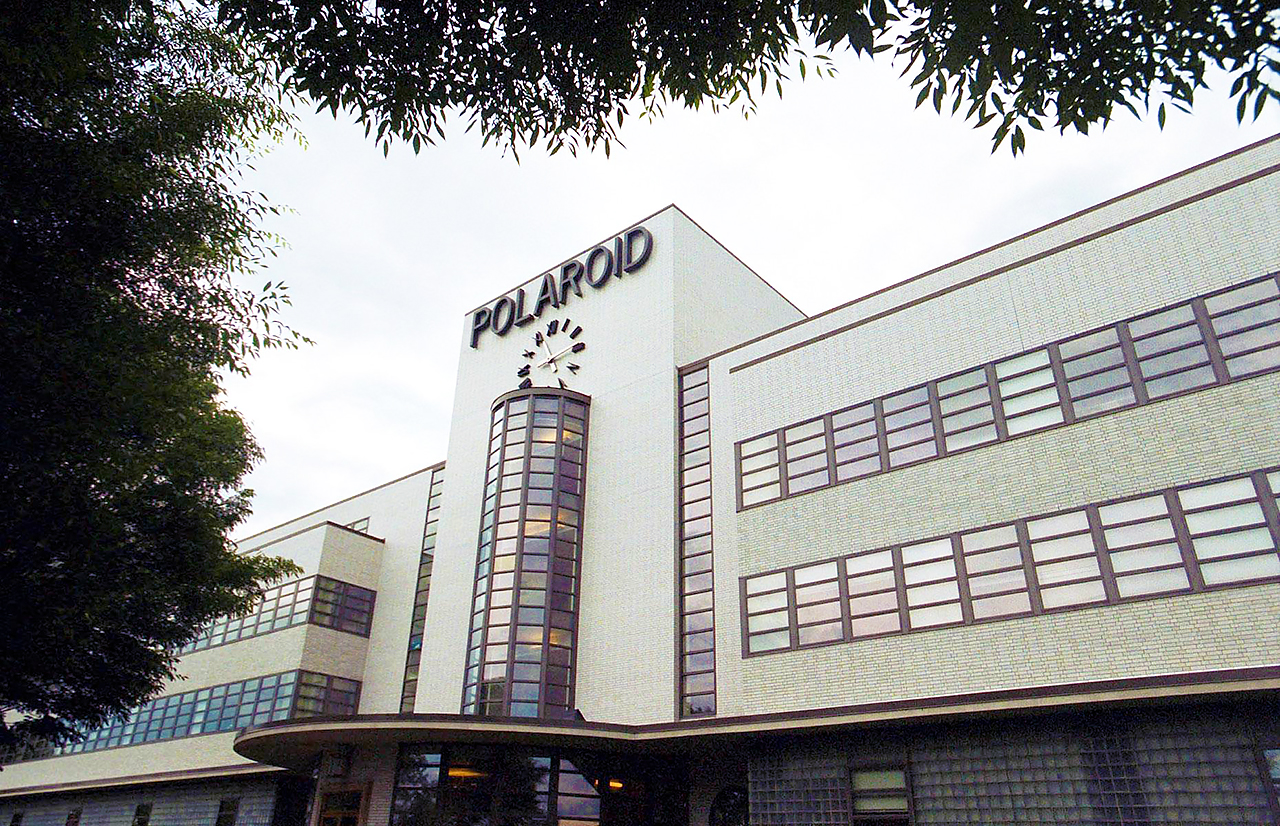
Polaroid Headquarters in the 90s.
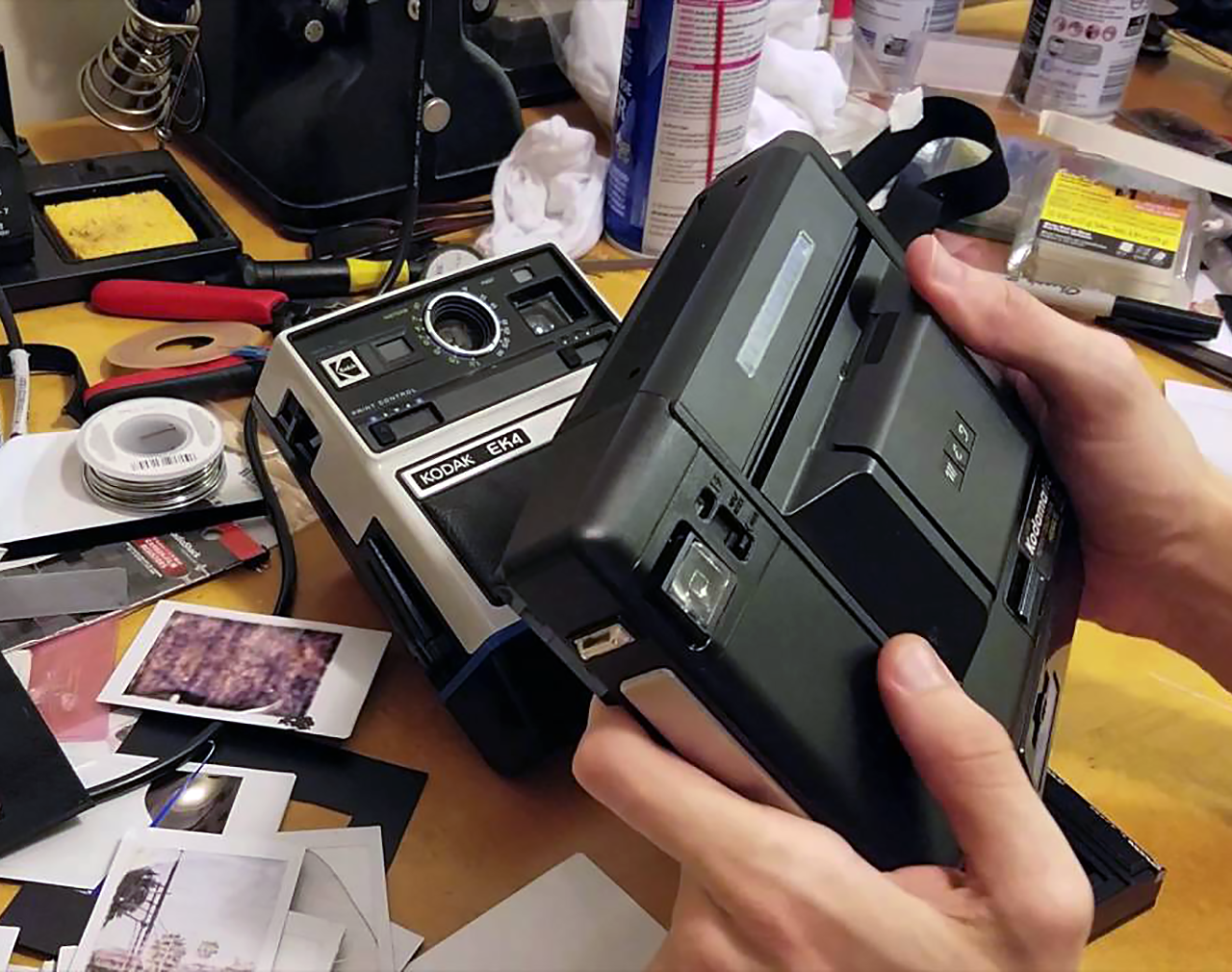
Introduced in 1977 as Kodak’s answer to Polaroid’s domination of the instant picture market, the film technology was almost immediately challenged by Polaroid as a patent infringement. The long-ensuing legal wrangling finally ended in 1986 when Kodak were forced to withdraw from the instant picture market, leaving very many cameras, (16.5 million, according to one source), with no film. Camera owners were offered various degrees of compensation in exchange for their now useless cameras, which Kodak then apparently destroyed.
the first signs of decline are appearing…
During 1977 was the height of the instant camera’s popularity, but around 1979 Polaroid cameras started to decline in popularity. There were newer, smaller, and less expensive cameras and recording devices being introduced which was the birth of the digital photography age.
In the 1980s, Polaroid tried to reinvent itself without Land at its helm by shifting away from a dependence on consumer photography, a market which was in steady decline. Chairman McCune and I. MacAllister Booth, who had become president in 1983 and CEO in 1985 pruned Polaroid staff in the early 1980s and reorganized the company into three divisions: consumer photography, industrial photography, and magnetic media. In 1984 Polaroid announced “that it would enter the United States electronic video market with its own line of Polaroid videotapes.”
The first success reaped from this new marketing strategy was the Spectra, introduced in 1986. The upscale Spectra came out of market research indicating that instant camera users wanted better picture quality. Again responding to this desire, Polaroid introduced Hybrid IV, an instant film of near 35-millimeter quality, during the early 1990s.
 Polaroid also introduced a line of conventional film and videotapes starting in 1989. Marketing strategies also continued to become more sophisticated. In 1990 a $60 million advertising campaign emphasized new uses for instant cameras.
Polaroid also introduced a line of conventional film and videotapes starting in 1989. Marketing strategies also continued to become more sophisticated. In 1990 a $60 million advertising campaign emphasized new uses for instant cameras.
Suggested uses include recording household items for insurance purposes or keeping a visual record of properties when house-hunting. In addition, the company cultivated its non-consumer markets, which contribute at least 40 percent of photographic sales.
At the dawn of the 21st century, the Polaroid Corporation has become the world market leader in instant photography, electronic imaging, and a major world manufacturer and marketer of conventional films, videotapes, and light polarizing filters and lenses.
Such a high proportion (approximately half) of Polaroid’s revenues derive from international sales that the company survived the worst year of the U.S. recession, 1991, with flying colours, making the recession period one of the best ever in terms of sales. For the first time in Polaroid’s history, the $2 billion dollar sales mark had been surpassed.
With the resurgence of the domestic economy and the onset of recession in Europe and Japan, the company expects its global positioning to assist in its financial performance. By the mid-1990s, the company will have undergone the biggest plant expansion in its history that includes the construction of its first ever facility for the production of advanced films for Polaroid’s new electric imaging products.
New products, marketing and advertising must help to survive
 Along with major plant expansion, Polaroid has embarked on a new marketing and advertising strategy that targets market segments (business, health, industry, education, family) and promotes new products designed specifically for these segments. In fact, the blitz of new Polaroid products has surprised market analysts accustomed, over the past two decades, to criticizing Polaroid’s stagnation and moribund sales.
Along with major plant expansion, Polaroid has embarked on a new marketing and advertising strategy that targets market segments (business, health, industry, education, family) and promotes new products designed specifically for these segments. In fact, the blitz of new Polaroid products has surprised market analysts accustomed, over the past two decades, to criticizing Polaroid’s stagnation and moribund sales.
Polaroid products fall under the categories of core photography and high resolution imaging. Polaroid clearly has shifted away from its total reliance on its historical mainstay, the instant camera. Gone forever are the days of focusing on a single product. A series of new electronic imaging products also have been developed for the business segment, including desktop computer film recorders, the Polaroid CI-5000 and CI-3000, and the CS-500Í Digital Photo Scanner. In addition, Polaroid has developed the ProCam, an instant camera earmarked for the business customer.
 For the nonprofessional or amateur consumer, the long awaited “Joshua” instant camera was introduced first in Europe in 1992, and then in the USA as “Captiva” in the summer of 1993. Captiva, indistinguishable in appearance from a 35 millimeter camera, takes high quality instant photos that are not ejected in the usual manner, but stored in the rear of the camera, which in turn contains a viewing window enabling the user to see the development of the last exposed frame.
For the nonprofessional or amateur consumer, the long awaited “Joshua” instant camera was introduced first in Europe in 1992, and then in the USA as “Captiva” in the summer of 1993. Captiva, indistinguishable in appearance from a 35 millimeter camera, takes high quality instant photos that are not ejected in the usual manner, but stored in the rear of the camera, which in turn contains a viewing window enabling the user to see the development of the last exposed frame.
“HighDefinition” instant film for the amateur photographer came on the market in 1992, further closing the gap in quality between 35 millimeter and instant film. Despite market analyst predictions, Polaroid Corporation has transformed itself into a company of the future: a streamlined, multinational, and diverse, multi-product company.
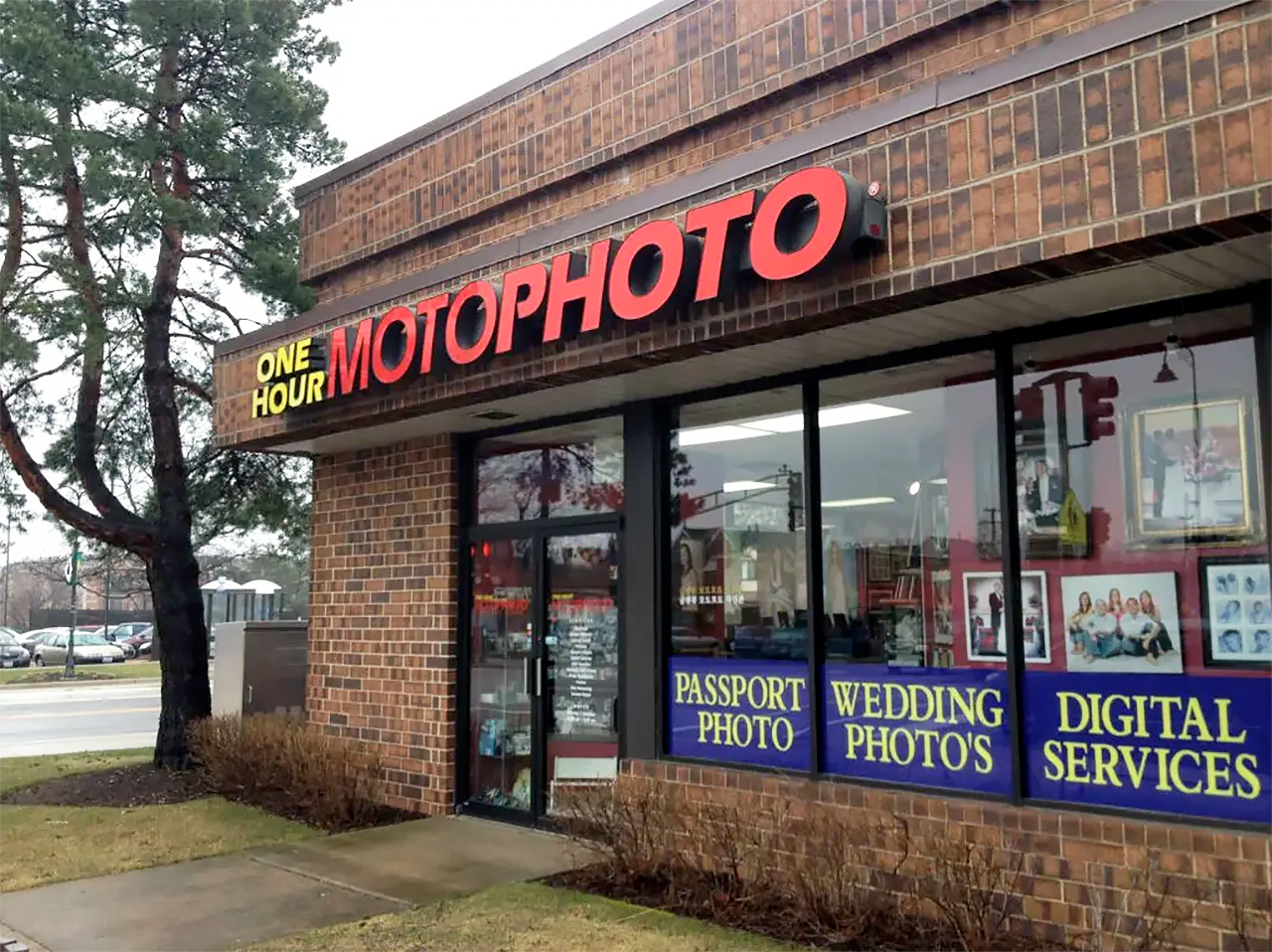
A threat of the worst kind in the late 90s, early 21st century: the 1 hour photo shops.
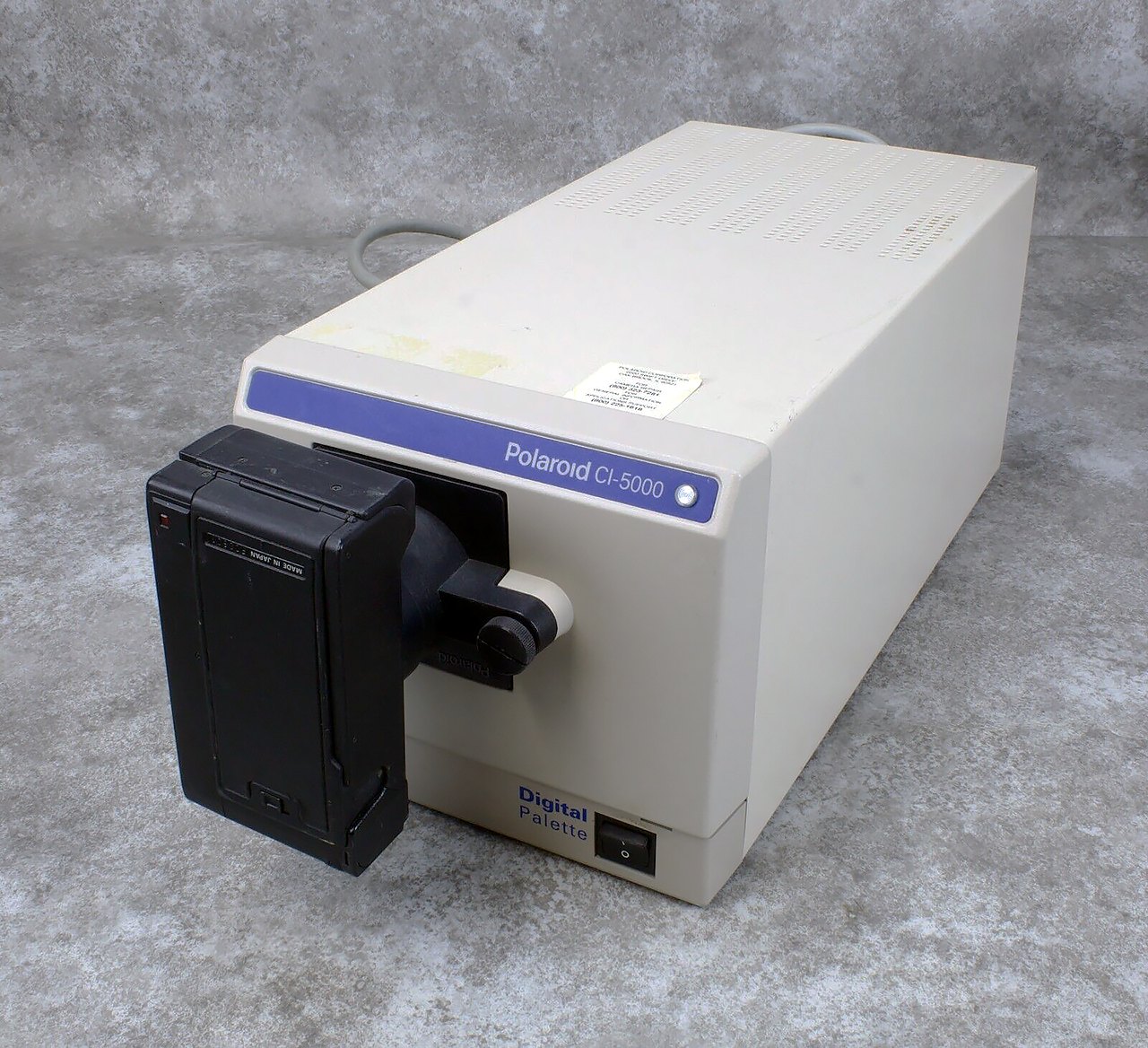
Polaroid CI5000 Digital Palette Color Film Recorder
The Polaroid Palette and Polaroid ProPalette are a series of digital film recorders from Polaroid Corporation. The idea is to print a digital image onto a regular 24x36mm frame of 35mm film. The line started in the early 1980s, using 35mm film to produce slides for presentations. It was a primitive solution prior to the LCD projector, but with some Polachrome 35mm it could be a really fast one for that era. All versions of GEM provide drivers. There were various models, namely: Polaroid Palette, Polaroid Palette Plus, Polaroid HR-6000, Polaroid ProPalette 7000, Polaroid ProPalette 8000 and Polaroid Palette ColorTune.
Troubles Mounted as the 1990s continued
In the mid-to-late 1990s Polaroid faced an increasingly uncertain future. Overall sales were stagnant—the $2.15 billion figure of 1992 being repeated in 1997, before a more dismal result was announced for 1998: $1.89 billion. Demand for instant film was on the decline, in part because of the rapid growth of one-hour photo shops for conventional film, and the company’s other forays were less than total successes.
 The Captiva had a very strong debut, but then sales dropped off and Polaroid cut back production. Booth retired in late 1995 and was replaced as chairman and CEO by Gary T. DiCamillo, who had been an executive at the Black & Decker Corporation, where he earned a reputation for cost-cutting, improving productivity, and rapidly developing new products.
The Captiva had a very strong debut, but then sales dropped off and Polaroid cut back production. Booth retired in late 1995 and was replaced as chairman and CEO by Gary T. DiCamillo, who had been an executive at the Black & Decker Corporation, where he earned a reputation for cost-cutting, improving productivity, and rapidly developing new products.
Soon after taking over, DiCamillo initiated a restructuring at Polaroid, which included a workforce cut of about 15 percent, or 1,570 jobs, and a charge of $247 million for 1995, leading to a net loss of $140.2 million for the year. DiCamillo also overhauled the company’s management team, bringing in additional marketing and product development-oriented leaders from such firms as RJR Nabisco and Kraft Foods.
Further changes came in 1996 when Polaroid largely abandoned its venture into medical imaging, an area in which it had invested about $800 million, when it sold the bulk of its loss-making Helios unit to Sterling Diagnostic Imaging Inc. This sale led in part to a $33 million charge recorded in 1996, a year in which the company reported a net loss of $41.1 million.
Big net losses and a big loss of jobs
The new management team at Polaroid concentrated on rolling out 30 to 40 new products each year, aiming to diversify the company’s offerings. These included a disposable flashlight, alkaline batteries, and a new line of polarized sunglasses. In December 1997, meanwhile, Polaroid announced an additional workforce reduction of 15 percent, or about 1,500 jobs. The company took another restructuring charge of $323.5 million, resulting in a 1997 net loss of $126.7 million.
During 1998 Polaroid announced additional job cuts of 600 to 700 employees, took a restructuring charge of $50 million, and posted a net loss of $51 million. The worldwide economic difficulties that began in 1997 proved particularly troublesome for Polaroid, which had long generated a significant portion of its revenue outside the United States. The hardest hit market for Polaroid was Russia, which had been the company’s second largest market in 1995, accounting for $200 million in revenues; for 1998 Polaroid sold only about $25 million worth of goods in that economically troubled nation.
As Polaroid’s red ink continued to flow, speculation about a possible takeover was rife. In addition, while DiCamillo had initially emphasized broadening the company’s product mix when he came on board, he announced in early 1999 that he was considering selling four business units—sunglasses, graphic arts, glare-reducing polarizers, and holography—that had been key components of his diversification efforts.
DiCamillo said that he wanted to focus the company on its core instant photography business. The emphasis would also be on the consumer market, with particular attention given to developing youth-oriented instant cameras, such as the I-Zone Instant Pocket Camera, which was a slender camera that produced miniature instant prints. The Pocket Camera had been a great success following its May 1998 debut in the Osaka region of Japan, and would be released in the United States in the summer of 1999. Other products the company was banking its future on included PopShots, the first instant one-time-use camera; and the JoyCam, a smaller, economically priced version of Polaroid’s standard instant camera. The company was also attempting to win the race to develop the first digital camera with an instant print. But the larger question that especially clouded Polaroid’s future was whether instant photography was becoming technologically obsolete.
The work Leo Burnett did for Polaroid promoting the I-Zone, the JoyCam, and sticky film was successful in a number of ways. When the campaign broke in 2000 Polaroid experienced an immediate jump in sales, and research indicated that the target market liked the products a great deal, suggesting that they would not fade away like many fads. Leo Burnett also received industry recognition for some of the work it did over the course of two years. It received a 2001 Effie Award from the New York American Marketing Association. In 2002 the agency was a finalist for a Magazine Publishers of America Kelly Award and, among other distinctions, received the Best of Show and Award of Excellence in the Chicago Windy Awards, the Art Director’s Club of New York 2002 Merit, and Gold and Silver ADDY Awards, given out by the American Advertising Federation. Leo Burnett’s hijacking work in 2003 was also an MPA Kelly finalist.
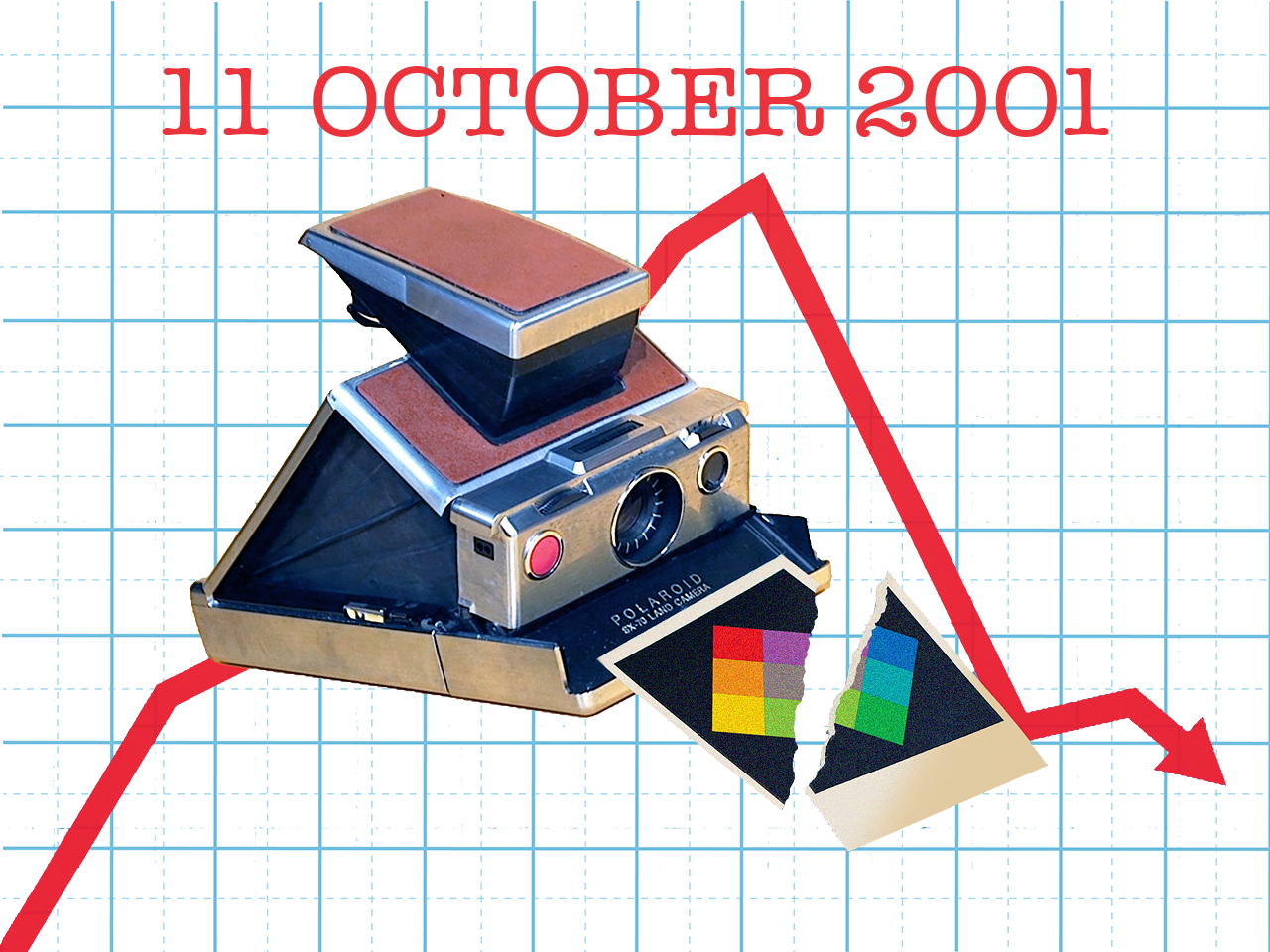
11 October 2001: Polaroid filed (for the first time) for federal bankruptcy protection.

At the beginning of the 21st century, a new line of “eyewear” was supposed to help raise the declining sales figures.
Polaroid in the digital era
Despite its history of innovation, the company entered the digital photography market very late in the game, and as a result has neither a significant market share nor significant innovation in this area. The company was in fact one of the early manufacturers of digital cameras, with the PDC-2000 in 1996; however, it failed to capture a large market share in that segment.
It also made 35 mm and multi format scanners, such as Polaroid SprintScan 4000 35 mm scanner (the first scanner with a 4000 DPI CCD) in 1999, and the Polaroid PrintScan 120 in 2000. The scanners received mixed reviews and saw heavy competition from Nikon and Minolta products. The entire line was discontinued when Polaroid entered bankruptcy in 2001.
Professional applications of the Polaroid instant film and cameras were as screen-shot cameras for scientific instruments, passport/identity photos, or large format cameras of other manufacturers equipped with Polaroid sheet film holders or pack film backs. Polaroid shots were often used to test studio lighting setups before use of other types of film or camera, before the instant playback of digital cameras became available.
The company filed for federal bankruptcy protection in October 11, 2001, and most of the business was thereafter carried on by the Polaroid Holding Company (PHC), managed by Bank One. Significant criticism surrounded this takeover because the process left executives of the company with large bonuses, while stockholders, as well as current and retired employees, were left with nothing. Polaroid’s bankruptcy was widely believed to be the result of the failure of its senior management to see the effect of digital cameras on its film business, a fate that also befell its primary rival, Kodak.
On April 27, 2005, Petters Group Worldwide announced its acquisition of Polaroid Holding Company. Petters has in the past bought up failed companies with well-known names for the value of those names. The same year, Flextronics purchased Polaroid’s manufacturing operations and the decision was made to send most of the manufacturing to China. In January 2009 Polaroid introduced the digital instant camera PoGo TWO, a variant of Polaroid’s innovative portable PoGo photo printer with built-in digicam. The very compact PoGo printers use special Zink paper for ink-free printing.
In February 2008, Polaroid filed for Chapter 11 bankruptcy protection for the second time and announced it would discontinue production of its instant films and cameras, shut down three manufacturing facilities, and lay off 450 workers. Sales of the analogue film by all makers dropped by at least 25% per year in the first decade of the 21st century. In 2009, Polaroid was acquired by PLR IP Holdings, LLC make which uses the Polaroid brand to market various products often relating to instant cameras. Among the products it markets are a Polaroid branded Fuji Instax instant camera, and various digital cameras and portable printers.
As of 2017, film continues to be made by the Polaroid Originals (previously the Impossible Project) for several models of Polaroid camera, and for the 8×10 inch format. Other brands such as Lomography, Leica, Fujifilm, and others have innovated new models and features to their own takes on instant cameras.
Overview of the different types of Polaroid cameras
and some interesting facts about Polavision and Polaroid FLOPPY DISKS
Polaroid cameras can be classified by the type of film they use. The earliest Polaroids (pre-1963) used instant roll film. Roll film came in two rolls (positive/developing agent and negative) which were loaded into the camera and was eventually offered in three sizes (40, 30, and 20 series).
The next generation of Polaroid cameras used 100 series “pack film,” where the photographer pulled the film out of the camera, then peeled apart the positive from the negative at the end of the developing process. Pack film initially was offered in a rectangular format (100 series), then in square format (80 series).
Third generation Polaroids, like the once popular SX-70, used a square format integral film, in which all components of the film (negative, developer, fixer, etc.) were contained. Each exposure developed automatically once the shot was taken. SX-70 (or Time Zero) film had a strong following with artists who used it for image manipulation.
Roll film 40 Series
3.25×4.25-inch, 83×108mm
These cameras took Polaroid Picture Roll Land film, which was discontinued in 1992. Some of these cameras can be converted to take pack film, but others cannot.
- Model 95 (1948–1953)
- Model 95A “Speedliner” (1954–1957)
- Model 95B “Speedliner” (1957–1961)
- Model 100 “One Hundred” (1954–1957)
- Model 110 “Pathfinder” (1952–1957)
- Model 110A “Pathfinder” (1957–1960)
- Model 110B “Pathfinder” (1960–1964)
- Model 120 (1961–1965)
- Model 150 (1957–1960)
- Model 160 (1962–1965)
- Model 700 (1955–1957)
- Model 800 “The 800” (1957–1962)
- Model 850 (1961–1963)
- Model 900 (1960–1963)
- Model J66 (1961–1963)
Roll film 30 Series
2.5×3.25-inch, 64×83mm
- Model 80 “Highlander” (1954–1957)
- Model 80A “Highlander” (1957–1959)
- Model 80B “Highlander” (1959–1961)
- Model J33 (1961–1963)
POLAROID FLOPPY DISKs
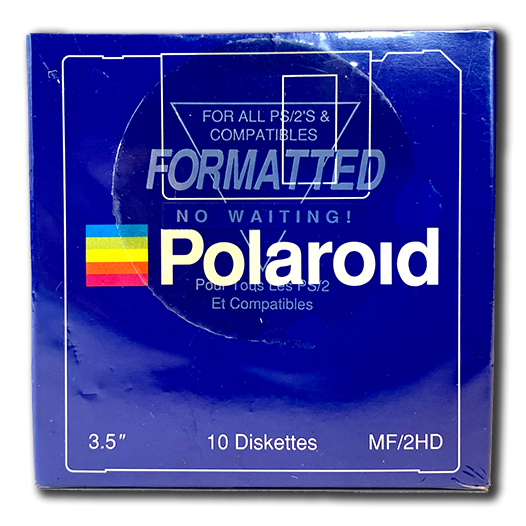
In 1985, Polaroid had its own brand of 5+1⁄4-inch floppy disks (Diskettes), and also a data recovery service. In 1987, The New York Times described it as a major brand. In 1985, The New York Times listed it a notch lower in an almost reverse alphabetical list, and noted “remember that those companies established their reputations by selling other products, not diskettes.”
By mid 1991, they stopped selling floppy disks. The packaging used both Polaroid and PerfectData brands.
POLAvision
Polaroid also invented and manufactured an instant movie camera system was called Polavision. The kit included a camera, film, and a movie viewer. When the movie was shot, it would be taken out of the camera and then inserted into the viewer for development, then viewed after development. This format was close to Super 8 mm film.
The biggest disadvantage of the Polavision system was the low film speed (ASA 40), as well as requiring a special player to view the developed movie. It also lacked audio capability. Because of this, and combined with the advent of VHS video recorders, Polavision had a short history.
The Polavision debacle eventually caused the company to write off $89 million, including most of the manufactured products.
Roll film 20 Series
2.5×3.25-inch, 64×83mm
- Model 20 “Swinger” (1965–1970)
- Model M15 “Swinger Sentinel”
- Swinger II
Pack film (colorpack)
100 Series
folding cameras
2.875×3.75-inch, 72×95mm
- Model 100 (1963–1966)
- Model 101 (1964–1967)
- Model 102 (1964–1967)
- Model 103 (1965–1967)
- Model 104 (1965–1967)
- Model 125 (1965–1967)
- Model 135 (1965–1967)
Pack film (colorpack)
200 Series
folding cameras
2.875×3.75-inch, 72×95mm
- Image
- Image 2
- Image1200 (2004)
- Image Elite Pro
- Macro 5 SLR
- Image Pro (1995)
- Minolta Instant Pro (1996) Same as Image Pro, Build by Polaroid for Minolta
- Pro Cam (1996–2000)
- Spectra (1986)
- Spectra 2
- Spectra 1200i (2000–)
- Spectra 1200si (2000–)
- Spectra 1200FF (2001)
- Spectra Onyx (1987)
- Spectra Pro (1990–1998)
- Model 210 (1967–1969)
- Model 215 (1968–1970)
- Model 220 (1967–1969)
- Model 225 (1968–1970)
- Model 230 (1967–1969)
- Model 240 (1967–1969)
- Model 250 (1967–1969)
Pack film (colorpack)
300 Series
folding cameras
2.875×3.75-inch, 72×95mm
- Model 315 (1969–1971)
- Model 320 (1969–1971)
- Model 325 (1969–1971)
- Model 330 (1969–1971)
- Model 335 (1969–1971)
- Model 340 (1969–1971)
- Model 350 (1969–1971)
- Model 355 (1975)[2]
- Model 360 (1969–1971)
- Countdown M60 (1970)
- Countdown M80 (1970)
Pack film (colorpack)
400 Series
folding cameras
2.875×3.75-inch, 72×95mm
- Model 420 (1971–1977)
- Model 430 (1971–1977)
- Model 440 (1971–1976)
- Model 450 (1971–1974)
- Model 455 (1975–1976)
- Countdown 70 (1971–1973)
- Countdown 90 (1971–1973)
Pack film (colorpack)
Other folding cameras
2.875×3.75-inch, 72×95mm
- Model 180 (1965–1969)
- Model 185
- Model 185 Millennium (2000–)
- Model 190 (1974–1977)
- Model 195 (1974–1976)
- The Reporter (1977)
- EE100 (1977)
- EE100 Special
- ProPack
Pack film (colorpack)
Non-folding cameras
2.875×3.75-inch, 72×95mm
- 600 (1978)
- 600 SE (1978)
- Model 3000 “Big Swinger” (1968–1970)
- Big Shot (1971–1973)
- Clincher (1975)
- Clincher 2
- The Colorpack (1973–1975)
- Colorpack II (1969–1972)
- Colorpack III (1970–1971)
- Colorpack IV (1969–1971)
- Colorpack V “CP5” (1973–1975)
- Colorpack 100 (1975–1976)
- Colorpack 200 (1977–1978)
- Colorpack M6 (1970–1971)
- EE55 (1976–1977)
- EE58 (1977–1978)
- EE60 (1976–1977)
- EE66 (1976–1977)
- Instant 30 (1978)
- Memory Maker
- Minute Maker (1977)
- Minute Maker Plus (1977–1978)
- Super Colorpack (1971–1972)
- Super Colorpack IV (1971–1972)
- Super Colour Swinger III (1976–1978)
- Super Shooter (1975–1977)
- Super Shooter Plus (1975–1977)
PACK film 80 Series
2.75×2.875-inch, 69×72mm
- Colorpack 80 (1971–1976)
- Colorpack 82 (1971–1975)
- Colorpack 85 (1971–1975)
- Colorpack 88 (1971–1975)
- Colour Swinger (1975–1978)
- Colour Swinger II (1975)
- EE22 (1976–1977)
- EE33 (1976–1977)
- EE38 (1977–1978)
- EE44 (1976–1977)
- EE88 (1976)
- Electric Zip (1975–1978)
- Instant 10 (1978)
- Instant 20 (1978)
- Square Shooter (1971–1972)
- Square Shooter 2 (1972–1975)
- Square Shooter 4 (1972–1975)
- Super Colour Swinger (1975–1977)
- Super Colour Swinger II (1975–1978)
- Super Swinger
- Swinger EE (1976–1978)
- Zip (1974–1977)
- Viva with electronic flash No.M1183 (1984) for Caribbean market
Integral film SX-70
Folding cameras
These cameras included both folding SLRs and less expensive non-folding models. They take the SX-70 film, a format with a ~3.1 × 3.1 in² (77 × 77 mm) square image area and a ~4.2 × 3.5 in² (108 × 88 mm²) total area, and a sensitivity around ISO 160. They come with a built-in 6-volt zinc chloride “PolaPulse” battery pack, replaced with a lithium-ion pack in Polaroid B.V. remakes.
- SX-70 (1972–1977)
- SX-70 Alpha 1 (1977)
- SX-70 Alpha 1 Executive (1977)
- SX-70 Alpha 1 24 Kt Gold Mildred Scheel
- SX-70 Alpha 1 Model 2 (1977)
- SX-70 Executive (1975–1977)
- SX-70 Model 2 (1974–1977)
- SX-70 Model 3 (1975–1978)
- SX-70 Sonar OneStep (1978)
- SX-70 Sonar OneStep Gold
- TimeZero SX-70 AutoFocus (1981)
- TimeZero SX-70 AutoFocus Model 2 (1981)
Integral film SX-70
NON-Folding cameras
- Model 500
- Model 1000 (1977)
- Model 1000 S
- Model 1000 SE
- Model 1500 (1977)
- Model 2000 (1976)
- Model 3000 (1977)
- Encore (1977)
- Instant 1000
- Instant 1000 DeLuxe
- OneStep (1977)
- OneStep Plus
- Presto! (1978)
- Pronto! (1976–1977)
- Pronto! B (1977)
- Pronto! Extra (1977–1978)
- Pronto! Plus (1976–1977)
- Pronto! RF (1977)
- Pronto! S (1976–1977)
- Pronto! SM (1976–1977)
- Pronto! Sonar OneStep (1978)
- Sonar AutoFocus 5000
- Super Clincher
- Supercolor 1000
- Supercolor 1000 DeLuxe
- Supercolor AutoFocus
- Supercolor AutoFocus 3500
- The Button (1981)
- TimeZero OneStep (1981)
- TimeZero Pronto AF (1981)
Large-format
Sheet film cameras
- 20 × 24″ camera (1976)
- 40 × 80″ camera at Boston’s Museum of Fine Arts (1976)
Printing units
These are units that expose films using a smartphone display. They are optimized for 600/i-Type film packs, although SX-70 is also supported.
- Impossible Instant Lab (2013)
- Impossible Instant Lab Universal (2015)
- Polaroid Lab (2019)
Integral film 600
The 600 film have the same dimensions as that of the SX-70. The sensitivity is higher at around ISO 640. It also has a battery pack, for which Polaroid has released a small radio.
- 600 (2000s)
- 600 Business Edition
- 600 Business Edition 2 (2000–)
- 636 Double Exposure
- 636 CloseUp (1996)
- Amigo 610
- Amigo 620 (1982)
- Barbie Instant Camera (1999–2001)
- Bicentennial “We The People” (1987)
- Cool Cam (1988)
- Construction Camera
- Impulse (1988)
- Impulse AF (1988)
- Impulse QPS
- JobPro (1992)
- JobPro 2 (2000–)
- NightCam
- One (2003)
- One600 Classic (2004)
- One600 Pro (2004)
- One600 JobPro (2004)
- One600 Ultra (2004)
- One600 Nero (2004)
- One600 Panna (2005)
- One600 Rossa (2004)
- OneStep 600 (1983)
- OneStep 600 Express (1997–2002)
- OneStep 600 Flash
- OneStep 600 Flash Close-Up (just OneStep after 1998)
- OneStep AF (1997–)
- OneStep Silver Express
- OneStep Talking Camera (1997–1998)
- P-Cam
- Pronto 600
- Quick 610
- Revue 600
- SLR 680 (1982–1987)
- SLR 690 (1998)
- Spice Cam (1997)
- Spirit
- Spirit 600
- Spirit 600 CL
- Sun 600 LMS (1983)
- Lightmixer 630
- Sun 635 SE
- Sun 640 (1981)
- Sun 650 (1982)
- Sun 660 (1981)
- Revue Autofocus 660
- Supercolor 600
- Supercolor 635
- Supercolor 635 CL
- Supercolor 645 CL
- Supercolor 670 AF
- Supercolor Elite
- Taz Instant Camera (1999–2001)
- Hello Kitty Instant Camera
SPECTRA
The Spectra has an image area of 2.9 × 3.6 in² (73 × 91 mm²) and a total area of 4.05 × 4.0 in² (103 × 102 mm²)
- Image
- Image 2
- Image1200 (2004)
- Image Elite Pro
- Macro 5 SLR
- Image Pro (1995)
- Minolta Instant Pro (1996) Same as Image Pro, Build by Polaroid for Minolta
- Pro Cam (1996–2000)
- Spectra (1986)
- Spectra 2
- Spectra 1200i (2000–)
- Spectra 1200si (2000–)
- Spectra 1200FF (2001)
- Spectra Onyx (1987)
- Spectra Pro (1990–1998)
CAPTIVA
- Captiva (1993–1997)
- JoyCam (1999)
- PopShots (1999–2001)
- Vision (1993)
- Vision date:+ (1993–1997)
- P-500 Digital Photo Printer
POCKET CAMERAS
- i-Zone (1999)*izone200 (2004)
- I-Zone 200 (2005)
- i-Zone Convertible (2001–2002)
- i-Zone Digital Combo (2000–2001)
- i-Zone with Radio (2001–2002)
- Mio (2001)
- Xiao (1997)
- Polaroid Go (2021)
i-Type cameras
The i-Type is a new film format introduced by Polaroid B.V. It is Polaroid 600 film with the battery moved from the film pack and into the camera.[1] All of the following cameras include a flash.
- Impossible I-1 (2016) – designed by Teenage Engineering; automatically selects between five fixed-focus lenses: macro, close-up, near, mid and far; ring flash; additional features are available via a smartphone app (remote trigger, self timer, double exposure, noise trigger, light painting, color paint and manual control of aperture, shutter speed, flash strength and focus); tripod socket
- Polaroid Originals OneStep 2 (2017) – one fixed-focus standard lens
- Polaroid Originals OneStep 2 Viewfinder – one fixed-focus standard lens; upgraded viewfinder
- Polaroid Originals OneStep+ (2018) – manually selectable between two fixed-focus lenses: standard and portrait; additional features are available via a smartphone app (e.g. double exposure, light painting, remote trigger)
- Polaroid Now (2020) – automatically selects between two fixed-focus lenses: standard and portrait; dedicated double exposure button
- Polaroid Now+ (2021) – automatically selects between two fixed-focus lenses: standard and portrait; filters; tripod socket; additional features are available via a smartphone app (e.g. double exposure, light painting, remote trigger, aperture priority/depth of field, tripod mode/long exposure; various manual controls)
POLAVISION
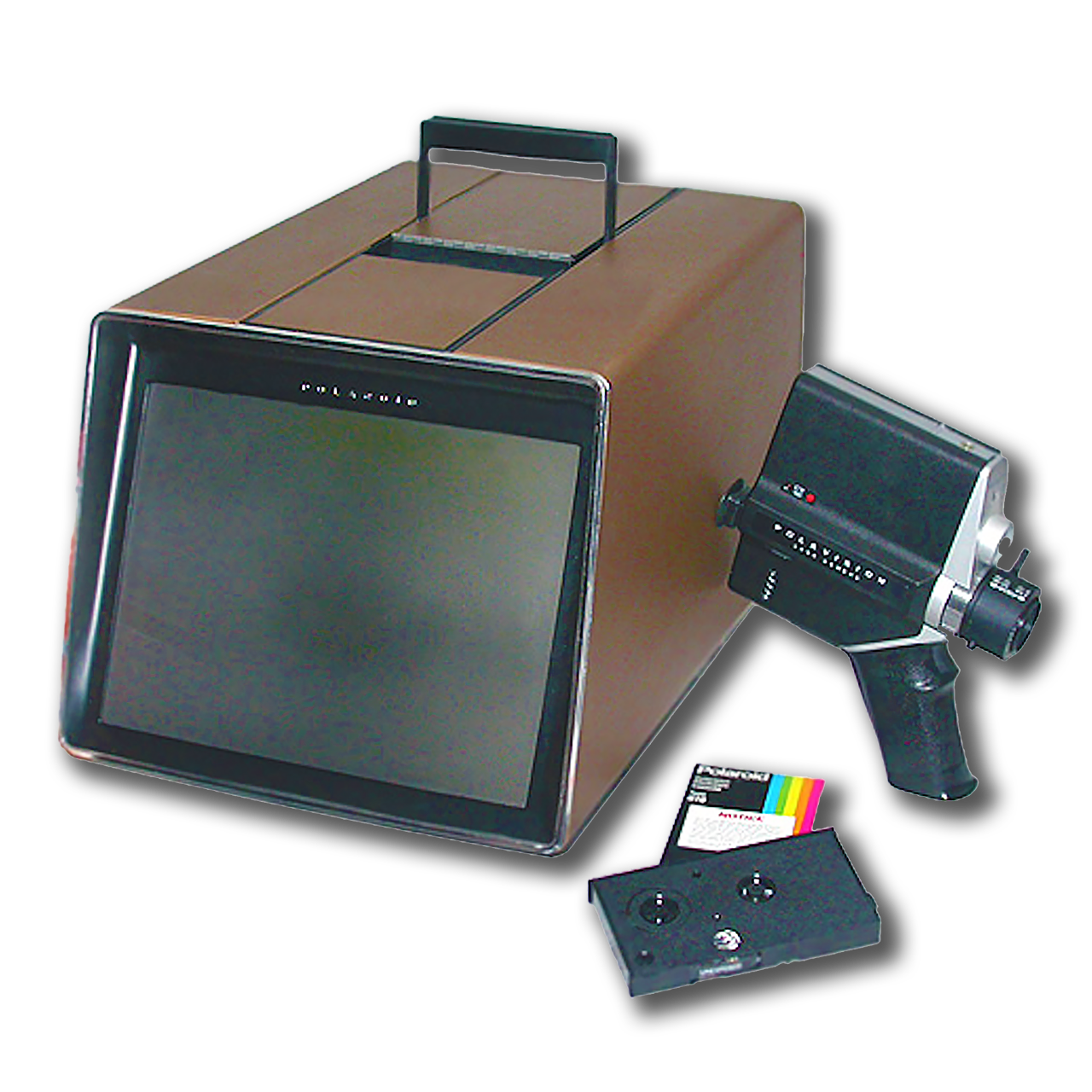
A Polavision set, consisting of a Polavision Land camera, a Polavision Player and casssettes a processing pack case and other accessories. The film format is similar to the super 8 mm format, but without the Polavision tabletop viewer the only way a Polavision film can be shown is by destroying the cartridge and projecting the removed film with an ordinary super 8 mm projector.
automatic 103
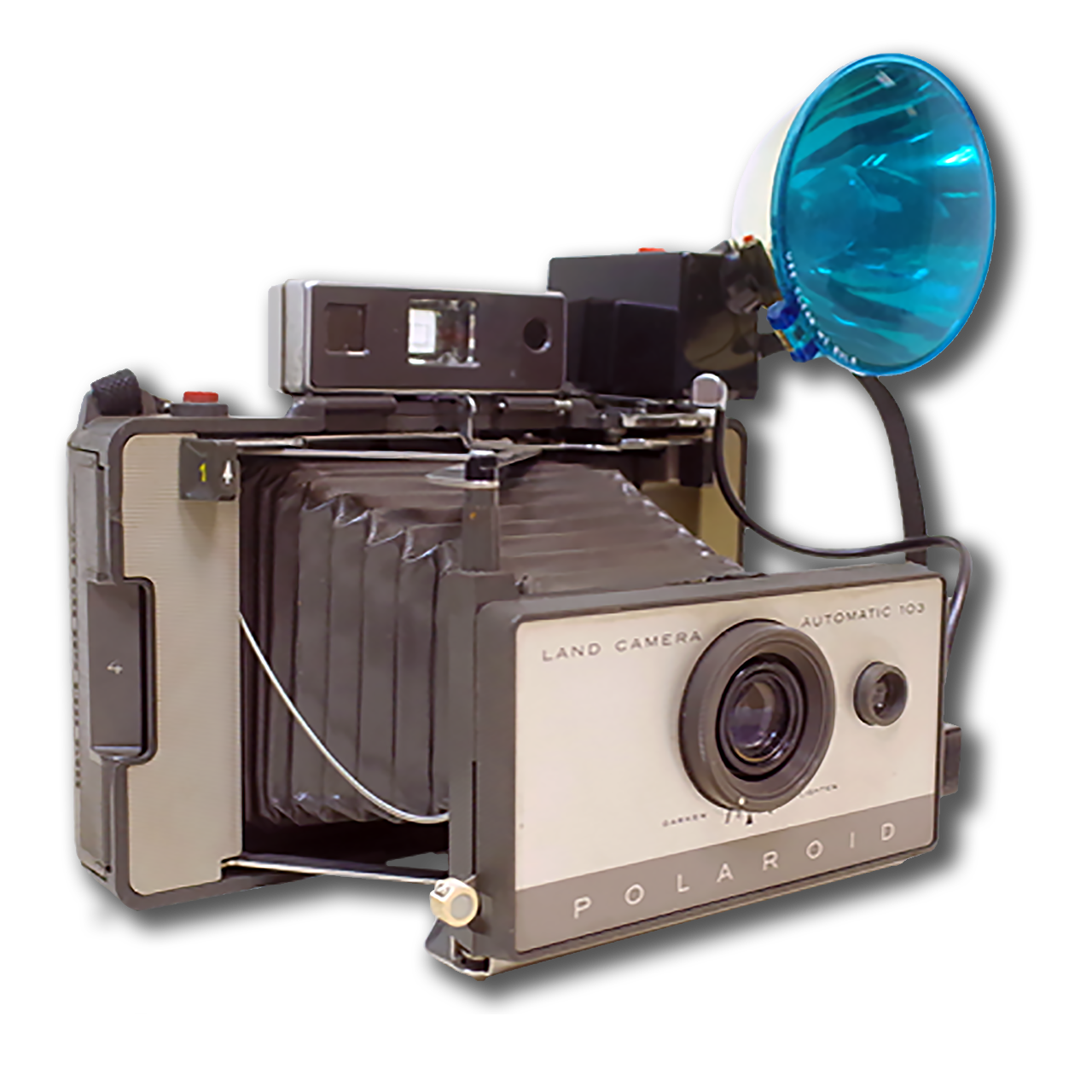
The Polaroid 103 Automatic is part of the series of Polaroid cameras that began with the Automatic Land Camera 100 and finishing at the Automatic Land Camera 450. The 103 is one of the earliest ‘consumer’ models of the 100-400 series line of folding Packfilm Land Cameras and shares a common set of features with all models in this line. The 103 was produced from 1965 until 1967, retailing on release for $90.
MiniPortrait 403
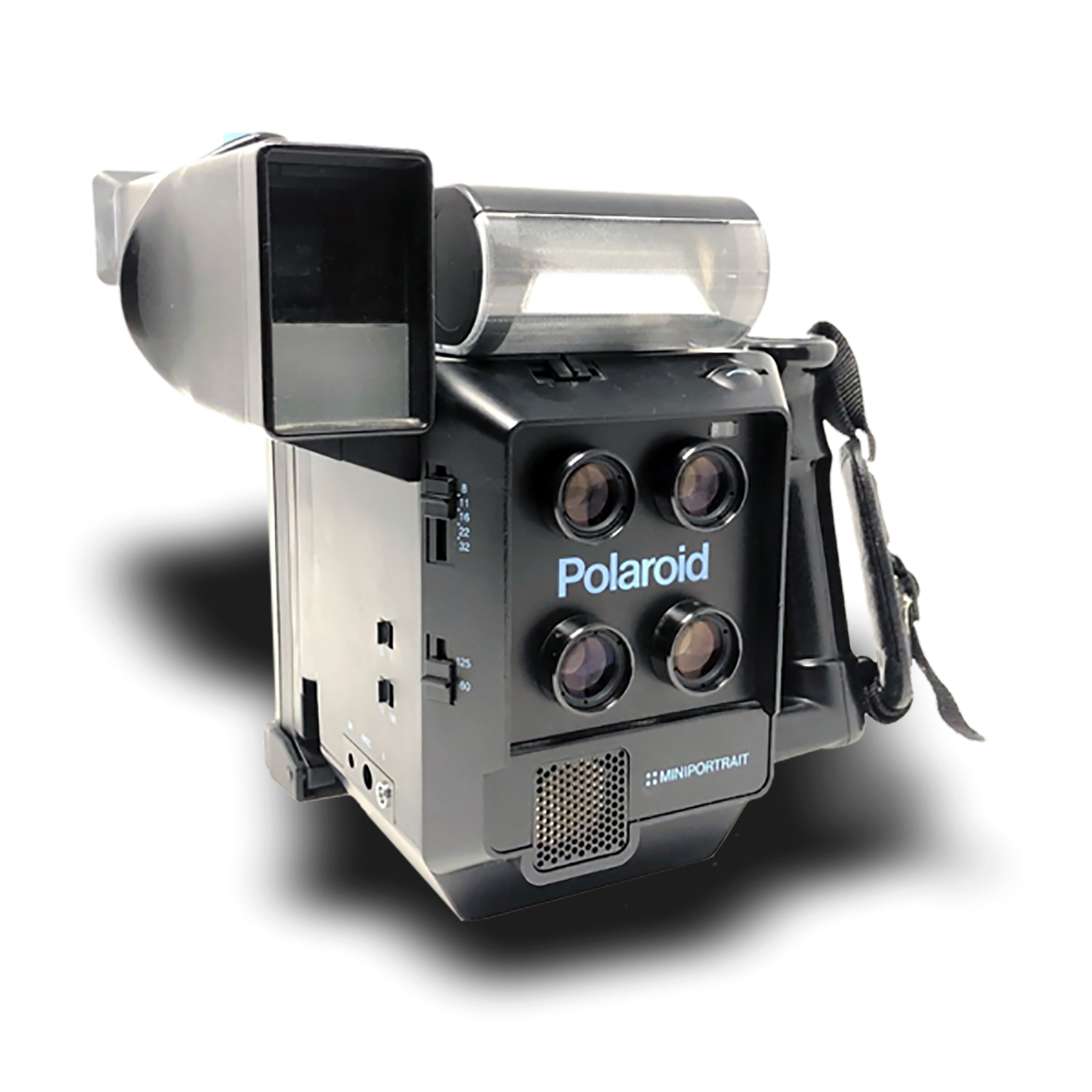
The Polaroid MiniPortrait 403 produces 4 identical portraits, 2 pairs of identical portraits or 4 different portraits. The MiniPortrait 403 features film processing timer on the back of the film holder; a built-in electronic flash unit; the camera also can be used with other types of lighting. The sonar rangefinder ensures that the camera is at the correct distance for sharp focus and correct image size.
Polaroid 600 Taz

Polaroid 600 Taz Tasmanian Devil Looney Tunes Camera. Designed in the image of that infamous Looney Tunes Tasmanian Devil, when you take photographs with this camera, the prints appear to come out of Taz’s mouth! Made around 1999, this ultra rare Tasmanian Devil Polaroid 600 camera is a real attention-grabber! The Taz Camera uses regular Polaroid 600 Film.
POLAROID SPLASH II
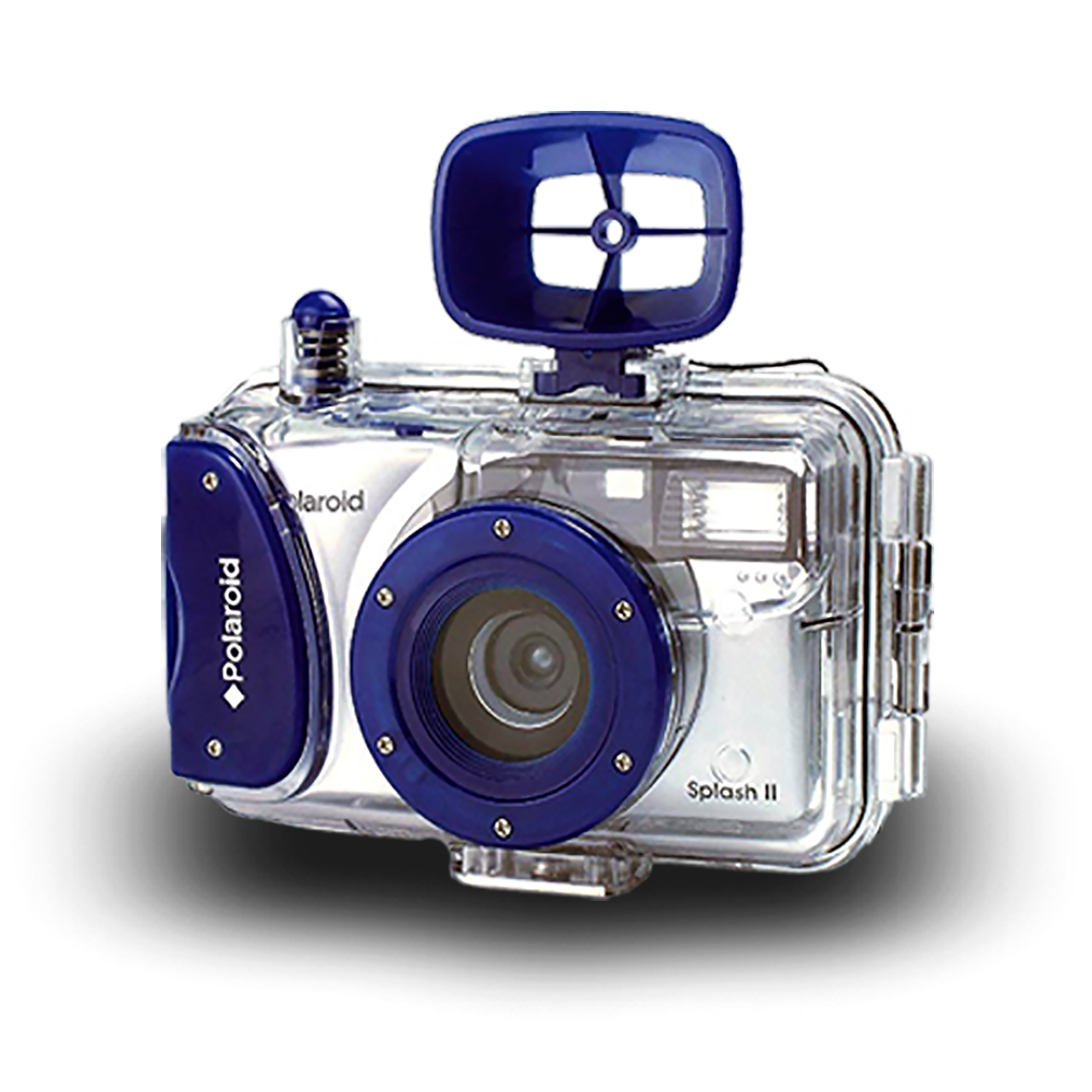
The Polaroid Splash II is the ultimate camera for sports, scuba, and beach vacations. It has a metallic silver body encased in a clear removable waterproof housing accented with a blue grip for a sporty look. The camera is suitable for underwater photography up to a depth of 65 feet (20 meters). The housing can easily be removed for land-use as a normal 35mm compact camera.
POLAROID P600
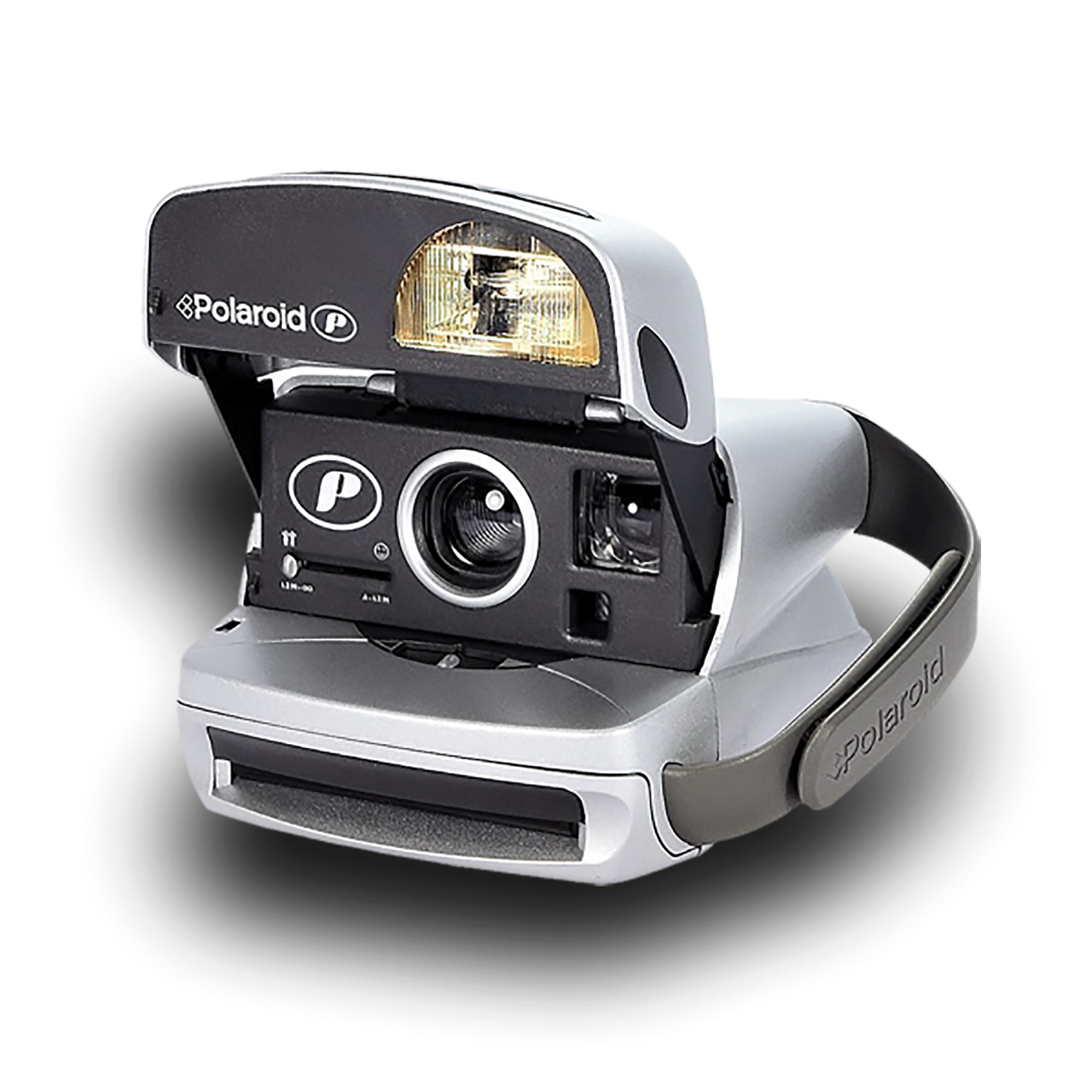
The Polaroid P 600 auto focus is an instant camera which folds open to reveal the fixed focus lens, a built in flash and the close up setting. This one uses classic Polaroid 600 film. The Polaroid P600 Instant Camera is a combination of features and simplicity. Once you’ve got your 600 film, you’ll just have to push the button and the print will pop out the front. The Polaroid P600 is the most basic of 600 models.
FOUNDER: Hanns Porst
COMPANY NAMES:
1919: das „Photo Haus Porst“;1986: Photo Porst AG.
COMPANY ADDRESSES:
1919: Laufer Platz, Nuremberg; 1923: second store, at 18, Hauptmarkt Strasse, Nuremberg; 1924, 1, Augustinerstraße, Nuremberg; 1924, Lorenzenplatz, Nuremberg; 1927, the building on Bergauerplatz, Nuremberg was rebuilt; 1937, acquisition of a 5000 m² office building located on Veilhofstraße, Nuremberg; 1946: Voigtländerstraße 3 & 4, Nuremberg; later Königsplatz 6, 91126 Schwabach.
Especially Photo Porst has shaped the German hobby photo market like no other company. With the introduction of the mail order business in the photography sector and the offering of favourable terms of payment for an appointment, Photo Porst in Germany created the prerequisites for making photography a hobby for millions, true to the motto of Hanns Porst: “Those who take photos enjoy life more”.
The story of Photo Porst is not just the fascinating story of a German company, from its beginnings and heyday between the First and Second World Wars. Then complete destruction in the Second World War, reconstruction and new prosperity at the time of the German economic miracle. Finally, to socialist experiments (the company was completely transferred to the employees), their failure and the final end in 2002.
The history of Photo Porst is also the history of the German photo industry from the beginning to the blossoming of the German photo industry. The first price wars – first with products from East Germany (in competition with the Russian products from the competition Photo Quelle). The struggle with the first cameras from Japanese production up to the last twitches of the German camera industry.
The Photo Porst catalogues are a complete documentation of this development. They are an industrial and economic history laid down on 200 pages.
 Hanns Porst came from a humble background. His father was a bristle dresser at the United Brush Factory, while his mother worked from home to earn some money to support the family, who always lived in Wöhrd, on Felseckerstrasse, in Rahm and on Fabrikstrasse. When little Hanns was allowed or had to go to the Realschule on Löbleinstrasse because of his good grades in elementary school, the only thing that bothered him was that he could no longer walk barefoot to school.
Hanns Porst came from a humble background. His father was a bristle dresser at the United Brush Factory, while his mother worked from home to earn some money to support the family, who always lived in Wöhrd, on Felseckerstrasse, in Rahm and on Fabrikstrasse. When little Hanns was allowed or had to go to the Realschule on Löbleinstrasse because of his good grades in elementary school, the only thing that bothered him was that he could no longer walk barefoot to school.
In 1913, the graduate entered the service of the magistrate as a town clerk, but his “lifelong” civil service career lasted just two years, when he was drafted into the military – incidentally on the same day as his father – and took part in world history, ultimately as a lieutenant. With a shot in the arm, he briefly returned to municipal service, and then the idea of his life came to him. She let herself be summed up in a sentence that would become the motto of a global company: “Those who take photographs get more out of life!”
On July 1, 1919, the 23-year-old city clerk Hanns Porst in Nuremberg, opened a small photo shop in his home town of Nuremberg. He discovered his love for photography as a boy: his parents’ subtenant introduced Hanns Porst to the secrets of photography and the darkroom. Money earned as a newspaper boy was invested in his first own camera, a box camera at five Reichsmarks, and from then on Hanns Porst, 15 years old, was a photographer at all sorts of events to earn his pocket money – and an ever better camera equipment.
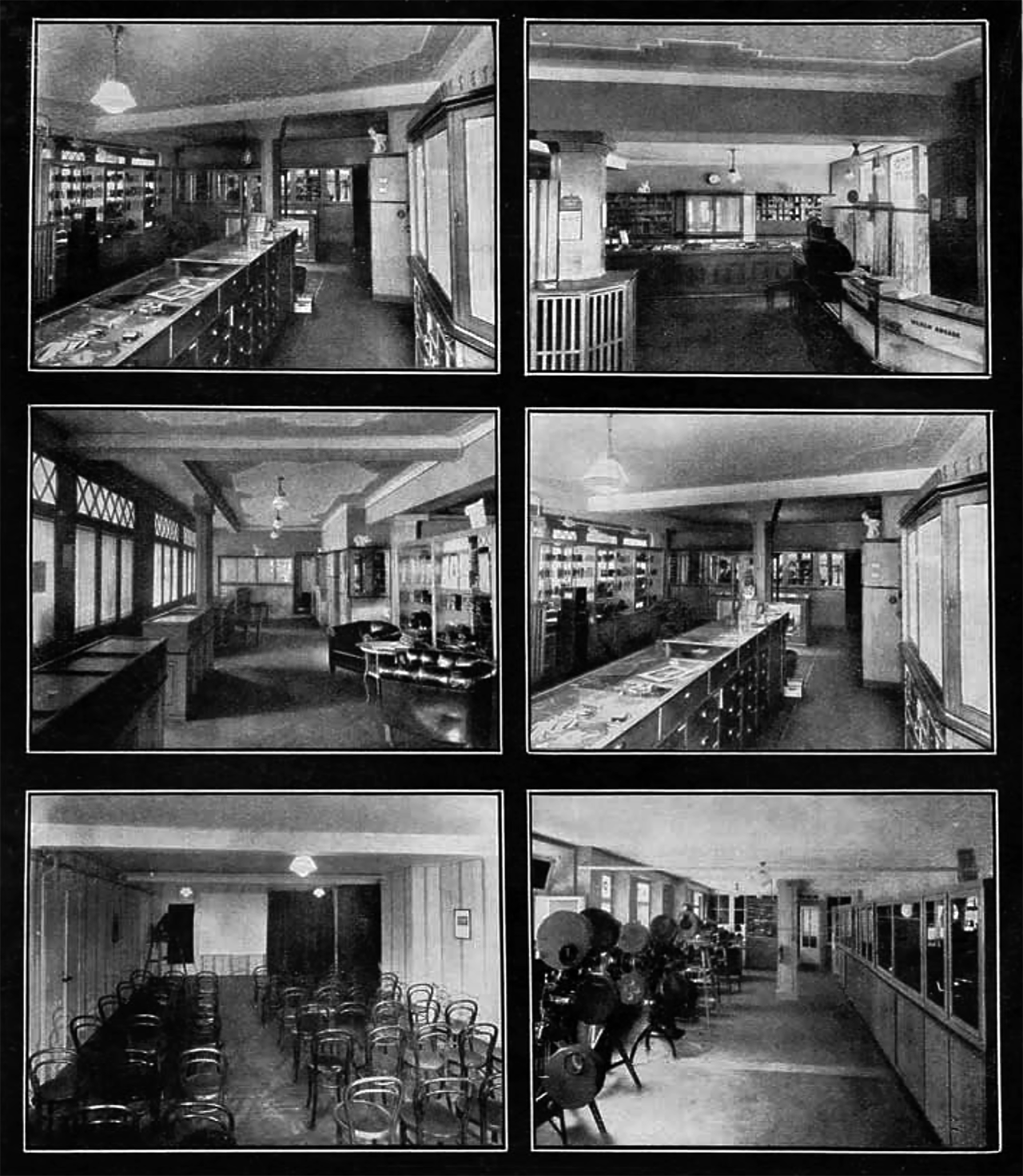
Photo-Porst Nuremberg, Lorenzer Platz 15; Shop and sales rooms, lecture room, cinema and projection sales room.
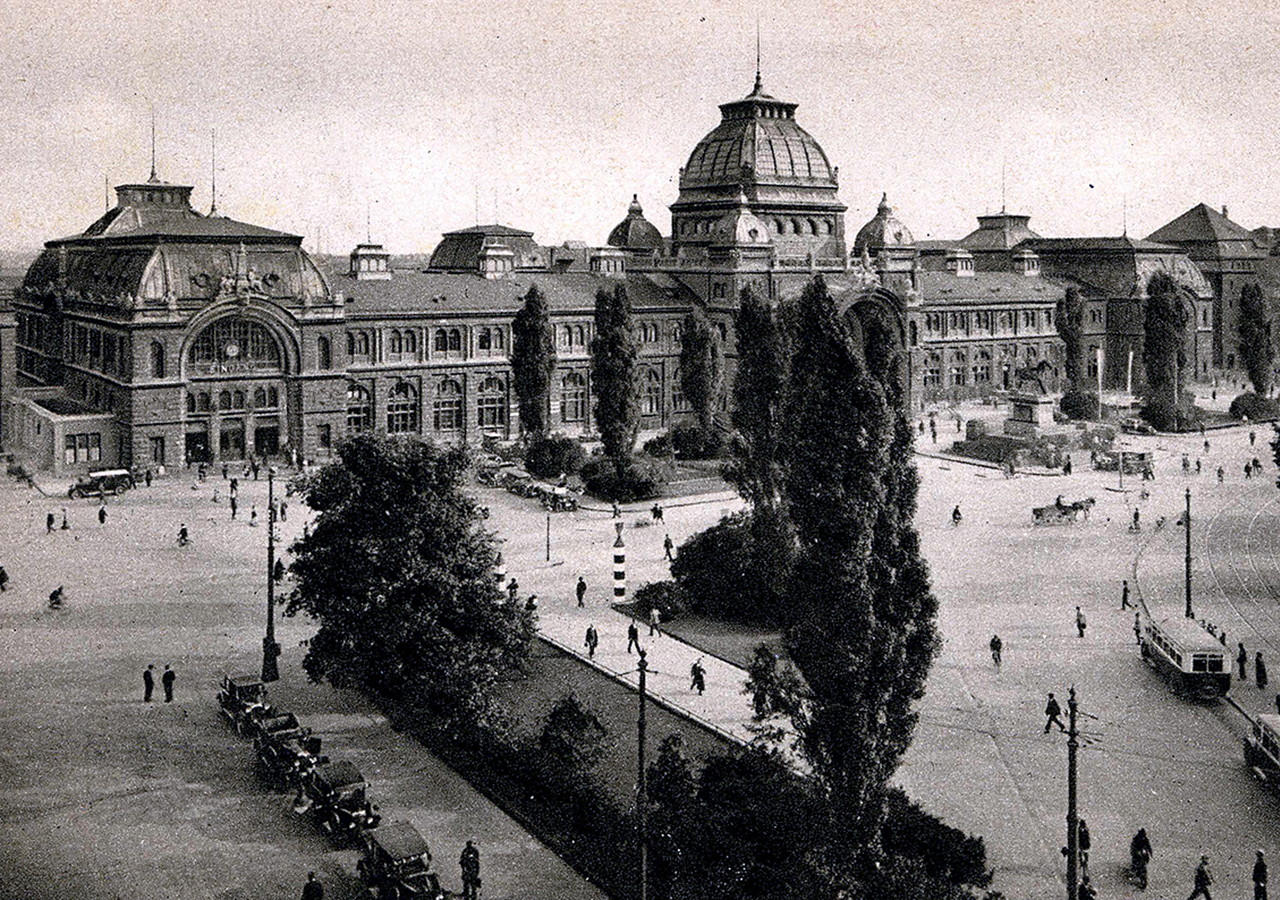
Railway station of Nuremberg. Postcard used in 1920s without any author information.
 Soon after the opening of his first small shop, Hanns Porst demonstrated his brilliant marketing skills. He had no money for large advertising campaigns – so one night he had the sidewalk in front of his shop converted into an unconventional advertising space.
Soon after the opening of his first small shop, Hanns Porst demonstrated his brilliant marketing skills. He had no money for large advertising campaigns – so one night he had the sidewalk in front of his shop converted into an unconventional advertising space.
His friends embellished the sidewalk in large letters with the Photo Porst logo. The law enforcement officers quickly ensured that this unauthorized advertising disappeared again, but everyone was talking about Photo Porst.
A similar move was made by Hanns Porst in 1925 when he opened his third “big” shop at Lorenzerplatz behind the Lorenzkirche with no fewer than eleven shop windows. (Three of them had to be painted white at first because no one really knew what else to put in them).
 Unfortunately, this new business location was a little further away and therefore didn’t attract too many shop window viewers. This changed quickly when Porst started to light up the building at night. In an otherwise fairly dark city, many revellers flocked to the glow of this lighting, saw the exhibits in the shop windows, and many became loyal customers.
Unfortunately, this new business location was a little further away and therefore didn’t attract too many shop window viewers. This changed quickly when Porst started to light up the building at night. In an otherwise fairly dark city, many revellers flocked to the glow of this lighting, saw the exhibits in the shop windows, and many became loyal customers.
On a wave of cameras and roll film, he and his company were carried up into the air. The secret of this rise: Hanns Porst knew how to win his customers as friends. He organized photo courses after work, went on photo excursions and did not shy away from photo beer evenings. Now everything had to serve him well.
Excellent customer orientation – as the main principle of the company – was the key to the success of Photo Porst. Hanns Porst had recognized very early that satisfied customers return again and again and bring through word of mouth more customers into the house. And Hanns Porst made another experience: “Anyone who takes photographs is a decent person.” The customers all paid their instalments on time, there was no need for reminders, there were no losses. Above all, the entry into the mail order business created the conditions for the further growth of Photo Porst.
 It came like this: every year, Nuremberg, the jewel of the German Empire, attracted thousands of visitors. One or the other came – at the beginning absolutely by chance – in the small shop of Hanns Porst. When days or weeks later they found themselves at home, they remembered the kind man who was in Nuremberg and whom they had trusted. Thus, it happened that more and more external customers wrote to Hanns Porst to entrust him with their photo needs. So Hanns Porst advised his external clients as well as his clients in the city. In his letters, he discussed with customers. No wonder the customers of the couriers in Porst, whom the photo brought closer, were enthusiastic. We see that mail-order sales were developing as a result of the quality of reception in stores.
It came like this: every year, Nuremberg, the jewel of the German Empire, attracted thousands of visitors. One or the other came – at the beginning absolutely by chance – in the small shop of Hanns Porst. When days or weeks later they found themselves at home, they remembered the kind man who was in Nuremberg and whom they had trusted. Thus, it happened that more and more external customers wrote to Hanns Porst to entrust him with their photo needs. So Hanns Porst advised his external clients as well as his clients in the city. In his letters, he discussed with customers. No wonder the customers of the couriers in Porst, whom the photo brought closer, were enthusiastic. We see that mail-order sales were developing as a result of the quality of reception in stores.
Then a mishap occurred! Around 1925, he had made a mistake by buying a large amount of high-quality plate cameras: the cameras were not selling quickly enough and there was a risk of remaining with a remaining amount. He also offered these cameras outside of Nuremberg – with a generous instalment (1/10 down payment, rest in convenient monthly parts) – and received a very large response. From there, the mail order business was systematized and enabled the rapid growth of the company.
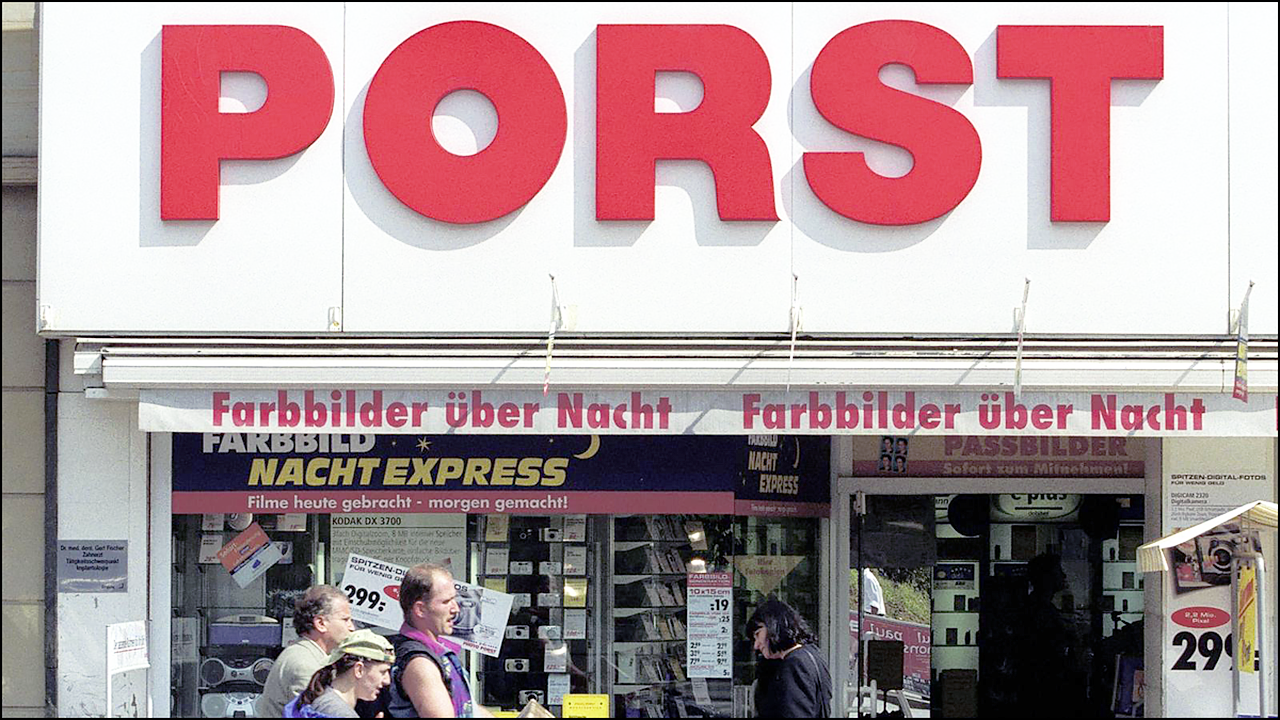
A normal sight in the shopping streets of post-war Germany.
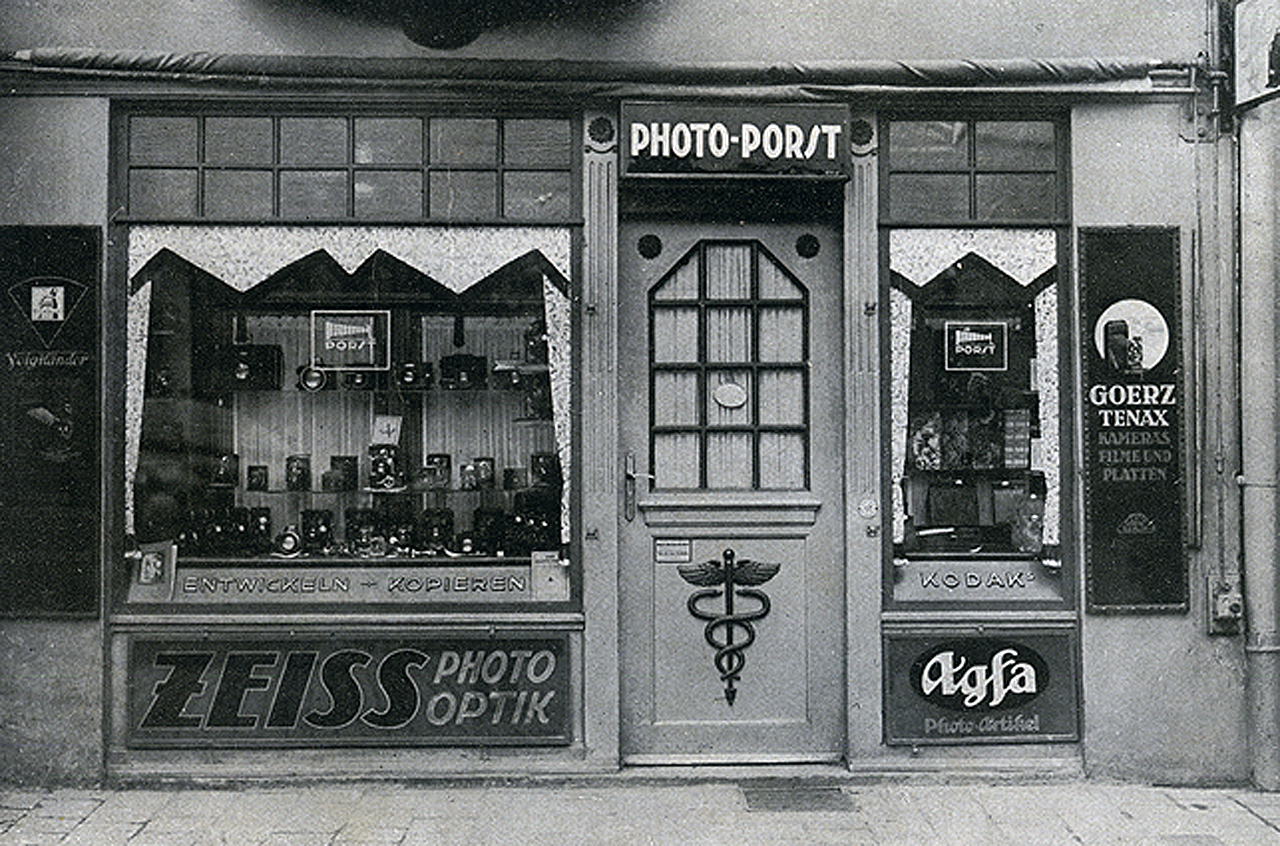
The second Porst store, at 18, Hauptmarkt Strasse, Nuremberg. The presence of the caduceus on the door suggests that it was previously a pharmacy.
The large assortment, cameras of all price ranges, a complete range of accessories, and low prices (made possible by the large quantities) were the basis for the success of the Porst company. Just think of the time – photography shops were small and certainly only present in larger cities. The assortment offered in the stores was very limited, and cameras and accessories had to be selected and ordered from the manufacturer’s brochures. The huge offer of the Porst catalogue with its many illustrations, which could be studied in the comfort of your own living room, was the much better alternative.
The generous partial payment from Photo Porst – without a credit check and without asking a bank or employer – was very good for the Porst audience. Photo Porst’s heyday was the time of the German economic miracle after the Second World War.
People wanted to buy “luxury goods” but could not afford to pay cash for their new camera. But of course neighbours, friends and colleagues shouldn’t know that. And of course Photo Porst’s anonymous and “generous” credit terms were very welcome. But the conditions weren’t quite as generous: at least 1% interest per month was calculated – but that was not exactly the case at the time! – And according to Hannsheinz Porst, almost 100% of all buyers accepted the financing offer and bought in instalments.
Porst’s communication concept, consisting of the famous Porst photo helper (catalogue), books, occasional lists, a customer magazine and much more, led to an unprecedented customer loyalty, much closer and better than in many conventional shops. We find many quotations from letters from satisfied customers in the catalogues.
Each client must be advised with the utmost courtesy and be served with the greatest reliability. This personalized advice, the tireless follow-up requires space. More space than the company had then. Therefore, Hanns Porst bought a very large commercial building on Bergauerplatz, with a frontage of 35 meters. He had it completely rebuilt, and in 1927, when its turnover exceeded the mythical limit of several million, one of the most beautiful office buildings in Nuremberg was completed with this reconstruction.
The growing clientele, vast extensions were necessary. A new office building was built at Bergauerplatz, and two floors raised the old building. It was a year of serious economic crisis, and yet the success proved the optimistic Hanns Porst right: In the crisis year 1931, sales increased by 43 percent compared to the previous year, from 2.4 at 3,500,000.
Hanns Porst’s publicity had more and more impact because people noticed that behind it was a hitherto unknown power, and that Hanns Porst, having called for truth in the publicity, acted in this direction.
Later, the area increased. In 1929 Hanns Porst built another office building on Oberen Bergauerplatz with 7 floors, 25 meters long and 15 meters deep. For a long time, Photo-Porst has already been by far the largest photo house in the world.
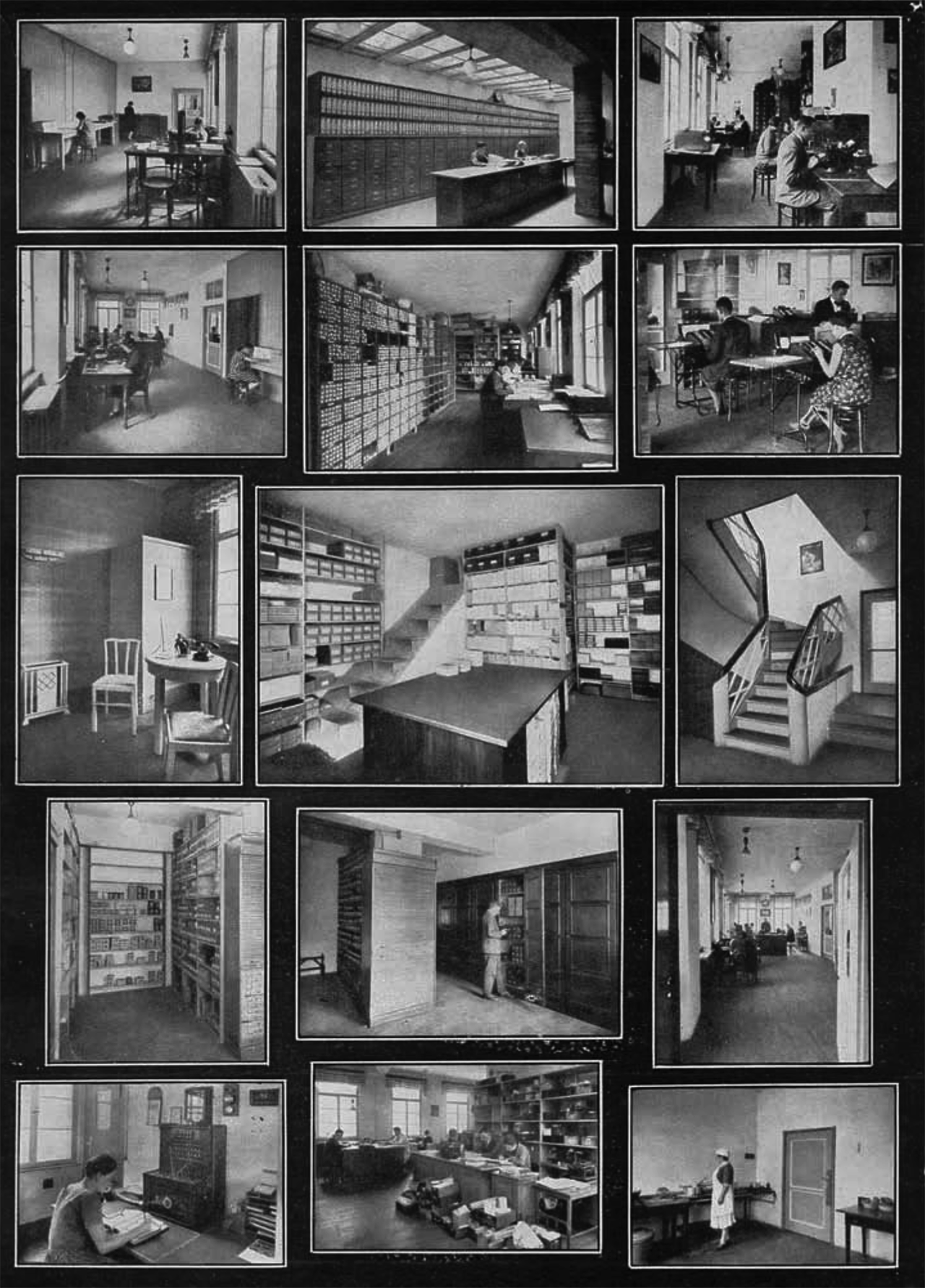
Departments in the Kontorhaus at Bersauerplatz were (from left to right and then from top to bottom):
In-house print shop – registry – billing office – address department – supplies warehouse – machine accounting – meeting room – printed matter warehouse – staircase – supplies warehouse – camera warehouse – advertising printed matter – telephone exchange – expedition – kitchen.
In addition, there were underground spaces that were created by creating a basement in the entire courtyard with space for 4 garages. There is a roof garden on the roof of the building as a lounge for the staff.
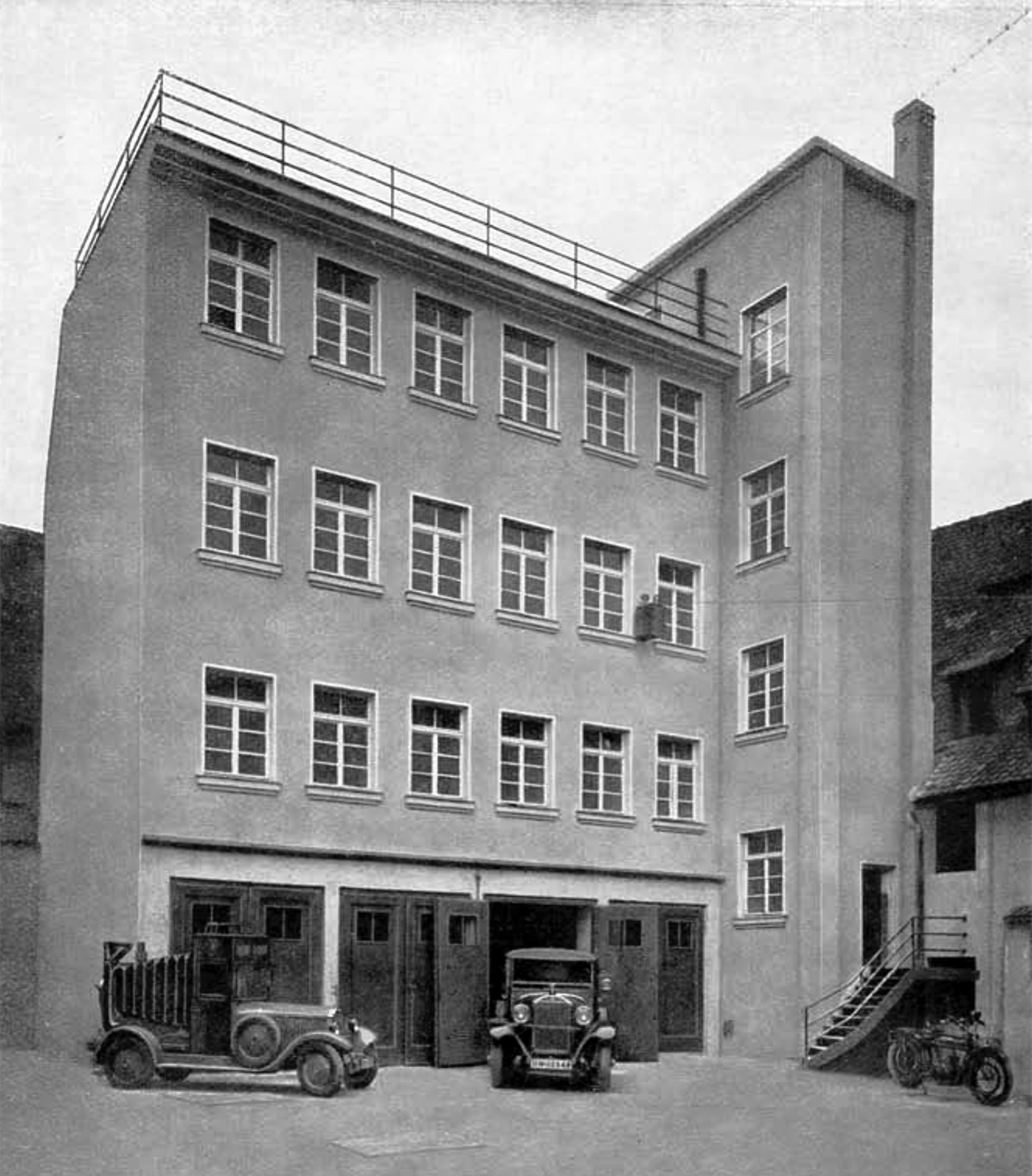
The large, 35 m long, 3-story new office building on Bersauerplatz is only used for our special mail order department for photography. From here, tens of thousands of photo devices and photo supplies go to all areas of Germany and neighboring countries every year. Our principle of having every order mailed on the same day has created good organization for us.
The era of the small format arrived. To the hundreds of thousands of amateur photographers acquired by Porst’s generous publicity, there are now also those who had never experienced photography with large, unwieldy cameras.
Long-time Photo-Porst enthusiasts show them the path they too had followed to become the lucky owner of a camera! The path to instalment assistance as simple as it is accessible.
1937, Hanns Porst acquired a 5000 m2 office building on Veilhofstraße with buildings on the side streets named after the pioneers of photography: Zeiss- and Voigtländerstraße. In the year of the war, 1939, the turnover reached 8 million and the number of employees increased to 450.
 The war destroyed everything that Hanns Porst had built. At the same time, he learned that his only son had been wounded during the Battle of Berlin.
The war destroyed everything that Hanns Porst had built. At the same time, he learned that his only son had been wounded during the Battle of Berlin.
His life’s work seemed destroyed, but Hanns Porst was not ready to give up. “Help yourself and heaven will help you!” he said, spitting in his hands. He grabbed the shovel and the pickaxe, and rebuilt, literally, with the help of drivers, typists, packers, and accountants.
Thus, with an inflexible will, Hanns Porst started again almost at the same point as in 1919. It was thus confirmed that in the long run fortune only smiles on the daring.
No sooner had he begun the fight against post-war injustice than he could hug his son HannsHeinz, returning unexpectedly. In addition to his own energy and incomparable experience, Hanns Porst could now also benefit from the titanic ardour of his son, whom he made his (only) partner.
While digging to rebuild the premises of Photo-Porst, they discovered boxes with the addresses of 130,000 former customers. In the hell of the bombardments, the masonry, by falling, had protected these addresses from the flames. “Take them all” said Hanns Porst at the time, “I still have the friendship and loyalty of hundreds of thousands whom I have served well. This is my capital”.
With this capital, Hanns Porst and Hannsheinz Porst went towards the monetary reform of 1948. The industry delivered the first cameras. Business was picking up again and in 1948 more than 300 employee apartments were built.
 The sales reach 14 million marks in 1952. This is partly due to Porst’s rolling exhibitions. With two buses with a trailer he travels through Germany to give demonstrations and information in the field of photography everywhere.
The sales reach 14 million marks in 1952. This is partly due to Porst’s rolling exhibitions. With two buses with a trailer he travels through Germany to give demonstrations and information in the field of photography everywhere.
Another milestone is reached in 1954, when the 1,000th Porst employee, who has just been hired, is given the 1,000th private label camera, a HAPO 36.
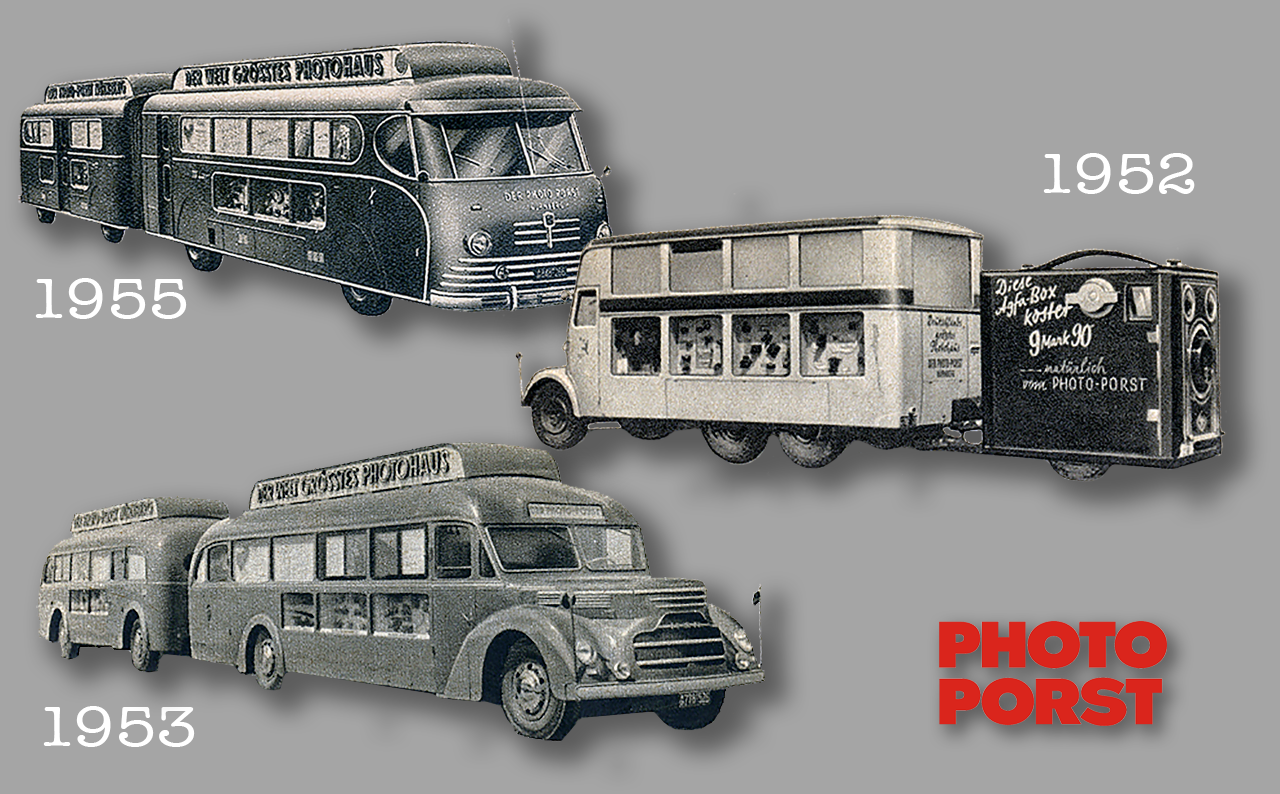
In addition to the catalogues, Porst also came to exhibitions and to customers with his rolling demonstration vans
Three Photo Porst teaching and exhibition trucks, viz. the 1952 bus truck and its Agfa Box-shaped trailer; 1953 Truck, based on a Man MKN bus, from 1951. 8 liter engine, for 120 horsepower. “Alligator” nose. It has a luggage compartment on the roof and finally the truck from 1955, based on a Büssing bus, accompanied by its extension, connected by a bellows. Everything in these Photo-Porst buses can be viewed in detail and is readily explained by the friendly gentlemen, who provide so courteous information on all questions relating to photography. Always non-binding for the visitor. You can’t buy anything on the bus. Not even a roll film. (Photo-Porst friends buy comfortably at home “through the post at Porst”). But if you have any wishes, they will be passed on to Nuremberg by the first mobile private telex systems that the world has ever seen. And you can watch it.
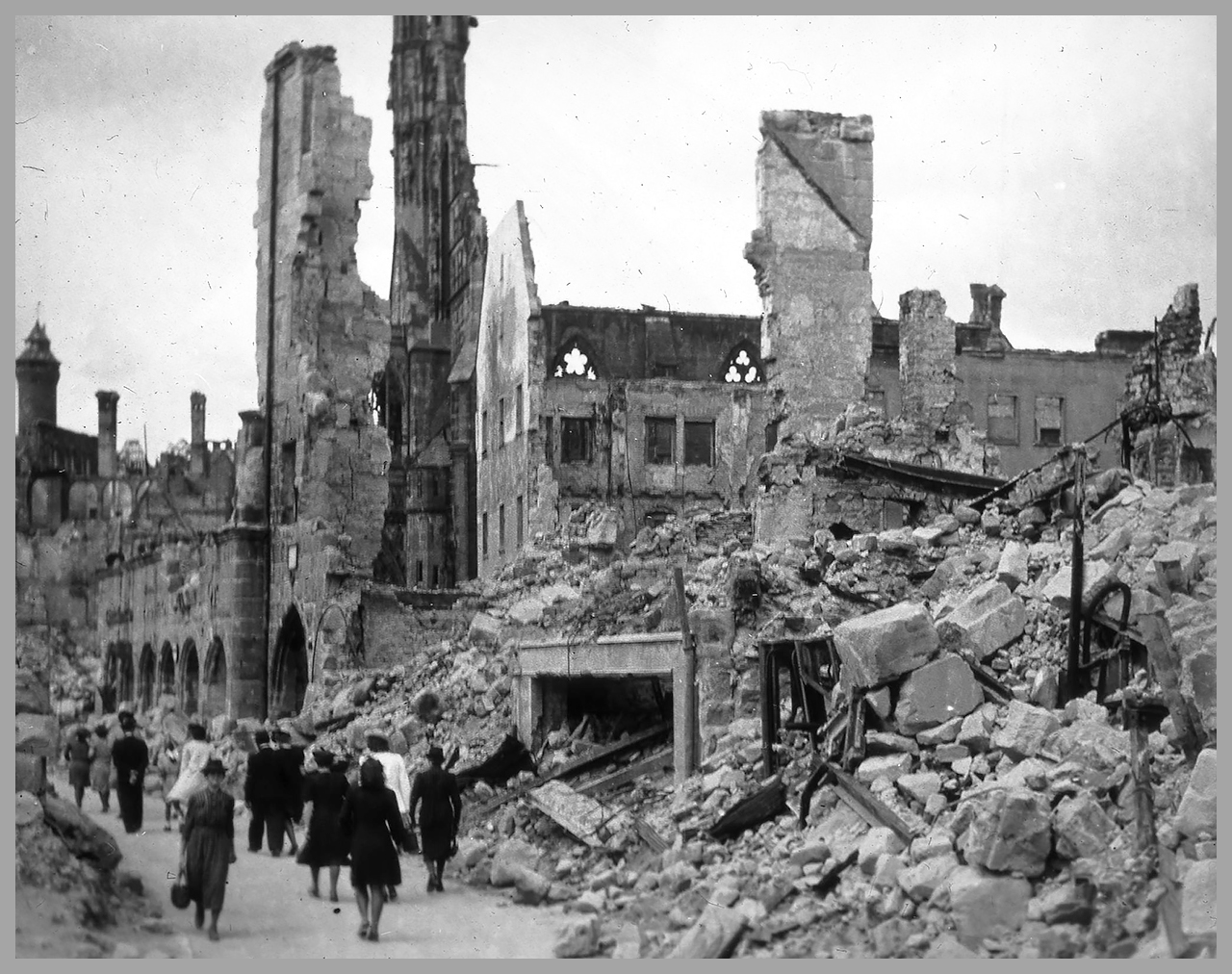
Somewhere, deep under the rubble, protected from the fire, is Photo Porst’s entire address book. The starting capital for the reconstruction.
 In 1960 Hannsheinz Porst, son of Hanns Porst, takes over the management of the company, and Porst goes into the competition fight with Neckermann and Photo Quelle. Also in 1960, the Liechtenstein office and calculating machine factory Carena in Mauren, produces the film camera Carena exclusively for Photo Porst.
In 1960 Hannsheinz Porst, son of Hanns Porst, takes over the management of the company, and Porst goes into the competition fight with Neckermann and Photo Quelle. Also in 1960, the Liechtenstein office and calculating machine factory Carena in Mauren, produces the film camera Carena exclusively for Photo Porst.
Around 1964, sales collapsed: shops now offered an adequate assortment, and anonymous instalment offers were also (and significantly cheaper) available from other providers.The new competitor Foto Quelle had become a powerful competitor. The German camera industry lost massive importance. Cheap offers from the GDR and the USSR (especially through Foto Quelle) could not stop the triumphant advance of Japanese imports and also required a reorientation at Photo Porst.
During this time, Porst made the right decision that ensured the company’s success for almost 20 years afterwards. A chain of shops – supplemented by franchise partners in later years – was built at high pressure in good city locations. And again the old recipe “excellent service and customer friendliness” led to success.
From the beginning, his employees (along with his customers, of course) played the most important role for Hanns Porst. With exemplary social benefits such as generous vacation regulations, company-owned vacation homes, the construction of modern employee apartments, training facilities, etc., Hanns Porst was ahead of his time as in so many things.
With his son Hansheinz, who took over the management of the company in 1960, these thoughts obviously went even further.
He was torn between the opposite poles of capitalism and the socialism of the GDR (which he knew well from shopping trips).
Hannsheinz Porst tried to mediate between the FRG and the GDR in his own way – he was not only politically active in the West, but also secretly a member of the SED and spied for the STASI.
In July 1969 Hannsheinz Porst was sentenced to two years and nine months in prison and a fine of DM 10,000 for treacherous relationships.
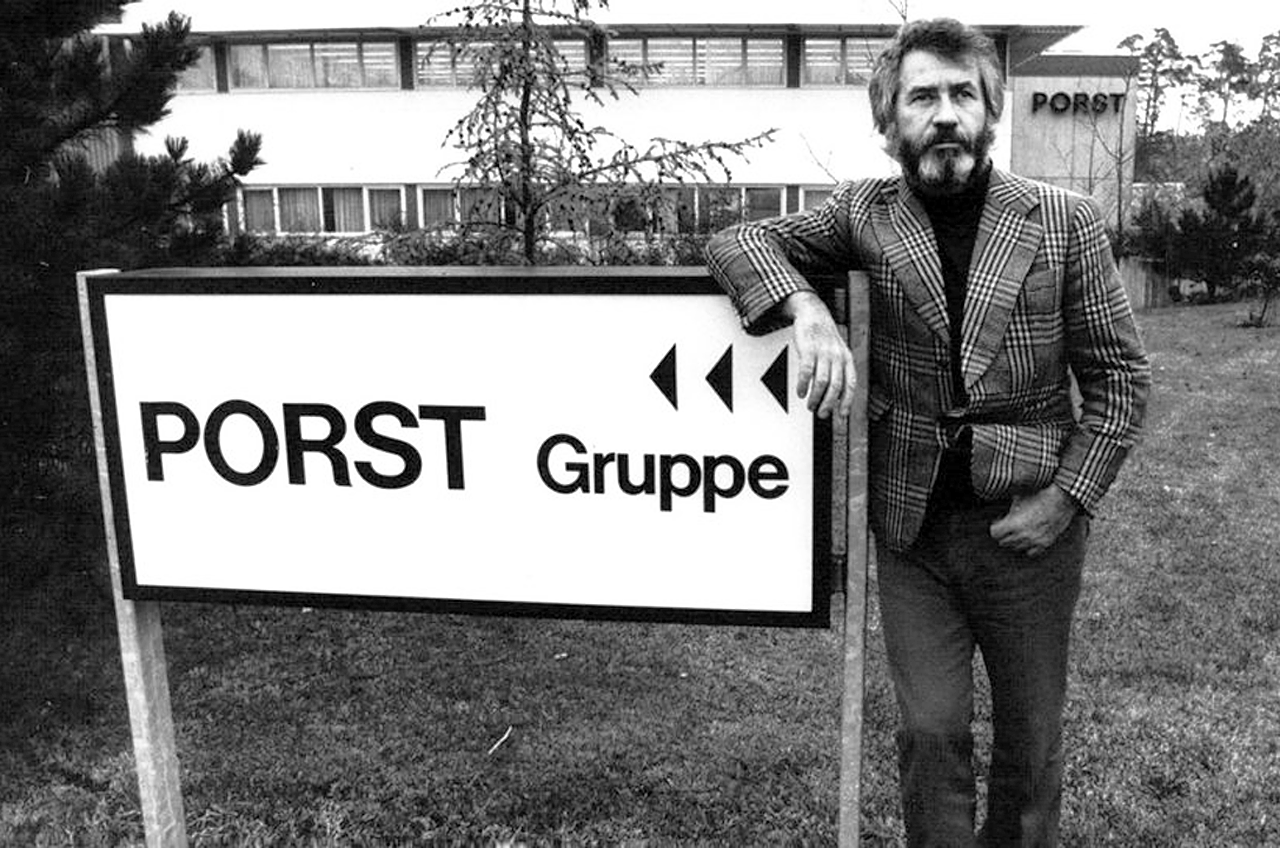
Hannsheinz Porst in front of his company Photo Porst before handing it over to his employees.
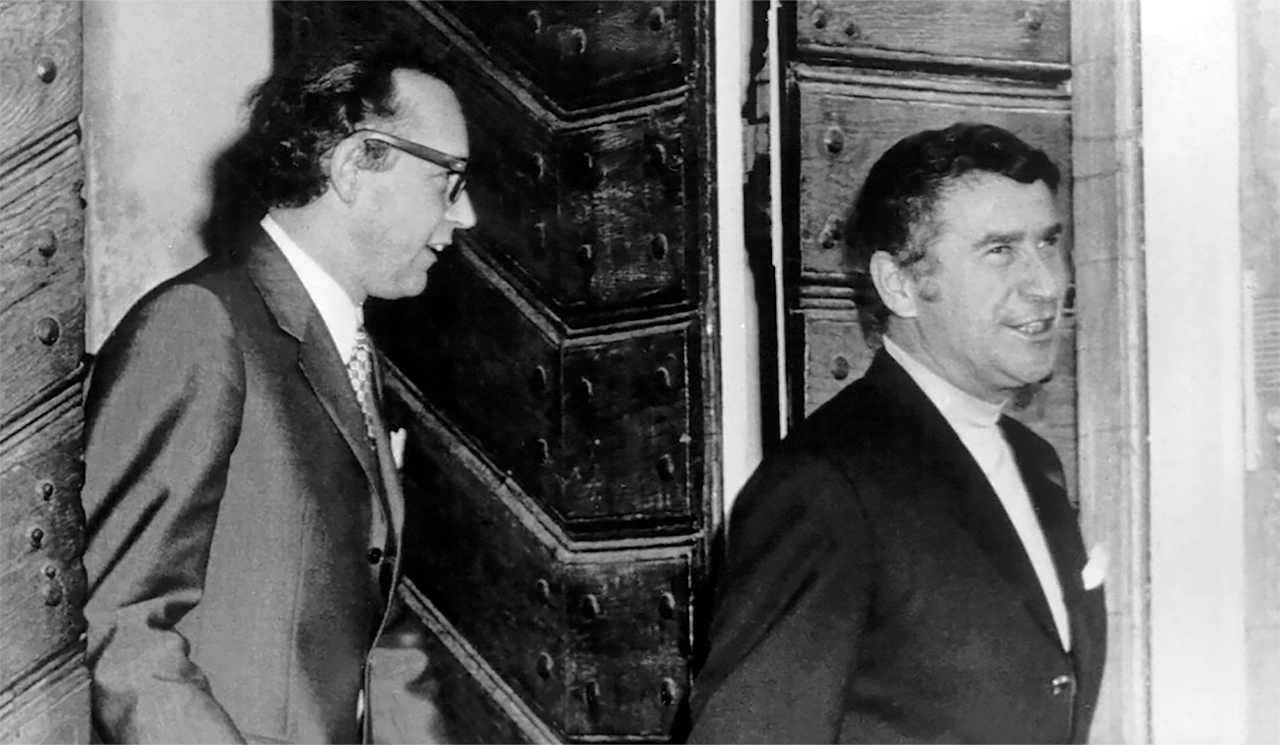
Hannsheinz Porst(r) with his lawyer Ekkehard Schumann is released early from prison in Landsberg am Lech on October 31, 1970. He had previously been suspected of being a spy because of his contacts with the GDR secret service.
Hannsheinz Porst also tried to implement these ideas in his own company. In 1972 Photo Porst introduced “total participation”. An employee association is founded, the company and its management are handed over to the employees, and Hannsheinz Porst completely withdraws from management in 1978/79.
From now on, the managers of the company are determined by the employees and also voted out again, a thought that seems absurd to at least many of us today.
The experiment didn’t go well for long. In 1982 the employee society failed, Hannsheinz Porst re-joined the company, the Swiss company Interdiscount took over the majority of the company shares, but the company never recovered from these socialist experiments.
Interdiscount/Switzerland takes over the capital majority Founding of Porst AG in 1986 with 2137 sales outlets. Hannsheinz Porst is only on the supervisory board, later resigns entirely.
1994 was the year of the big anniversary: 75 years of Photo Porst – 2500 employees, 200 own branches, 2620 sales offices and almost 1 billion DM turnover! Moreover, Carena (the house brand of Interdiscount, the owner of PORST AG) is Germany’s best-selling camera brand.
But tough times are coming, because in 1996, Photo Porst was in huge economic problems, sales fell rapidly and were DM 745 million below the previous year’s figure. Loss for the year DM 28 million and Coop Switzerland acquires the entire domestic business of the Interdiscount Group. The Belgian Spector Group takes over Porst AG for DM 100 million. Spector NV, which had just bought the Hungarian Föfoto and the French photo mail order company Maxicolor, is now the world’s largest photo company.
But restructuring and reorganization efforts are necessary. The result: in February 2001 PixelNet AG, listed on the new market in Frankfurt, takes over Photo Porst AG for the symbolic price of 1 DM from Spector Photo Group NV. It was the last resort: Spector no longer wanted to invest in the loss-making Photo Porst in order not to endanger its other activities. With more than 2000 stores – own and franchise stores – the Porst Group was one of the best-known photo providers in Germany and held a 9% share of the German photo market.
Although the development of the chain of stores and franchise partners continues to advance rapidly, the company never recovers. The upheaval in the photo market is too great, and the damage done at the time of the employee company was too serious.
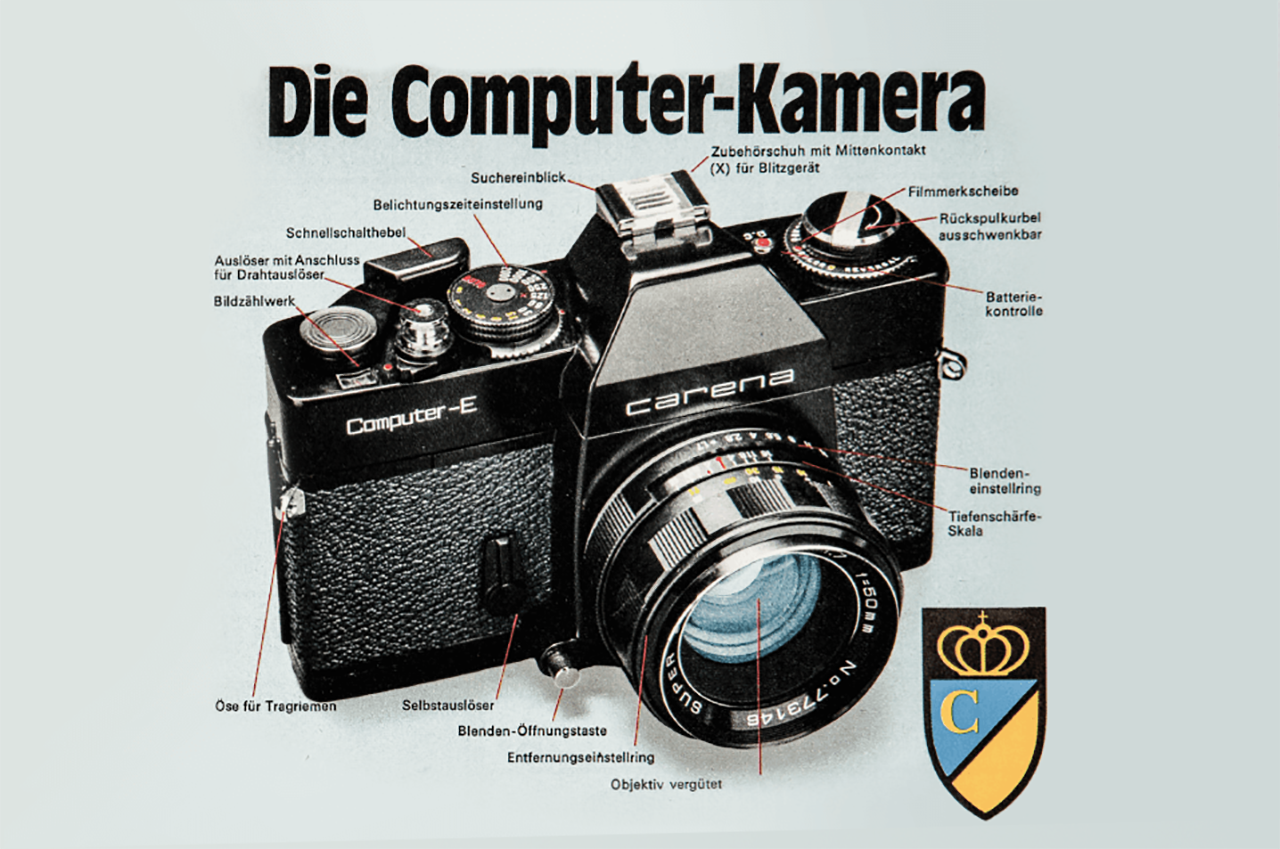
Portrait of the most sold camera in Germany in the 90s: the Carena!
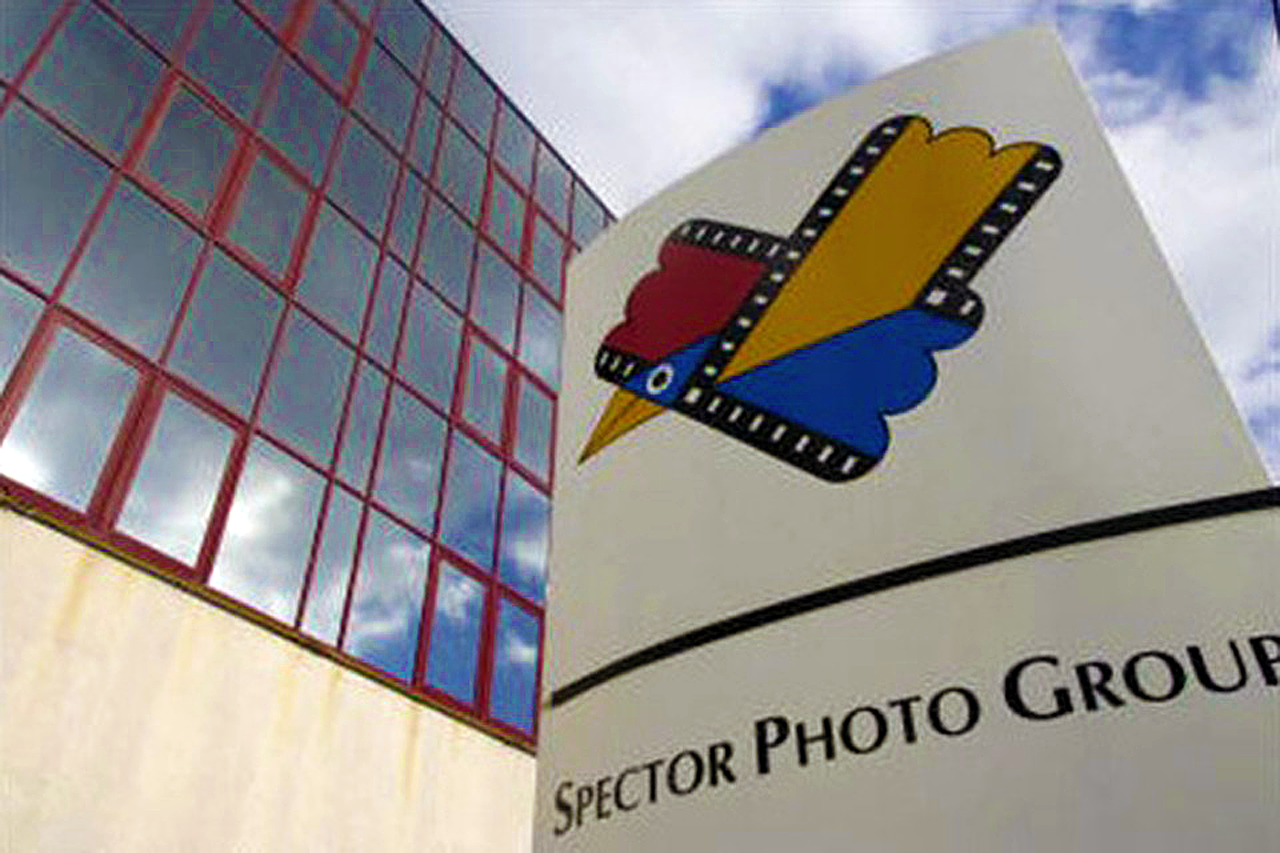
In 1996, Spector agreed to acquire much of Interdiscount’s international holdings, including Belgian consumer electronics retailer Photo Hall, and its counterparts in Hungary (Föfoto) and Germany and the Czech Republic (Photo Porst).
The special economic situation of German reunification and the additional markets in former East Germany can only postpone the end, but not stop it. After several changes in the corporate form and change of ownership, Photo Porst AG filed for bankruptcy in 2002. The naming rights go to the Ringfoto Group, Kodak takes over the rights for the picture business and the large laboratory (the PORST picture factory) in Schwabach. Kodak later sells the large laboratory to the company KFS and V-Dia. As a result of the insolvency of Photo Porst AG, PixelNet also went bankrupt a short time later. Porst was unable to repay loans to the parent company on time. The management of the 100% PixelNet subsidiary ORWO then also filed for insolvency.
In April 2004, KFS and V-Dia (which took over Kodak’s large laboratory) also went bankrupt. The former large Porst laboratory in Schwabach near Nuremberg with 236 employees was closed. Unfortunately, Hannsheinz Porst had to experience all of this. He died of a heart condition on April 29 at the age of 87 at his home in Vorra in the district of Nuremberg.
The largest photo house in the world ended 83 years after its foundation. The time of photo mail order companies was finally over. But Photo Porst still managed to survive the once glorious German photo industry for decades.
Overview of the cameras that have appeared at Photo Porst
under their own name and as private label

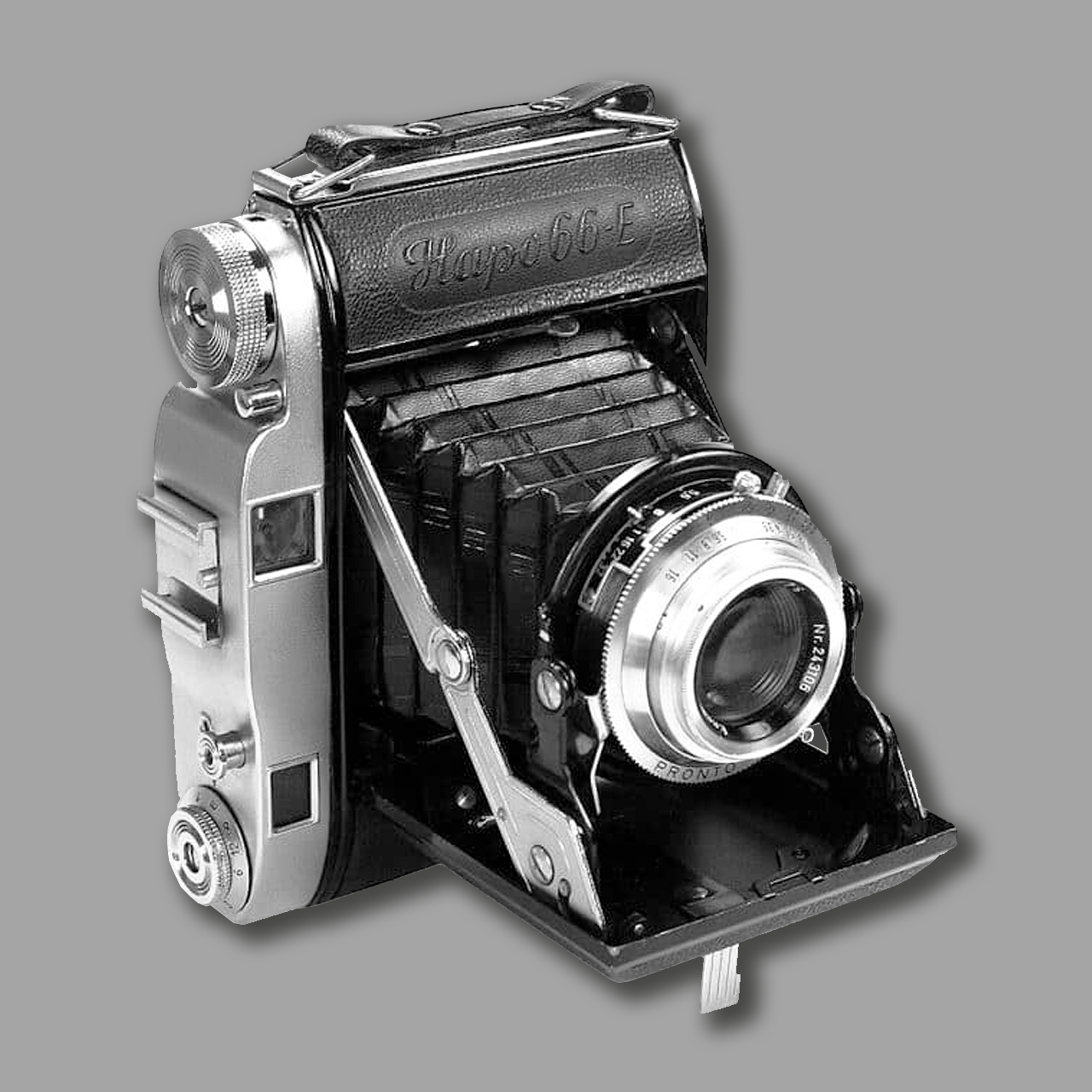
The Hapo-66 is a 6x6cm viewfinder folding camera, introduced in 1952 and made by Dacora for Hans Porst.
35mm Hapo folding
- Hapo 35 a Balda, is a Super Baldinette
35mm Carena rigid
- Carena 135
- Carena 35 E
- Carena 35 EE
- Carena 35 F
- Carena 35 JR
- Carena 35 MD
- Carena 35 MF
- Carena 50 MF
- Carena 60 MF
- Carena 60 MF Data
- Carena 85 AF
- Carena AF-35 M
- Carena BF-35
- Carena BF-35AF
- Carena Auto 35 AF
- Carena Compact 35
- carena Compact 35 EE
- Carena Compact AF
- Carena Computer
- Carena Computer II
- Carena D-35 (Konica EU-mini)
- Carena Data AF
- Carena Discovery 35 (Konica EU-mini)
- Carena EF 250
- Carena FL
- Carena FL-M
- Carena Flash
- Carena Micro AF
- Carena Micro Data
- Carena Micro compact
- Carena Mini X
- Carena Motor AF-F
- Carena Popflash
- Carena RS (Petri 7s II)
- Carena Smartie
- Carena Spectra Zoom 5800
- Carena Super mini
- Carena Super Zoom 70
- Carena Super Zoom 105
- Carena Top 35 F
- Carena Twin


The Porst EL 300 is a 35mm rangefinder camera. It was built in the late 60’s by Dacora for Photo Porst.
35mm Hapo rigid
- Hapomat 100
- Hapomat 200
- Haponette
- Haponette B
- Haponette EB
- Haponette LK (King)
- Haponette Automatic
- Hapo 24, is a Balda Baldina (postwar)
- Hapo 24e, is a Balda Super Baldina (postwar)
- Hapo 36 is a Regula Cita
35mm Porst SLR
- Porst Autoflex (=Mamiya Auto Lux 35)
- Porst Autoflex TL (=Mamiya Sekor 528 TL)
- Porst Compact-reflex (=Cosina CSM)
- Porst Compact-reflex AM (=Cosina CT-4)
- Porst Compact-reflex OC (=Cosina CS-3)
- Porst Compact-reflex OC-N (=Cosina CS-3)
- Porst Compacr-reflex OE (=Cosina CT-1)
- Porst Compact-reflex OS (=Cosina CS-1)
- Porst Compact-reflex OV (=Cosina CS-2)
- Porst Compact-reflex S
- Porst Compact-reflex SP
- Porst Reflex FX2 (=Praktica FX2)
- Porst Reflex FX3 (=Pentaflex SL)
- Porst Reflex FX4 (=Praktica PL Nova 1B)
- Porst Reflex FX6 (=Praktica Super TL)
- Porst Reflex 500 C (=Mamiya Sekor 500 TL)
- Porst Reflex S (=Topcon Wink Mirror S)
- Porst Reflex TL
- Porst Reflex C-EE
- Porst Reflex C-TL (=Cosina Hi-Lite HDL)
- Porst Reflex C-TL super (=Cosina Hi-Lite 405)
- Porst Reflex M-CE (=Chinon CE II Memotron)
- Porst CR-1 (=Fujica STX-1)
- Porst CR-3 (=Fujica AX-1)
- Porst CR-5 (=Fujica AX-3)
- Porst CR-7 (=Fujica AX-5)
- Porst CX-3 (=Praktica L)
- Porst CX-4 (=Praktica LB)
- Porst CX-6 (=Praktica LTL)#
- Porst Uniflex TTL (Chinonflex TTL/Ricoh Singlex TLS), also as Porst Reflex TTL
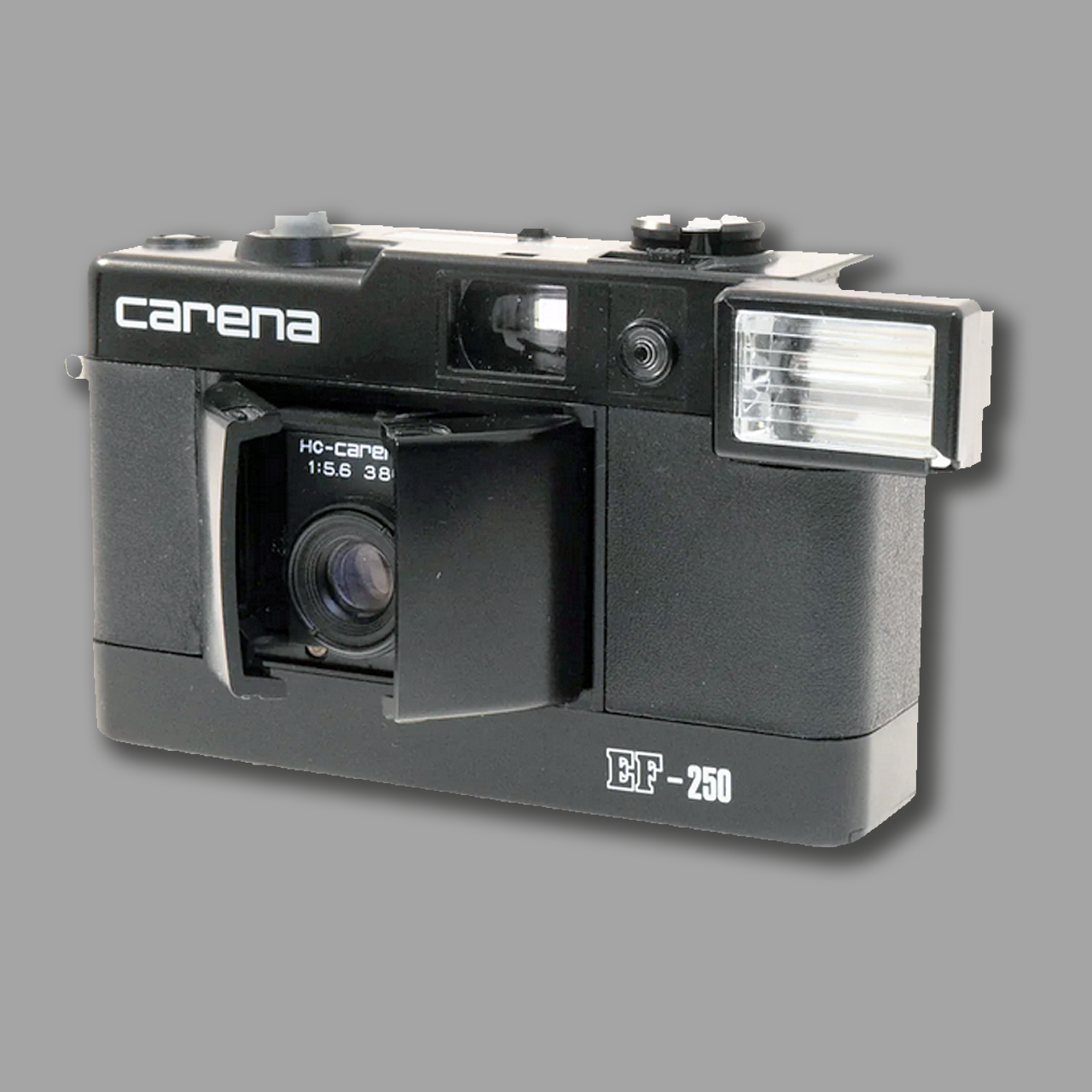
The Carena EF 250 is a 35 mm viewfinder camera from the 80’s. A similar model was sold as “Eumig UC 35” and “Porst 135 KE“.
35mm Carena SLR
- Carena Computer E
- Carena Computer Reflex
- Carena CX-300 (Two versions; made by Cosina)
- Carena CX-500
- Carena ICS 201
- Carena KS
- Carena KSM 1
- Carena KSM 2
- Carena Micro RSD
- Carena MS TL
- Carena SFL 2
- Carena SRH 500
- Carena SRH 760 (Petri FT 500)
- Carena SRH 1001
- Carena SMR 1000
- Carena SX 100
- Carena SX 300
- Carena 100 SX (=Cosina C1)
- Carena 1000
- Carena 1000 SX (=Cosina C2)
35mm Porst rigid
- Porst CM-135 Auto (= Cosina CX-2)
- Porst EL 300
- Porst EL 500
- Porst LK 500
- Porst SE 18 (Amica_Eyelux)
- Porst 135 C
- Porst 135 B
- Porst 135 BCS
- Porst 135 BS
- Porst 135 E Electronic blitz
- Porst 135 KE
- Porst 135 L
- Porst 135 S (Rangefinder based on Konica C35 series. See Cosina 35 Compact E)
Carena 110 film
- Carena 100 EF
- Carena 110 EF
- Carena Micro Flash 110
Porst 110 film
- Porst Instaplus pocket 110 EF
- Porst Pocketpak 1000
- Porst Pocketpak 2001
Carena APS film
- Carena AP 300
- Carena AP 600
- Carena AP 800
- Carena Metal X
- Carena Vectis X
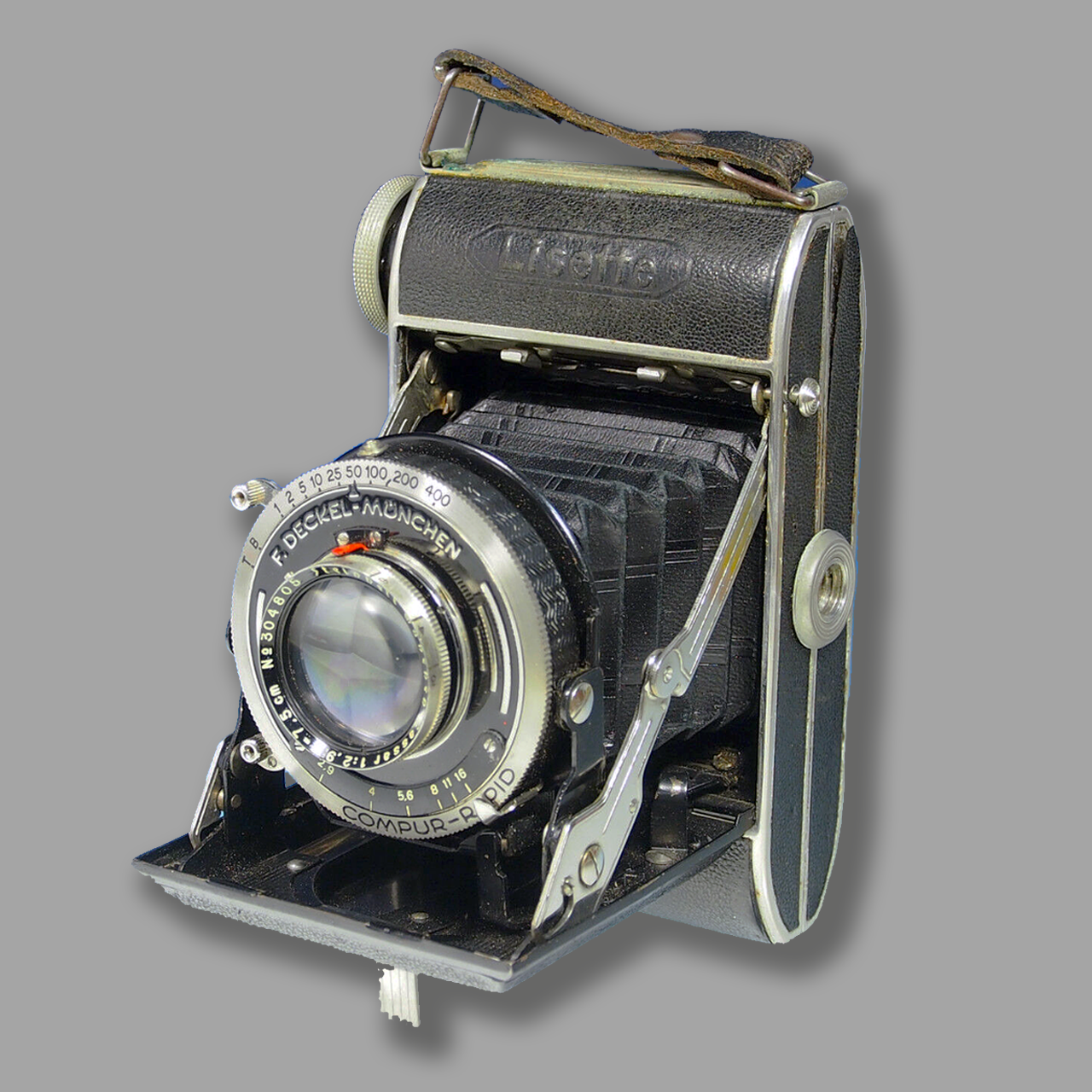
The Lisette is a Balda Baldax 6×4.5 strut folder roll film camera, distributed between 1934 and about 1938.
120 Hapo folder
- Hapo 3 (6×9 and 4.5×6), is a Franka Bonafix
- Hapo 3 (6×9 and 4.5×6), is first a Balda Fixfocus, later a Franka Rolfix
- Hapo 5 (6×9 and 4.5×6), variant of Franka Rolfix
- Hapo 10 (6×9), is first a Balda Fixfocus then a Balda Pontina
- Hapo 45 (4.5×6), is a Balda Pontina
- Hapo 50 (6×9 and 4.5×6), is an Adox Sport
- Hapo 66 (6×6), basically a Dacora I
- Hapo 66-E (6×6), is a Balda Mess-Baldix
- Hapo 100 (6×9 and 4.5×6), is an Adox Sport
- Lisette (4.5×6), is a Balda Baldax (prewar)
Porst 126 film
- Porst 126S
- Porst Automatic 500 (=Braun Automatic 300)
- Porst Automatic 501
- Porst Automatic 503 (=Dacora Instacora)
- Porst Automatic 504
- Porst Automatic 505
- Porst Feria 2000
- Porst Instapak 50
- Porst Instapak 100
- Porst Lucky
- Porst Photopak 50 (Inda FÉX)
- Porst Photopak 100 (=FEX-MATIC Cube)
- Porst Photopak 200
- Porst Photopak 220
- Porst Photopak 300
- Porst Photopak 320
- Porst Photopak 400
Carena 126 film
- Carena 126 Sport
127 Hapo rigid
- Hapomatic (4×4), is a Braun Paxina Electromatic
Carena Digital
- Carena DSC D-7
- Carena DSC P-6
- Carena DSC P-50
Porst subminiature
- Porst EX 55 ELECTRONIC mini-star (=Yashica Atoron Electro)
- Porst KX 50
Porst Instant
- Porst Magic 500 (Keystone Wizard XF1000)
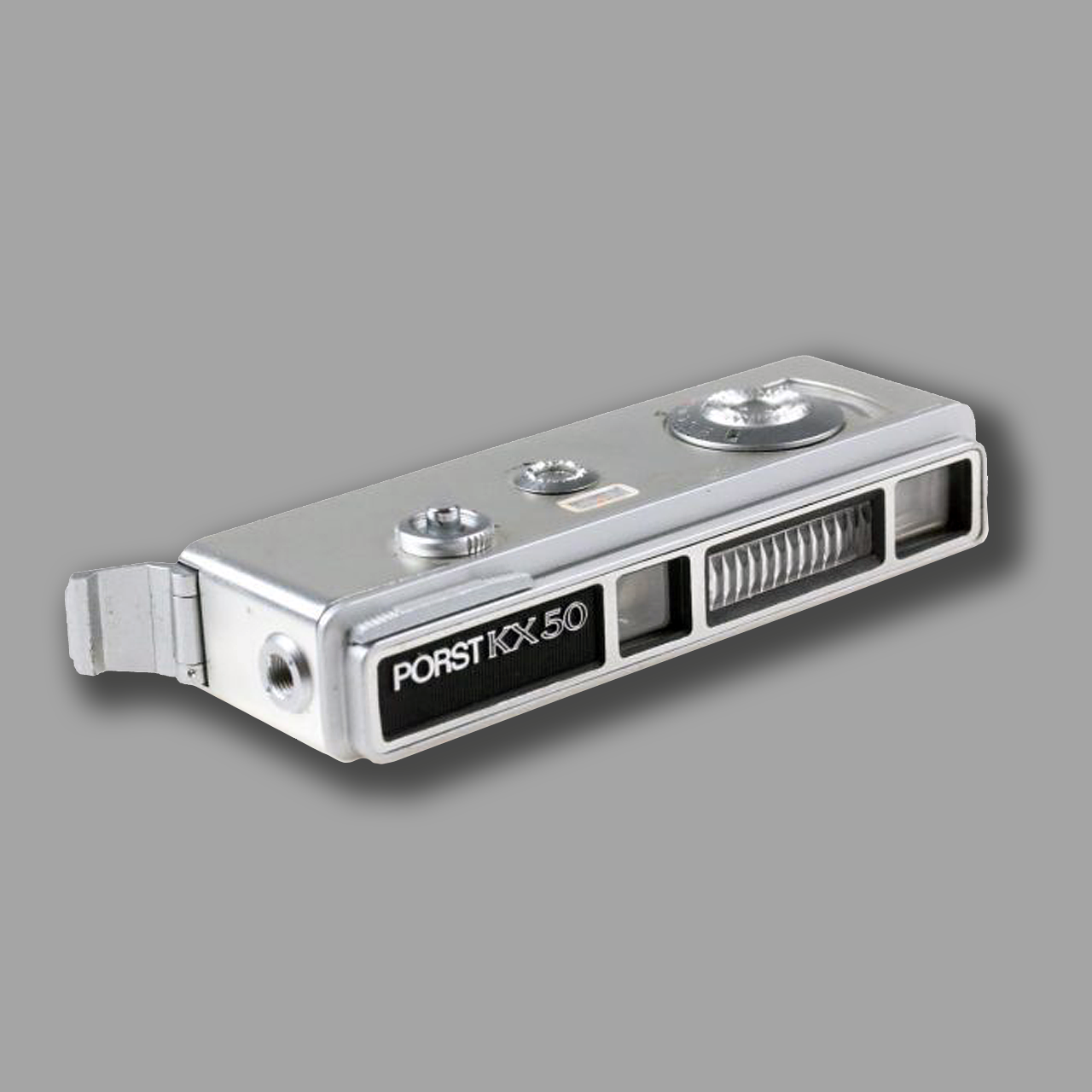
Porst KX 50 Miniature fixed-focus viewfinder camera in Minox format (8x11mm), identical to the Yashica Atoron.
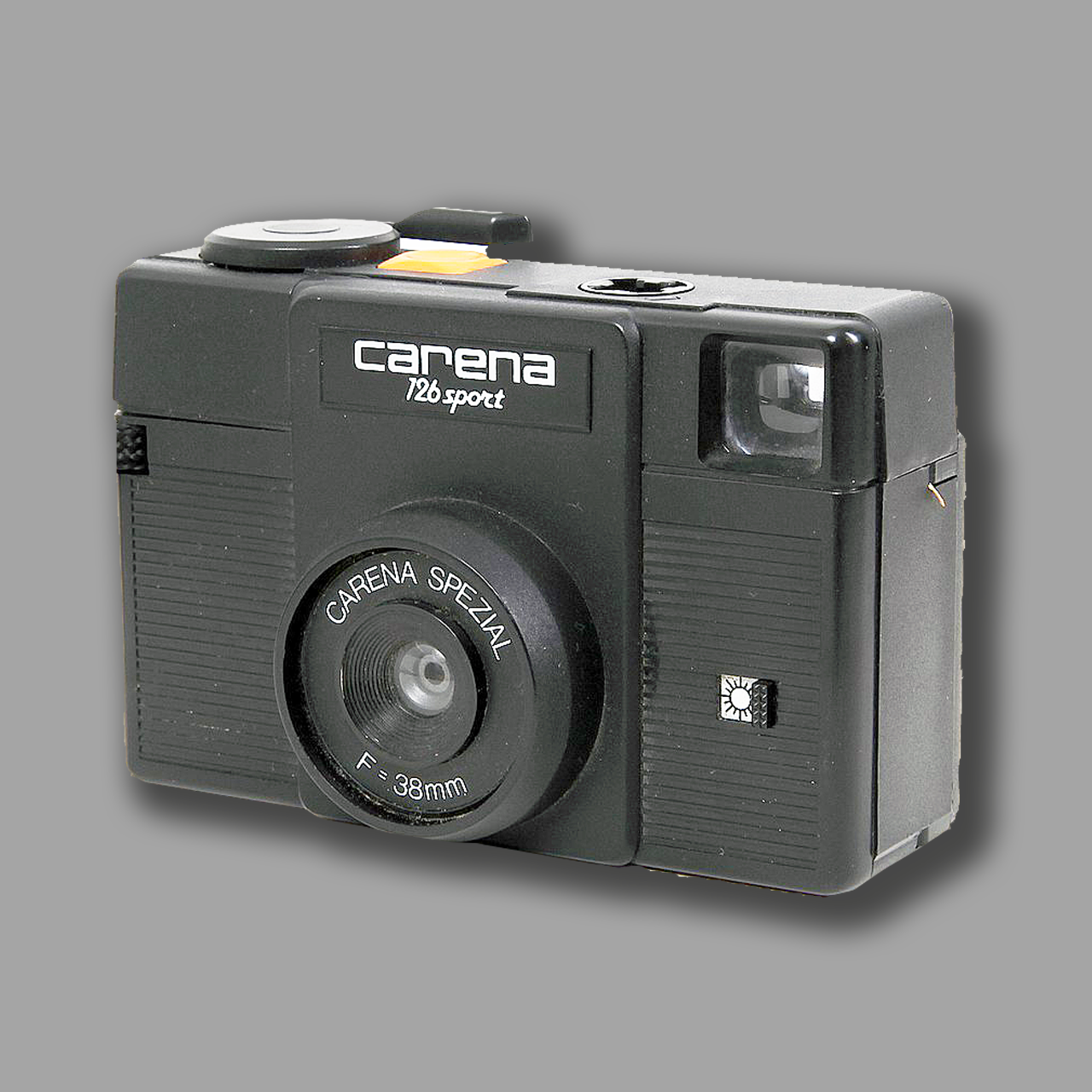
The Carena 126 Sport is a viewfinder camera, built in Singapore and sold by Photo Porst and presented in the 80s.
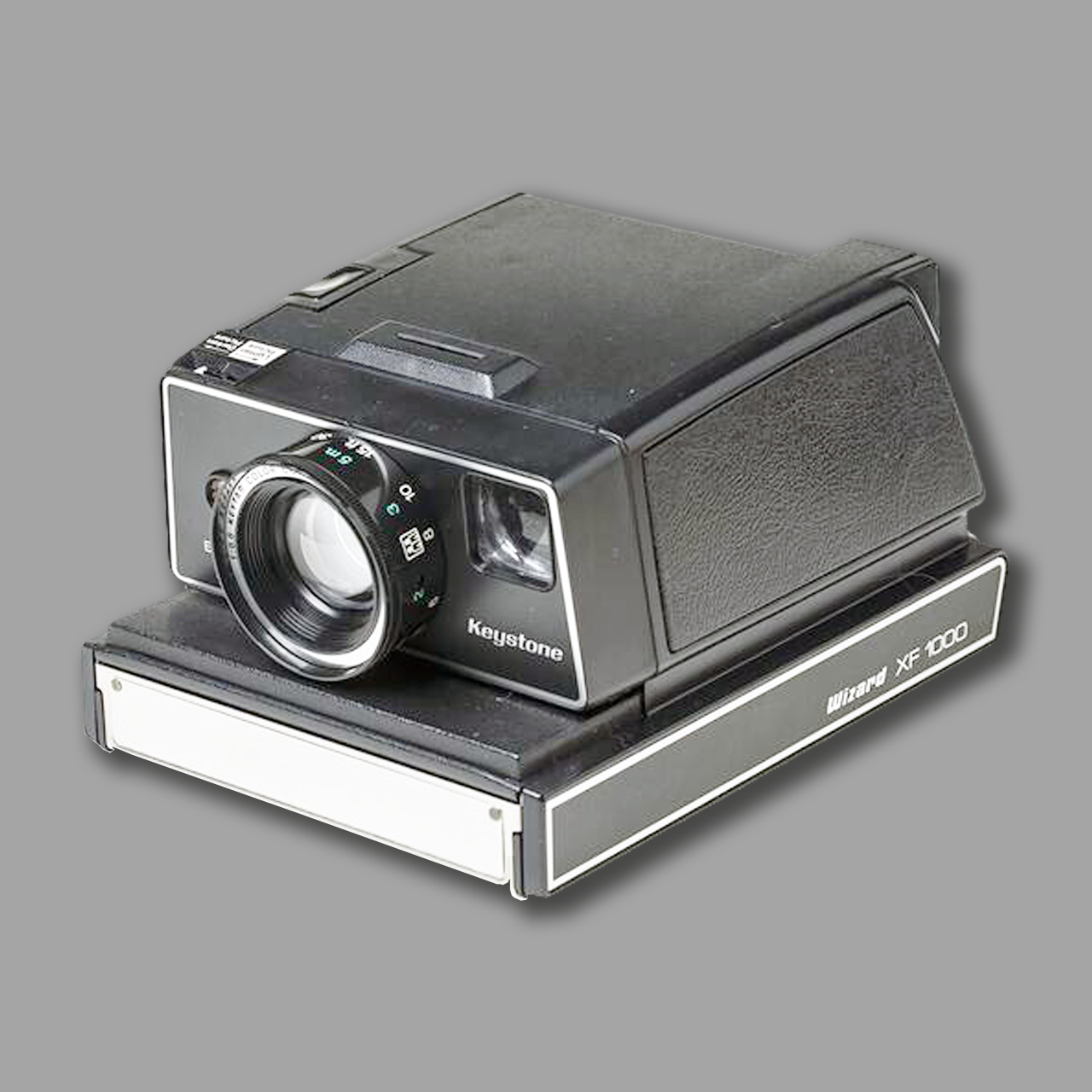
The Porst Magic 500 is an instant camera which was technically based on the Berkey Keystone Wizard XF 1000, circa 1975.
FOUNDING DATE: 1939
FOUNDER: Karl Pouva
COMPANY NAMES:
1939: Karl Pouva KG; 1972: incorporated into the Woldemar Beier Company; 1972: nationalized and renamed in VEB Kamerafabrik Freital; 1980: incorporated in VEB Pentacon; 1985: incorporated in the Carl Zeiss Jena combination; 1990: reprivatized and became Kamerafabrik Freital GmbH; 1990 OFE GmbH Freital (Betrieb für Optik, Feinmechanik und Elektrotechnik); 1992: Production ceased.
COMPANY ADDRESSES:
1930: Photoshop & studio in the Richard-Wagner-Straße area, Potschappel; 1940: Freital, Güterbahnhofstraße.
Karl Pouva, who was born in Deuben, writes an impressive chapter in local industrial history. His company’s, (Karl Pouva KG) main product was first the production of simple slide projectors and from 1951 on the company started with the production of a simple Bakelite viewfinder 6×6 camera: the Pouva Start, which would grow into a ‘cult’ camera.
 Born 120 years ago, on November 21, 1903 in Deuben, he initially trained as a lathe operator during the turmoil of inflation. The young man proves to be a solid skilled worker who, of course, has a mind for higher things. He has a field of activity in mind that gives him the opportunity to do something for the general public.
Born 120 years ago, on November 21, 1903 in Deuben, he initially trained as a lathe operator during the turmoil of inflation. The young man proves to be a solid skilled worker who, of course, has a mind for higher things. He has a field of activity in mind that gives him the opportunity to do something for the general public.
Somewhat familiar with photography, he opened a photo shop and studio in the 1930s in Potschappel, in the Richard-Wagner-Straße area. Pouva isn’t kidding. He sees the career change as a risky experiment with an uncertain outcome. However, he need not regret his daring step. He has every reason to be satisfied with the customer response.
In 1939 he turned to a new chapter. He founded the Apparatebau Karl Pouva KG. A small company producing with a metal projector developed by the company owner and exhibited at the Leipzig Fair.
The company could still produce 2,500 pieces at a selling price of 25 Reichsmarks each, then the Second World War sets the course. The company, located from January 1940 at the Güterbahnhofstraße, Freital (Saxony) , had to manufacture household goods.
After the war
When peace finally returns, Pouva surprises the public with projectors made from gas mask. A real contribution to the topic “Necessity is the mother of invention”.
In 1950 his next model came onto the market – the Pouva-Magica – a projector made of plastic. The Freital company produces 12,000 units in the very first year.
A year later, the restless man, who is rightly credited as an inventor, is again a topic of conversation. His 6 x 6 120 roll film medium format “Start” camera proves to be a big hit. It is a model with considerable utility value. To have, for an incredibly low price of 16.50 marks. The camera quickly gained popularity.
Acceptable results were obtained for this price, although, due to the simple lens, Duplar 1: 8, designed as a periscope lens, the uniform illumination of the image could only be moderate. The color shift in the edges of the images was due to the simple product.
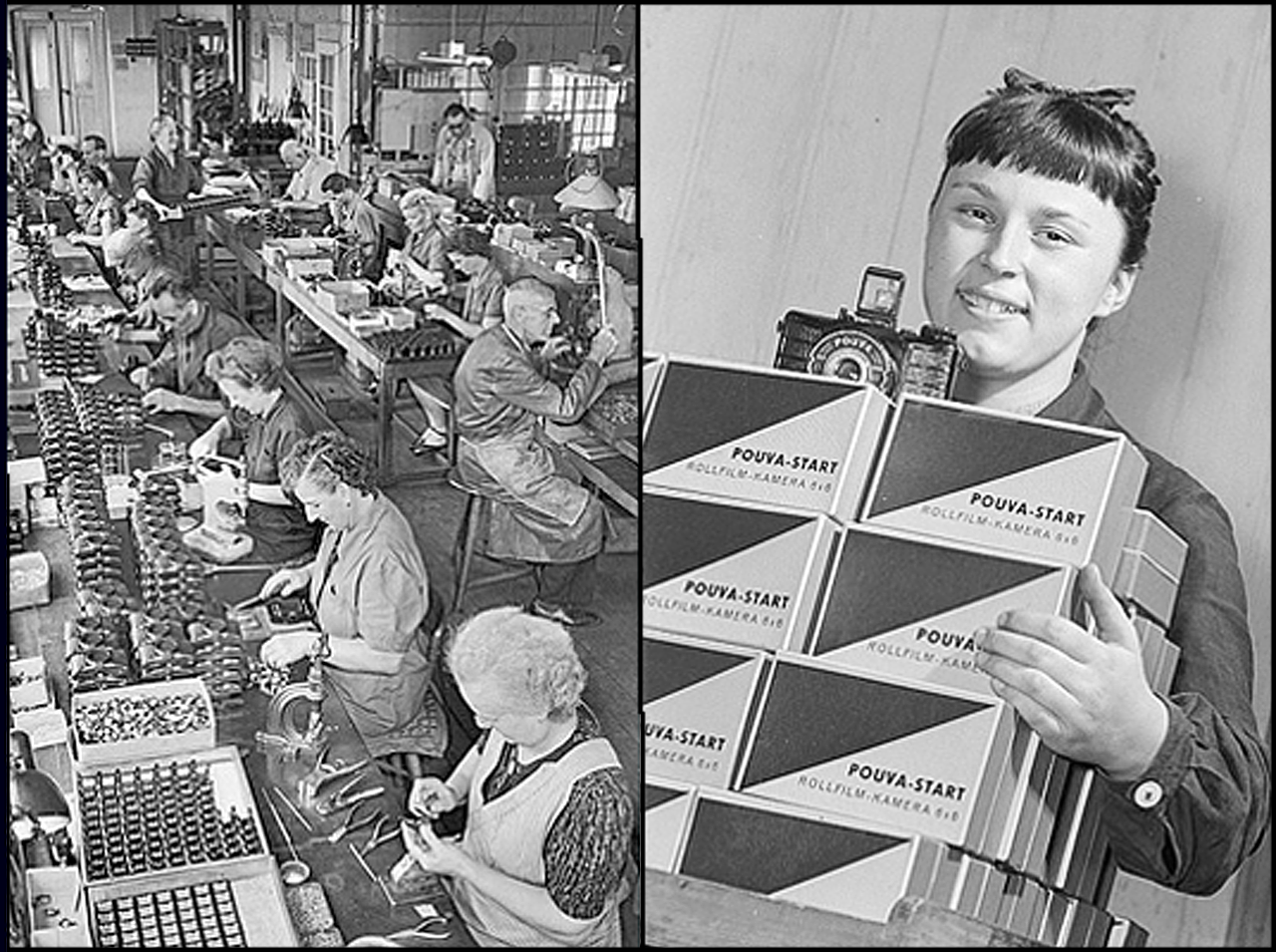
Two photos of the intensive production of the Start camera in the Pouva-Werke.
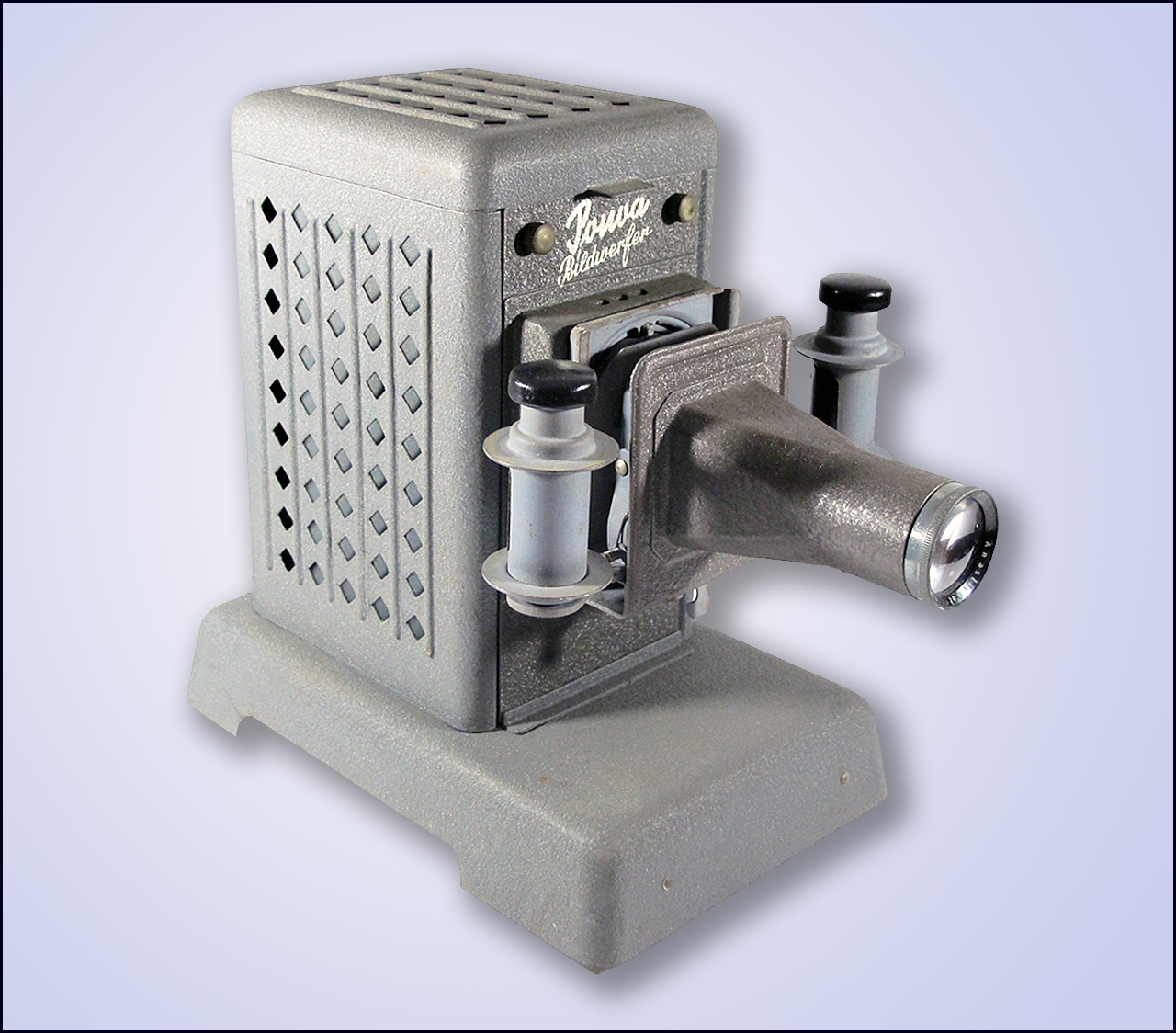
A metal Karl Pouva “Bildwerfer” (film projector) from the early days of the company.
The birth of a cult camera
There were four models of this camera produced between 1951 and 1973. This is probably the most iconic toy camera of that era. Young people of East Germany as a ‘cult’ camera have known it. In the West it was the Bakelite from behind the iron curtain.
Today collectors and amateurs around the world for the way it looks and works admire it. It is still widely accessible in various options, very often in perfect working condition and producing really good quality photographs.
No question – the launch camera is helping to revitalize photography, and not just around Windberg. The camera from Freital is also a bestseller in Scandinavia and Turkey. Slightly modified versions of the Pouva Start were produced and brought onto the market under license in Poland, Hungary and by Hama in the Federal Republic of Germany.
More Pouva products
In 1953, Pouva added the simple slide projector Pouva Magica made of black bakelite to its programme. This was a projector for 35mm slide films. A common 40 W general-purpose lamp served as the light source. This projector was produced almost unchanged for about 30 years until the 1980s.
 Karl Pouva had also developed a simple tape recorder called Bändi in 1963, which was not widely used due to the very uneven tape speed and is therefore less well known. Tapes from the Bändi could be played on all other half-track recorders at 9.5 cm/s speed – they had the same usual standards.
Karl Pouva had also developed a simple tape recorder called Bändi in 1963, which was not widely used due to the very uneven tape speed and is therefore less well known. Tapes from the Bändi could be played on all other half-track recorders at 9.5 cm/s speed – they had the same usual standards.
Karl Pouva had clearly taken on too much with his Pouva Bändi amateur tape recorder. The grandly advertised, comparatively inexpensive device was disappointing in principle in every respect. In the end, what was left of the whole euphoria surrounding the tape as a “tape for everyone” was a classification as a mechanical toy.
After all, Karl Pouva had registered four patents in this regard with the GDR patent office around the turn of the year 1963/64. But nothing helped: the drive with the uncontrolled DC motor caused major problems; despite the extensive patenting of Pouva’s design ideas in this regard.
Pouva was also clearly overwhelmed with the transistor amplifier circuit. However, it turned out to be complete overconfidence that Pouva even believed that he was capable of manufacturing the tape head himself. He only had the motor (Petrich) and the lead-acid battery (Quaiser) delivered to him.
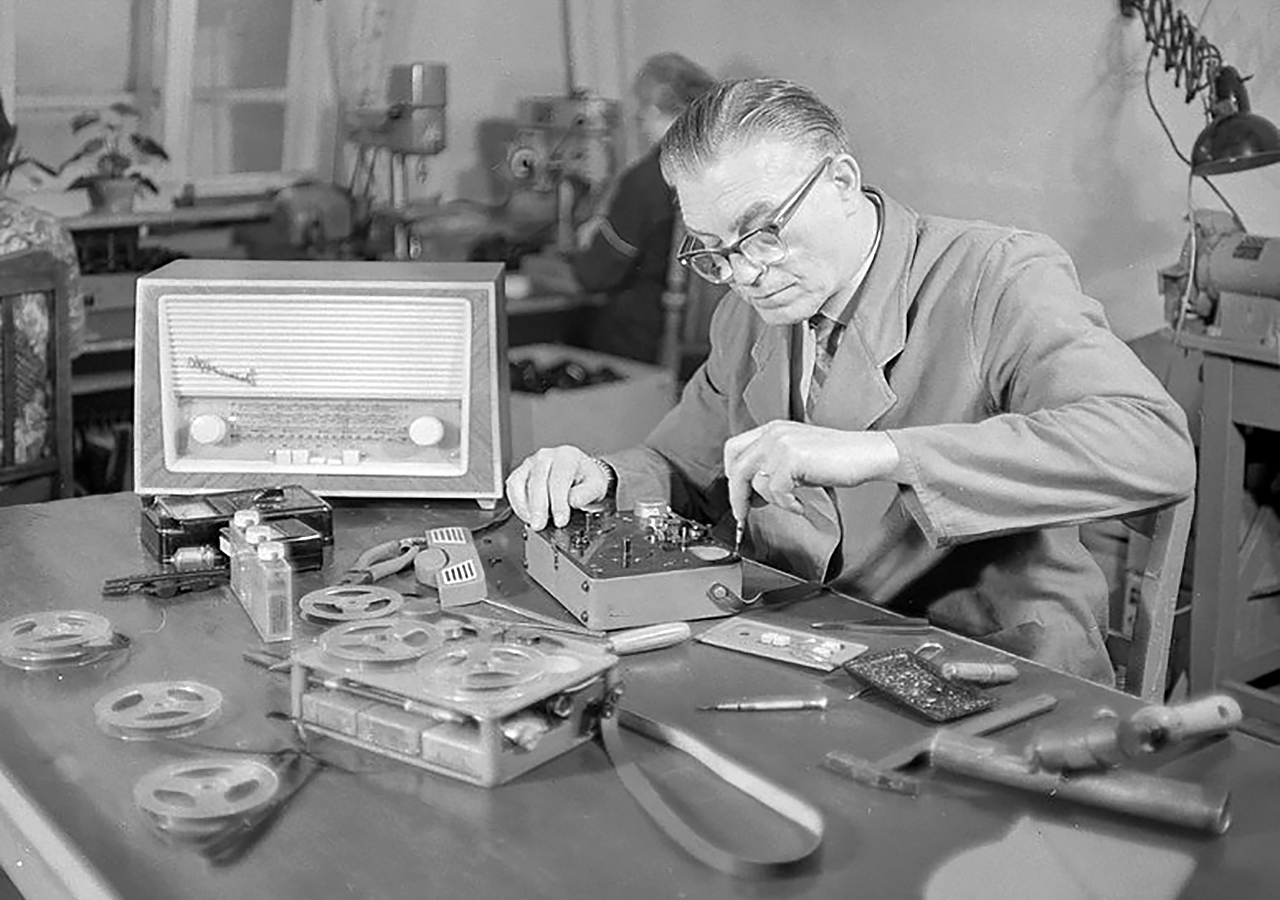
In this picture you can see Karl Pouva tinkering with his “Bändi”. The obligatory cigar is also included and a Pouva-Start back panel serves as an ashtray. Incidentally, the contemporary description of the picture indicates that Mr. Pouva wanted to call his magnetic recorder “Phoni” at the time.
An editorial comment from the magazine Radio und Fernsehen following Hagen Jakubaschk’s outright slating of the volume in his test report is therefore exceptionally candid for GDR conditions: “It doesn’t seem sensible to us that a manufacturer who hasn’t had any experience with the complicated magnetic sound technology should dare to tackle such a difficult task right away.”
Wilfried Erler, who is well acquainted with Pouva and works manager of the camera factory in Freital, puts the starting production between 1951 and 1972 at over 1,730,000 pieces. The Magica projector reached an output of over 1,292,000 pieces between 1950 and 1981. First place, however, goes to the successor to the first Pouva camera, the Start SL 100, a simple 34 x 36 mm tube camera with a quick-load system. Over two million pieces are produced and some are exported. Freitaler Apparatebau is also well in the running with the low-cost, mains-independent Bändi tape recorder, which the Deubener came up with in 1963.
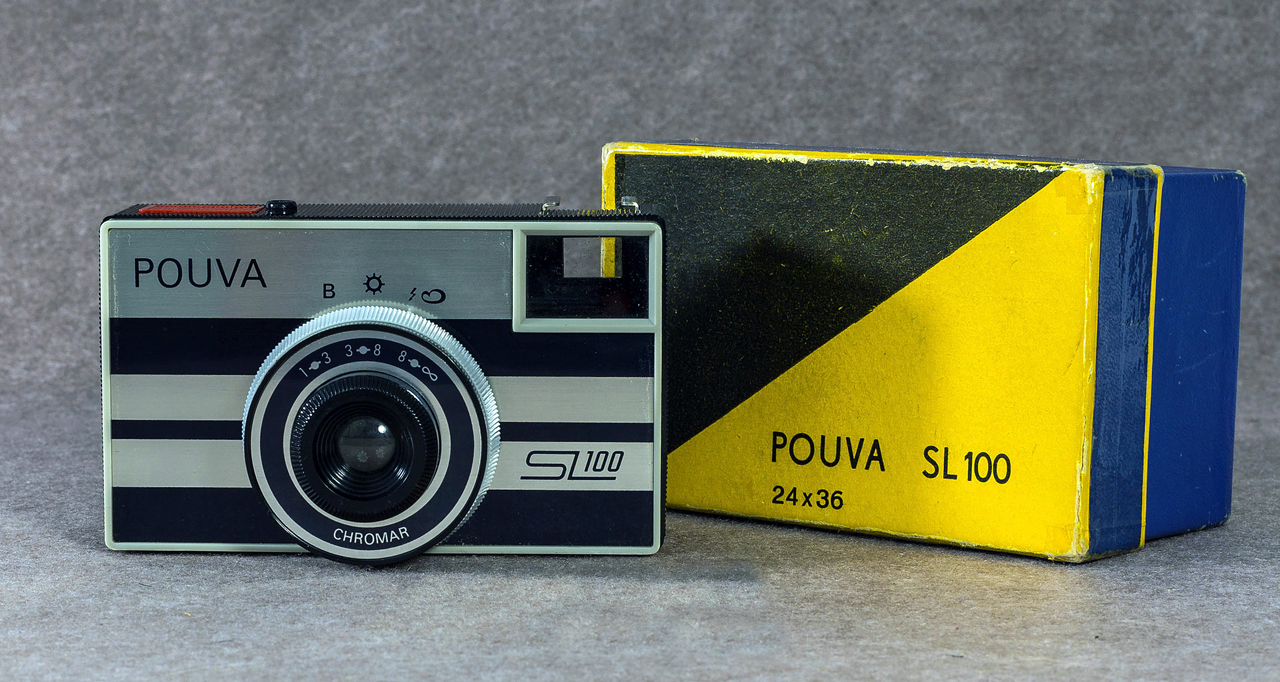
The Pouva SL100 is a simple plastic camera for ORWO SL film cassettes. This camera is the last model developed and launched by Karl Pouva together with Hanns Rühle. The entire camera, including the shutter, was made of plastic, enabling a low price and an extremely light weight. The Pouva SL100 is aimed at the undemanding user, he does not have to adjust anything on this camera except for sun and clouds. “VEB Kamerawerke Freital” is already stamped on the back of the camera as the manufacturer.
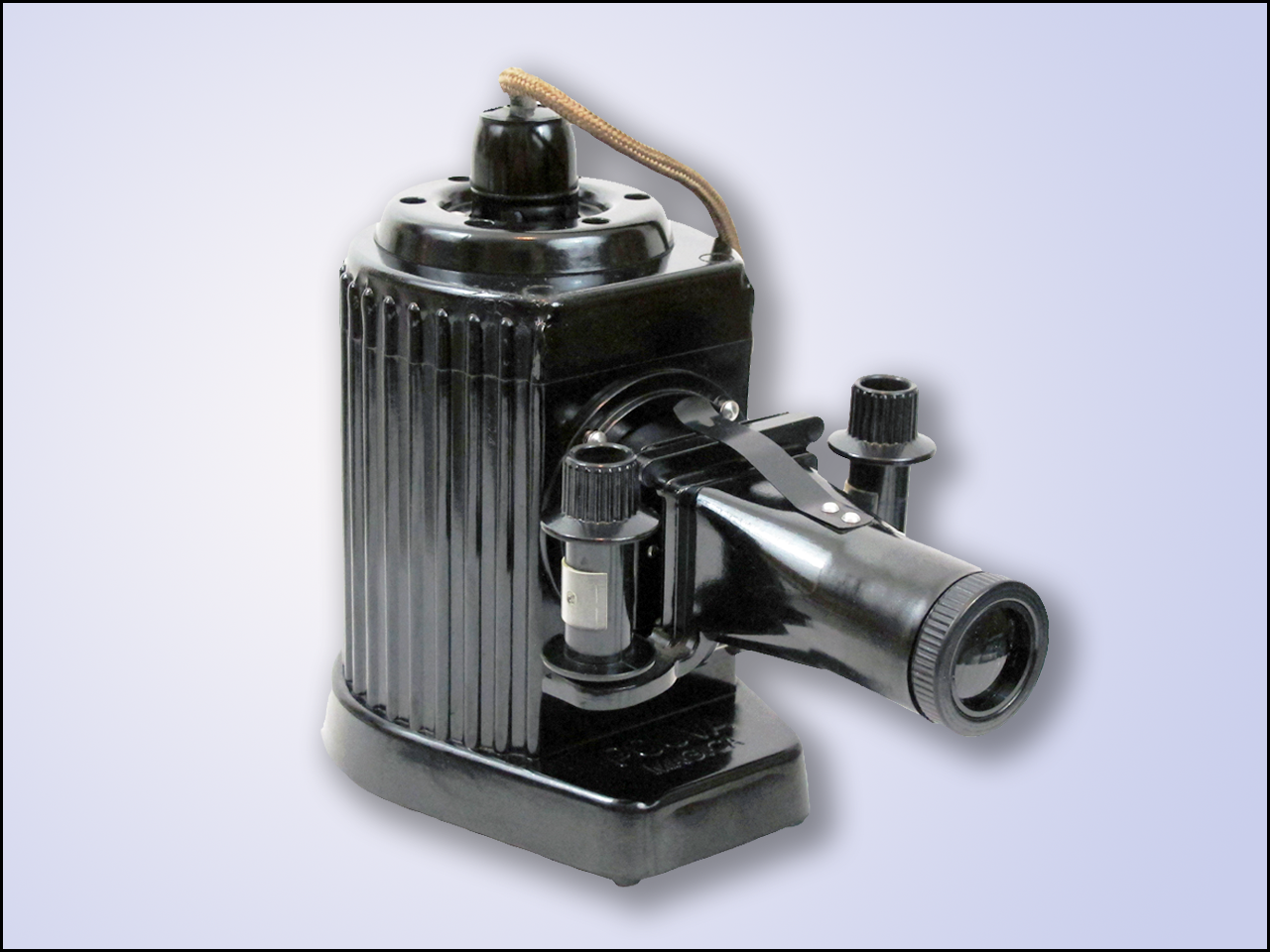
The bakelite Pouva Magica projector in all its glory.
The Pouva factory nationalized in THE Honecker era
Ultimately, however, the successes did not protect the company from state access: Karl Pouva AG was converted into “public property” after the change in leadership from Walter Ulbricht to Erich Honecker in 1972. Karl Pouva initially remained plant manager at “VEB Fototechnik Freital”. In 1973, the East German business leaders incorporated Pouva’s earlier company into the “VEB Camera Factory Freital”. Behind it was the “Camera Factory Woldemar Beier”, which had also been nationalized shortly beforehand, with which Pouva had had good contacts in the past: shortly before nationalization, both companies had jointly developed the “Pouva SL 100” camera, which later traded as “Beirette SL 100”. Due to the nationalization came the demand for new camera types. In the following period, five companies, among which the Karl Pouva plants were integrated into the VEB camera factory in Freital, whereby the camera production could now increase significantly.
From January 1, 1980 the VEB Kamerafabrik Freital was incorporated in the combination VEB Pentacon, which caused a new company name and structure. From 1981 the Beirette-Electronic 35mm camera with automatic timer was developed. In 1985, the company was incorporated in the Carl Zeiss Jena combination, so the membership of the VEB Pentacon Dresden ceased. At the age of 69, Karl Pouva retires from the management of the company after 33 years of hard and creative work. On January 16, 1989, the creative industrial captain reached his last hour in his hometown. Since then, museums have ensured that the results of his life’s work are preserved for posterity.
From July 1, 1990, part of the company was reprivatized. The rest became a GmbH called Kamerafabrik Freital GmbH. Gradually the camera production decreased and production only took place according to orders. From September 1, 1990 the company became OFE GmbH Freital, company for optics, precision mechanics and electrical engineering, until it finally came to an end on September 30, 1992.
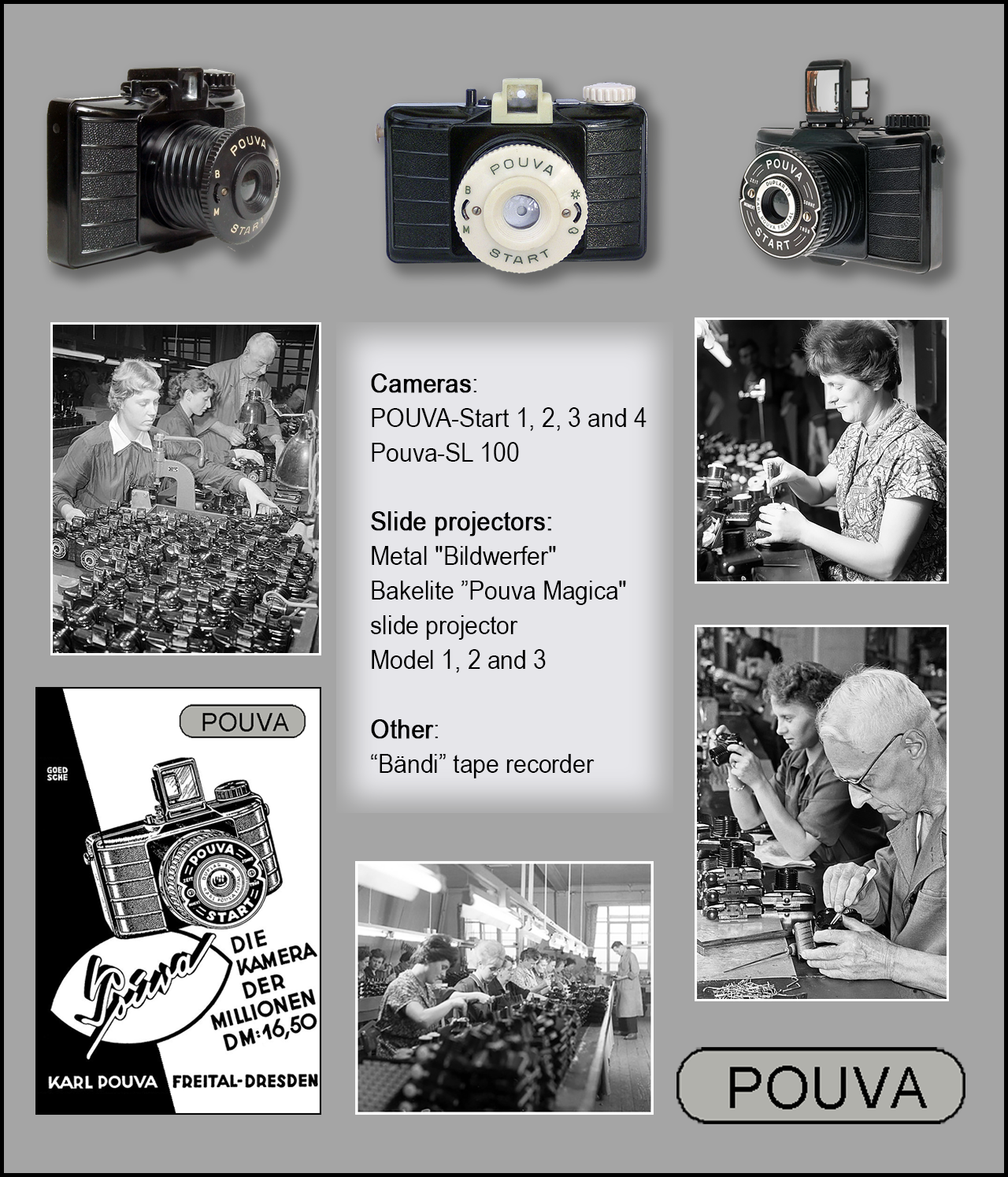
A brief overview of the products of Karl Pouva AG in the midst of an extensive photo impression of the activities that provided daily work and a steady income to many employees of the Pouva company.
1935: Purma Cameras Ltd.;
COMPANY ADDRESSES:
1935: Brock House, Langham St, London W1; 1945: Purma Cameras Ltd head offices were in Kirby St., William Barton Wood, London, 7 Queen St. Mayfair, London, then Sutton and later Glamorgan Hirwaun Industrial Estate. Rhigos, Aberdare. Glamorgan
The unique and most well known feature of the Purma cameras is that the shutter speed is determined by the way the camera is held. This focal plane shutter mechanism was invented by Alfred Croger Mayo who applied for a patent on 22nd September 1933, which was accepted on 24th June 1935. Cameras Purma made were marketed by Hunter (Speed and Special) and by Purma Cameras Ltd themselves (Plus).
 Purma Cameras were made by Purma Cameras Ltd, which was registered as a Private Company on 4th June 1935 by Alfred Croger Mayo and Tom Purvis. The name PURMA is derived from the letters of the founders PURvis and MAyo.
Purma Cameras were made by Purma Cameras Ltd, which was registered as a Private Company on 4th June 1935 by Alfred Croger Mayo and Tom Purvis. The name PURMA is derived from the letters of the founders PURvis and MAyo.
Tom Purvis is perhaps better known as a commercial artist who was responsible for many of the great LNER Railway posters of the 1930s, which can be seen in the National Railway Museum at York.
David Brock of Brock Fireworks gave financial help to launch the company in London. Their office was at Brock House, Langham St, London W1. The cameras of the Purma brand were 127 roll film viewfinder cameras with innovative gravity controlled shutters, based on the company’s patents of 1935 and 1936, designed by founder A.C. Mayo.
Original Purma patents were issued to A. C. Mayo of Richmond who was the designer of the camera. In the early 1940s Purma related patents were issued to Joseph Terrett and William Barton Wood of Sutton.
Purma cameras and accessories were distributed by R.F. Hunter of London from 1937, up to 1951. Production stopped in 1940 but the camera re-appeared after the war and was still being advertised in the early 1950s. From 1952 the distribution went to Purma Cameras Ltd, London, England and the cameras were made in Hirwaun Industrial Estate, Rhigos, Aberdare, Wales.
The cameras
 The first Purma camera, the Purma Speed, was introduced 1936. This is the first of three cameras brought out under the Purma name, each has distinctive styling although of different construction and made of different materials.
The first Purma camera, the Purma Speed, was introduced 1936. This is the first of three cameras brought out under the Purma name, each has distinctive styling although of different construction and made of different materials.
The Purma Speed was a metal-bodied camera with a six-speed shutter, 1/25-1/200 and a flip-up viewfinder.
The shutter design is similar between models and is odd in that the speeds vary depending on which way the camera is held (horizontal, upright with the finder at the top and upright with the finder at the bottom), a knob on the top of the camera switches between high and low settings.
The Purma Speed was only made for around a year, the price was 35/-.
 The most common, the Purma Special, introduced 1937, was made almost entirely of bakelite, apart from the glass lens, plastic viewfinder optics and shutter & spring mechanisms. The black bakelite case, the design of which has been attributed to the London office of Raymond Loewy, features an elegant, streamlined and very stylish trapezoid-shaped body, with a lens cap that conceals a telescoping lens.
The most common, the Purma Special, introduced 1937, was made almost entirely of bakelite, apart from the glass lens, plastic viewfinder optics and shutter & spring mechanisms. The black bakelite case, the design of which has been attributed to the London office of Raymond Loewy, features an elegant, streamlined and very stylish trapezoid-shaped body, with a lens cap that conceals a telescoping lens.
Raymond Loewy, the influential American designer known as ‘the Father of Industrial Design’, is often credited as the camera’s designer. More probably, however, the camera was the work of someone in Loewy’s London office, with input from Tom Purvis.
The Purma Special is very simple to operate. The wind-on knob is on the left (seen from the front); above the lens there is a lever that sets the shutter and the shutter release is recessed in a well on the camera’s right top. Sixteen square exposures could be taken on 127 film. The camera is fitted with a fixed-focus and fixed-aperture Beck anastigmat 2. inch (57mm) f/6.3 lens. Since this could only focus beyond about 20 feet (6m), supplementary lenses were available for close-up work. The lens barrel is spring-mounted.
A screw-on lens cap pushes the lens into the camera body and locks the shutter release to prevent accidental exposures. The simple eye-level optical viewfinder was made from a revolutionary new material called ‘Perspex’, making the Purma Special one of the very first cameras to use plastic optics.
What truly set the Purma Special apart, however, and prompted contemporary reviewers to comment on its ‘unconventional design’ was its unique focal-plane shutter. The camera has no external shutter speed selector. This is because it doesn’t need one – the shutter speed is determined by which way up the camera is held. The gravity-controlled shutter was invented by the company’s founder, Alfred Mayo, and patented by him in 1935.
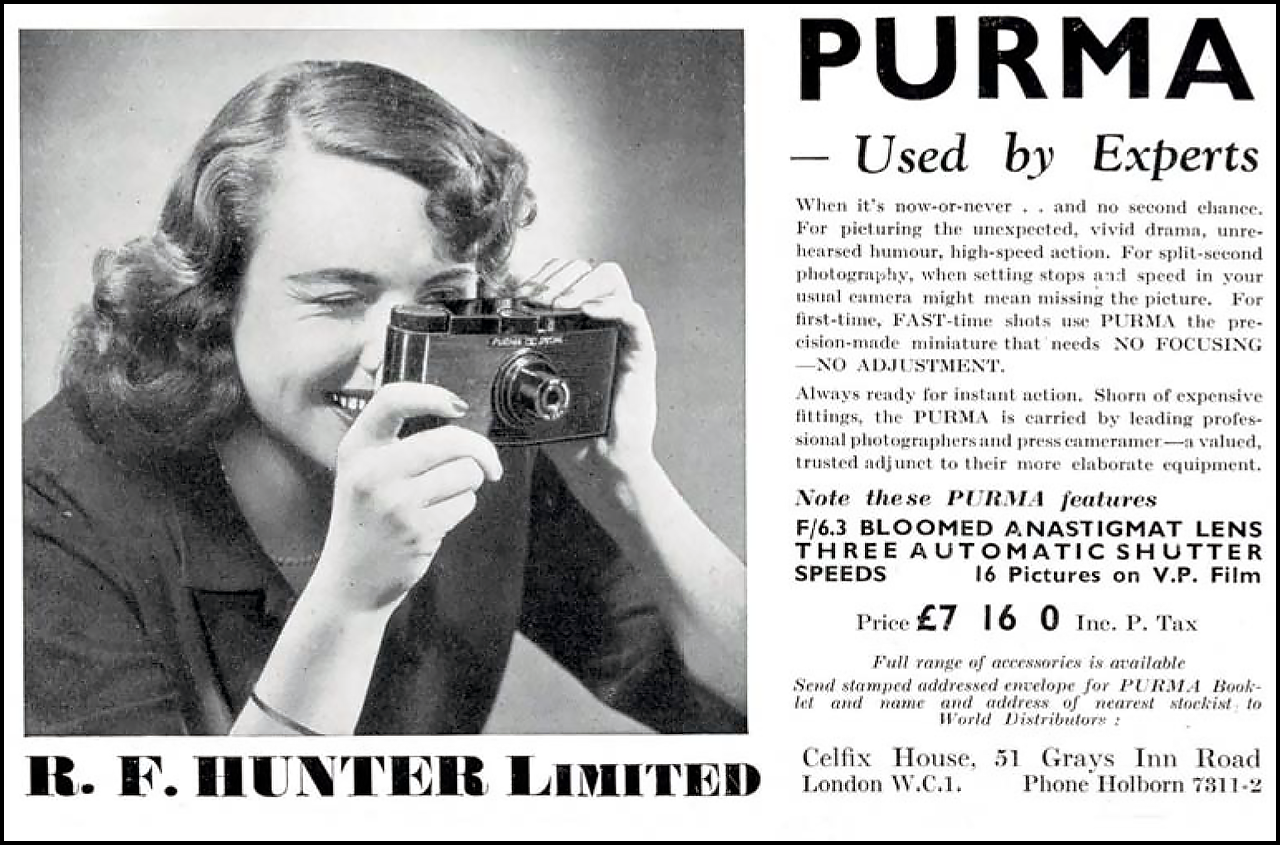
The Purma Special was marketed by R.F. Hunter of London from 1937 onwards. Production stopped in 1940 but the camera reappeared after the war and was still being advertised in the early 1950s.
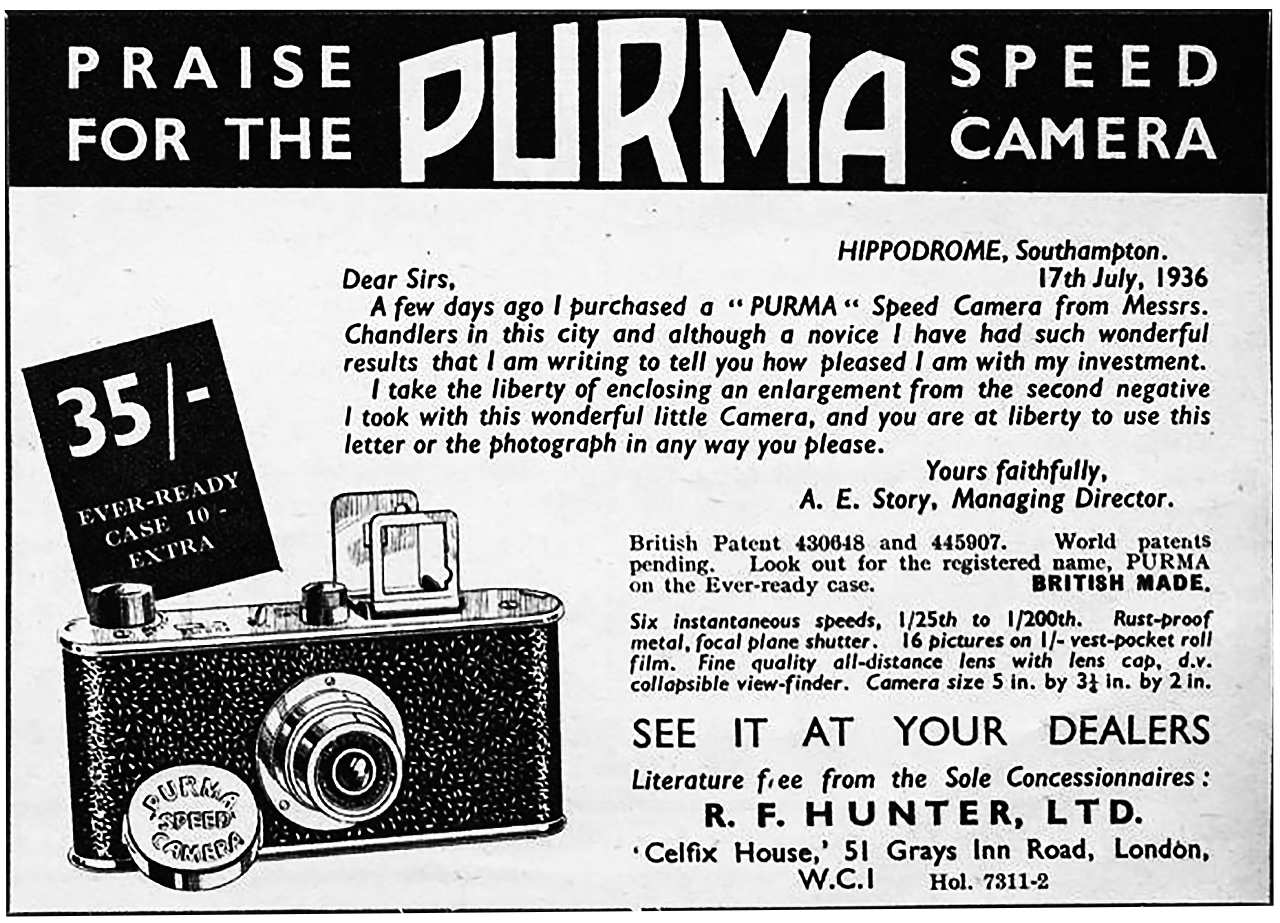
An advertising for the Purma Speed, 1936.
At its simplest, this is how it worked: a weight was attached to the shutter; when the camera was held horizontally, the shutter was pulled sideways by a spring, giving an exposure of about 1/150sec (medium). When the camera was held vertically in one direction, the weight added to the pull of the spring and reduced the exposure time to 1/450sec (fast), but when it was held vertically in the other direction, the weight acted against the spring and the exposure time was increased to 1/25sec (slow).
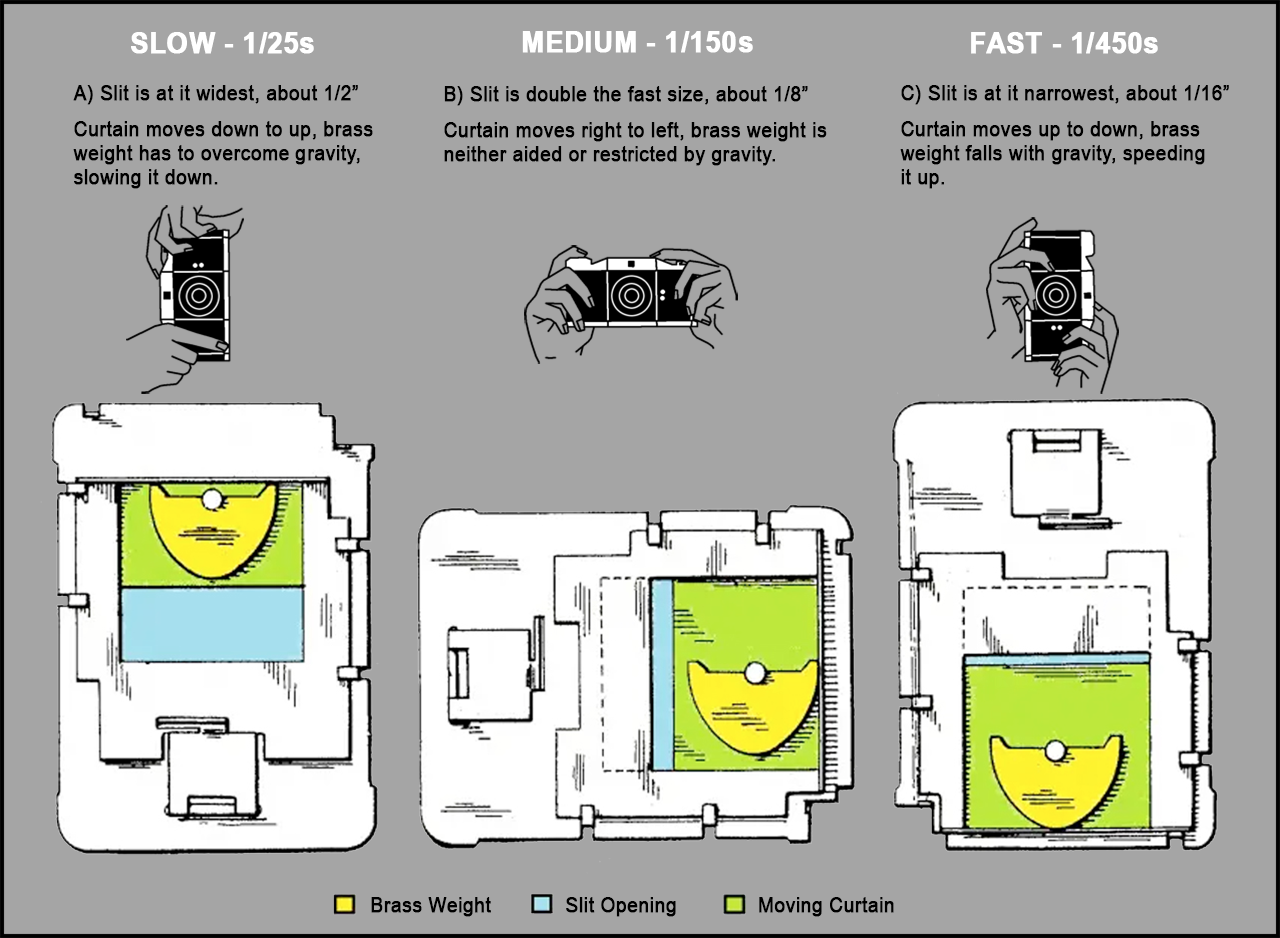
As a reminder to the photographer as to which way to hold the camera, the words ‘Fast’ and ‘Slow’ are moulded into the bakelite surrounding the viewfinder eyepiece. As a general rule, ‘fast’ was for bright sunlight, ‘medium’ for bright but not sunny and ‘slow’ for overcast. Since the negatives were square, changing the orientation of the camera had no effect on the picture format.
In 1954, a restyled version of the Purma Special, the Purma Plus, was introduced. This had a more angular, metal body rather than the plastic of the Special, but used the same gravity-controlled shutter. Less successful than its predecessor, the Purma Plus only remained in production for a couple of years. It was manufactured by Purma Cameras Ltd at their factory in Wales. The finish of the camera was very poor and few are now in good condition. The price reduced over time starting at £12.12.0 in 1952, £11.10.0 in 1953 and £7.19.0 in 1954.
. Three versions of the Plus were produced:
- Original with plain metal body.
- Second version (c. 1953) having a lens tube of constant diameter rather than a having a larger flange at its front. This model incorporated a safety lock to prevent the shutter from being released when the lens was retracted (i.e. when the lens cap was in place).
- A red plate carrying the Purma name was added to the face of the camera, and a small red plate carried the I, B markings surrounding the shutter release.
The Plus has several interesting features:
- The focal plane is curved, with a solid metal, curved focal-plane shutter with three speeds, controlled by a weight, which varied the slit-width. The shutter is cocked using a pear-shaped lever on the top edge, above the lens; the slit width/shutter speed depends on which way up the camera is held. Horizontal gives medium speed, vertical with winding knob down gives slow, and vertical, knob up, fast. See the Living Image site for photos of the shutter.
- The lens is sprung to telescope out of the body when the screw-on lens cap is removed. Capping (and so collapsing) the lens locks the shutter release – which, unusually, is on the photographer’s left.
- The ever-ready case opens upwards from underneath the lens, unlike most cases, which open forward from the back.
- The Purma was said to be the first camera to have plastic optics. In truth this was limited to the viewfinder optics, these being made by Combined Optical Industries Ltd, using “Perspex”. This same company produced plastic taking optics much later in 1959 with the Kodak Brownie 44A.
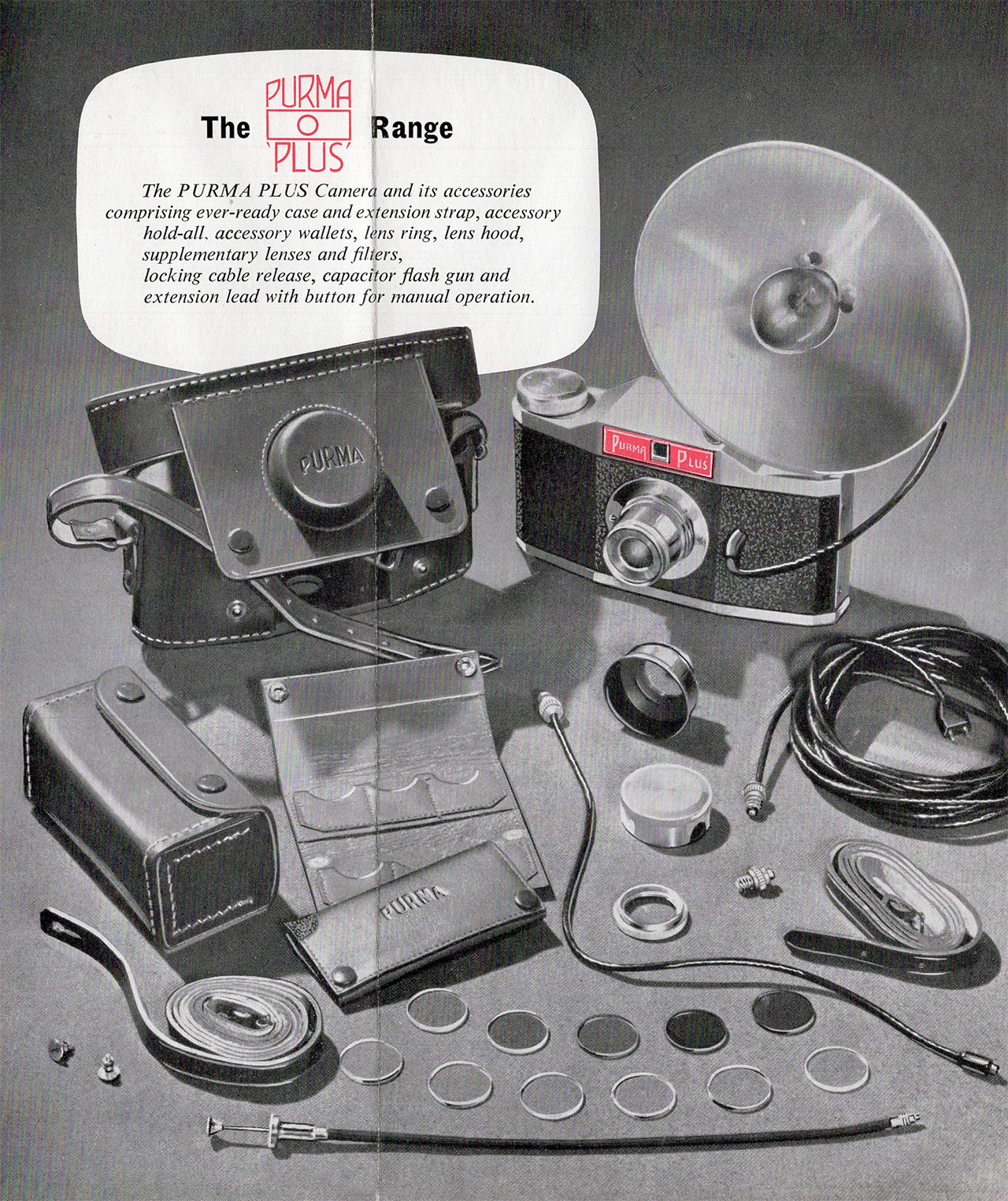
An advertisement in which the Purma plus with all its accessories is marketed.


